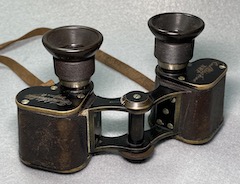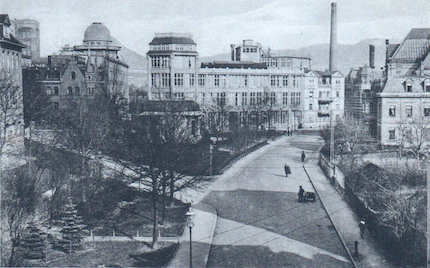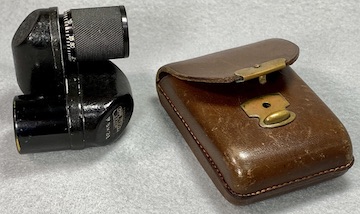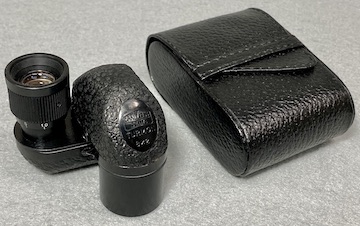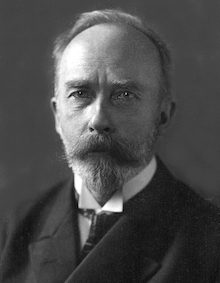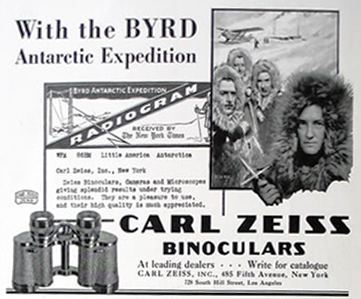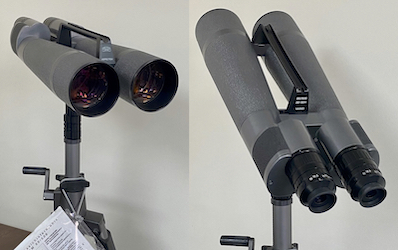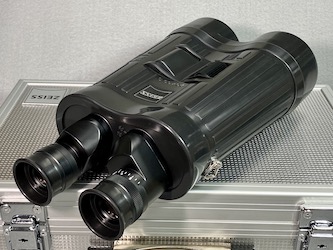Distribution
![]() Zeiss Index
Zeiss Index ![]()
![]() News
News ![]() Notes & Interesting Articles
Notes & Interesting Articles ![]() Pricing
Pricing ![]() Products
Products
![]()
![]() Warranty / Service & Repair
Warranty / Service & Repair


Carl Zeiss - A History Of A Most Respected Name In Optics
Preface: going on-line in 1994 this is among our first ever, and earliest on line articles about Carl Zeiss. It is written entirely with a simple text editor and hosted as another way of expressing our gratitude to those who have helped Company Seven prosper, and who have contributed (by donation or sale) to our museum exhibits.
With some of this content dating back to the times when slow dial-up Internet access was the norm, the article was originally text heavy because illustrations were by necessity kept simple and to a minimum. Over the decades we have, and will continue to, on occasion add this or that mention of or illustration of items in our archives and museum collection, this to break up the monotony of text, make corrections (with much gratitude to Dr. Wolfgang Wimmer, Director of Carl Zeiss Archives), clarify, or expand content. It was never our intent to write one comprehensive and all-encompassing history of Zeiss, that would require volumes to do it justice, but rather to explain why we at Company Seven remain grateful for and in awe of the achievements by the Carl Zeiss Foundation, and its companies.
To read this article in German, click this (Um diesen Artikel auf Deutsch zu lesen, klicken Sie hier) link to the Google Translator.
The Founders And The Zeiss Company Foundations:
From its inception through to the middle 19th century, lens making was a craft that was essentially passed on from generation to generation. Innovations had typically resulted from trial and error experimentation; this was a costly and time consuming process that could not factor in all of the possible variables in lens making materials and design. It would be left up to one who could employ scientific methods of study, and then devise the mathematical formulas to characterize the physics of optics to make the next important technological leaps possible. It would then be asked of a chemist to invent and manufacture those raw materials necessary to make the new designs possible. And it would be one man to bring this combination together to create a concern of unrivaled accomplishment.
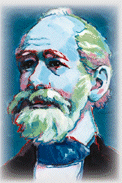 Carl Friedrich Zeiß (Zeiss) (b. 11 September 1816 in Weimar - d. 3 December 1888 in Jena) grew up in Weimar, but moved to Jena in 1834. These cities were then part of the Großherzogtum Sachsen-Weimar-Eisenach (Grand Duchy of Saxe-Weimar-Eisenach), of the Deutscher Bund (German Confederation); since 1990 they are in the State of Thüringia of Federal Republic of Germany.
Carl Friedrich Zeiß (Zeiss) (b. 11 September 1816 in Weimar - d. 3 December 1888 in Jena) grew up in Weimar, but moved to Jena in 1834. These cities were then part of the Großherzogtum Sachsen-Weimar-Eisenach (Grand Duchy of Saxe-Weimar-Eisenach), of the Deutscher Bund (German Confederation); since 1990 they are in the State of Thüringia of Federal Republic of Germany.
Right: Carl Friedrich Zeiss, (image size 23,218 bytes).
Mouse over the image to view a black and white photo taken earlier in his life (17,651 bytes).
In Jena he apprenticed in the shop of Dr. Friedrich Körner (b. 1778, d. 1848), who occupied a residential and commercial building at Grietgasse 10. While here, Carl Zeiss become well acquainted with the operation of fine tools and machinery that were used to produce microscopes and other scientific instruments. Körner was a machinist who provided such instruments to the German court. From the summer of 1835 to the winter semester ending January 1838, Zeiss attended lectures at the University of Jena where he studied mathematics, physics, anthropology, mineralogy, and optics; he completed his practicals (exams) at the Physiological Institute in Jena under Professor Schleiden. Ending his apprenticeship in May 1838 Zeiss traveled as a journeyman for some years, gaining more experience in the craftsman's shops in Stuttgart, Darmstadt, Vienna and Berlin.
Carl Zeiss had gained enough knowledge, experience and confidence that he returned to Jena on 29 September 1845 intent on building his own small business. However, in this era the administration required that prior to being licensed to do this an applicant had to prove residency and also prove competence in their chosen field. Being a student would provide the necessary prerequisite so Carl Zeiss so he enrolled in the University. On 10 May 1846 Carl Zeiss submitted the required application to the Weimar authority where he requested permission to open a mechanical workshop. His application and testing were completed, he was approved and issued the appropriate licensing and citizenship of Jena so he could proceed.
After his application was approved, on 17 November 1846 Carl Zeiss opened for business as “Carl Zeiss AG” The suffix AG is German for Aktiengesellschaft, that is German for joint-stock company, similar to a public corporation with stock holders in the United States. The first workshop was in a four story building located at Neugasse 7 in Jena, near the Saale River in the district of Thüringia in Germany. Here he commenced production of simple microscopes, measuring instruments, and other precise optical and mechanical instruments. In the first year of operation he sold twenty-three microscopes; not bad considering the state of the economy at the time and that his name was not yet well known.
In June of 1847 Zeiss had completed the move, as planned, to a larger facility at Wagnergasse 32. This three story structure would become, as was not uncommon in the era, both his residence and commercial shop location as well. It was then when Zeiss hired his first apprentice August Löber (b. 1830, d. 1912); Löber would contribute to the success and growth the C. Zeiss Jena company until retiring in about 1891. This shop was so well equipped that they were able to complete their first new microscope in September 1847. Among the customers of the budding concern was the University of Jena, for whom Zeiss made and repaired scientific equipment.
Carl’s first wife Bertha Pauline (nee Schatter, born 30 May 1827) gave birth to their son Roderich Zeiss (b. 23 February 1850, d. 4 September 1919) but tragically Bertha died at age 22 on the next day from complications of childbirth. Carl Zeiss married again, to Ottilie Trinkler (b. 28 December 1818, d. 22 August 1897) and their marriage of 1853 produced Karl Otto Zeiss (b. 25 February 1854, d. 6 October 1925) who would grow to become a medical doctor. Their other children were: daughter Hedwig Zeiss (b. 27 September 1856, d. 3 May 1938), and Sidonie Zeiss (b. 1 October 1861, d. 3 February 1920).
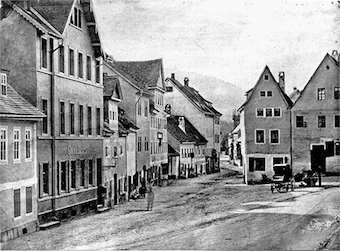 Zeiss began to make innovative improvements for his production microscopes and their accessories. Initially he was offering simple microscopes, but in 1857 Zeiss introduced their first compound microscope (employing both an objective lens and an eyepiece), this was designated the “Stand I”. In 1861 Zeiss compound microscopes are declared to be “among the most excellent instruments made in Germany” and he is awarded a Gold medal at the Thüringian Industrial Exhibition.
Zeiss began to make innovative improvements for his production microscopes and their accessories. Initially he was offering simple microscopes, but in 1857 Zeiss introduced their first compound microscope (employing both an objective lens and an eyepiece), this was designated the “Stand I”. In 1861 Zeiss compound microscopes are declared to be “among the most excellent instruments made in Germany” and he is awarded a Gold medal at the Thüringian Industrial Exhibition.
By 1864 the workshop, now with some two hundred employees, was moved to a third and even larger facility at Johannisplatz 10.
Left: the first workshop at Johannisplatz No. 10 to the left of the frame, bearing the name Carl Zeiss. Photo taken in 1867 (122,034 bytes).
Click on image to see enlarged view (261,467 bytes).
In 1866 the 1,000th new Carl Zeiss microscope is delivered. By this time the Carl Zeiss optics shop was becoming recognized throughout European scientific circles for the fine qualities of its microscopes and their accessories.
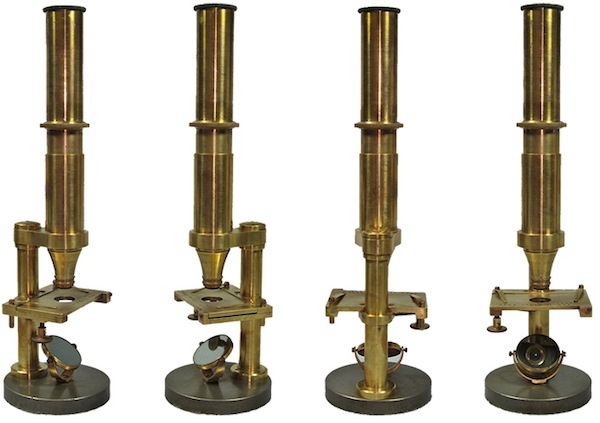
Above: Carl Zeiss Jena microscope Nr. 602/1291. The 1291st microscope, and their 602nd compound instrument made by Zeiss.
The smallest Zeiss compound microscope of the time, this is a stand Vb model with lens A or C and the eyepiece 2. This was delivered new in 1868
to Max Johann Sigismund Schultze, (March 25, 1825 - January 16, 1874) a microscopic anatomist noted for his work in Greifswald on cell theory.
From Company Seven’s collection, presently displayed at our showroom museum - and its clarity of view is still amazing (image 57,655 bytes).
Click on image to see enlarged view in png format (988,796 bytes).
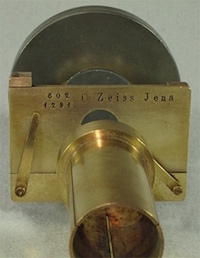 Company Seven has few resources in our archives to indicate whether or not Carl Zeiss had adopted any company trademark or not when the company commenced production. The earliest example we own of any item identified as having been made by Zeiss is the compound microscope shown above. This instrument does bear the simple “C Zeiss Jena” engraving on the slide Stage. On the Stage top and to the left of the company name are also engraved the microscope production and the series (compound microscope) serial numbers too.
Company Seven has few resources in our archives to indicate whether or not Carl Zeiss had adopted any company trademark or not when the company commenced production. The earliest example we own of any item identified as having been made by Zeiss is the compound microscope shown above. This instrument does bear the simple “C Zeiss Jena” engraving on the slide Stage. On the Stage top and to the left of the company name are also engraved the microscope production and the series (compound microscope) serial numbers too.
Right: C Zeiss Jena company trade name engraved on Stage of microscope Nr. 602/1291. Exhibited at Company Seven (47,426 bytes).
Click on image to see enlarged view in png format (106,586 bytes).
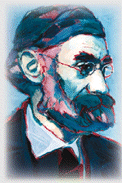 Ernst Carl Abbe (b. 23 January 1840 - d. 14 January 1095): up to this time advances in optical designs and materials relied heavily on inefficient trail and error efforts. Sometimes improvements, such as the discovery that a ceramic stirrer would be better than what was used up to then for example, came by accident. Some improvements resulted from others inventions; a new high temperature furnaces whose temperatures could be more precisely set and controlled became a vital component in making larger glass. The formulas of materials that would be melted together to form the desired glass tended to be trade secrets, or they might have been handed down to their successors. However, when some of these pioneers died likewise passed knowledge and experience.
Ernst Carl Abbe (b. 23 January 1840 - d. 14 January 1095): up to this time advances in optical designs and materials relied heavily on inefficient trail and error efforts. Sometimes improvements, such as the discovery that a ceramic stirrer would be better than what was used up to then for example, came by accident. Some improvements resulted from others inventions; a new high temperature furnaces whose temperatures could be more precisely set and controlled became a vital component in making larger glass. The formulas of materials that would be melted together to form the desired glass tended to be trade secrets, or they might have been handed down to their successors. However, when some of these pioneers died likewise passed knowledge and experience.
Left: Ernst Abbe (24,706 bytes).
Mouse over the image to view a black and white photo taken earlier in his life (12,901 bytes).
Realizing that the improvement of optical instruments demanded advances in optical theory Zeiss noted “the only remaining function of the working hand should be that of precisely implementing the forms and dimensions of all construction elements as determined by the design computation”. Carl Zeiss engaged Ernst Abbe (b. 23 January 1840 in Eisenach, Duchy of Saxe-Weimar-Eisenach - d. 14 January 1905 in Jena) as a free-lance research worker when he was a twenty-six years young lecturer of physics and mathematics at the University of Jena. It was Abbe who would become Zeiss partner and help launch the name Zeiss into the stratosphere of optics.
Many of those who would become the most successful minds in optics were taught at the University at Jena, and then employed at the Zeiss Works. Ernst Abbe was without doubt a most gifted individual whose accomplishments place him in that rare category of person who can be said to have a profound impact on the rapid evolution of many optical theories and products.
Abbe grew up in poverty, his father Georg Adam Abbe was a foreman in a spinning mill and worked as much as sixteen hours a day to support his family. Abbe earned his way through school in Eisenach by gaining scholarships, and with some assistance from his father’s employer. As an undergraduate Abbe studied physics and mathematics at the University of Jena (1857-1859). He went to graduate school at the University of Göttingen (1859-1861) where on 23 March 1861 he received a Doctorate in thermodynamics with the thesis “Erfahrungsmäßige Begründung des Satzes von der Äquivalenz zwischen Wärme und Mechanischer Arbeit” (Experiential Justification of the Set of the Equivalence between Heat and Mechanical Work). Abbe was employed for brief terms first as an assistant at the at the observatory in Göttingen, then the Physikalischen Verein in Frankfurt am Main (Physics Association in Frankfurt). In August 1863 Abbe joined the faculty at the University of Jena where he lectured on physics and mathematics, and later where he would serve his professorship. In 1866 Abbe was introduced to Carl Zeiss who was manufacturing microscopes and other instruments for clients including the University, Abbe became very interested in the optical challenges facing microscopy. Late in 1866 Zeiss and Abbe formed a partnership where Abbe became the director of research of the Zeiss Optical Works. Abbe laid out the framework of what would become the modern computational optics development approach. By 1869 their work produced a new patented illumination device, which provide illumination of the objects studied under a microscope in a manner superior to that of previous systems.
Among Abbe’s most significant breakthroughs was the formulation in 1872 of a wave theory of microscopic imaging that became known as the “Abbe Sine Condition”. This approach made possible the development of a new range of seventeen microscope objectives - three of these were of the immersion type, all were designed based on mathematical modeling. In Abbe’s words:
-
“based on a precise study of the materials used, the designs concerned are specified by computation to the last detail -
every curvature, every thickness, every aperture of a lens - so that any trial and error approach is excluded.”
As mentioned above, prior to the work of Carl Zeiss and Ernst Abbe lenses were made by trial and error and by repeating past proven glass and lens prescriptions. However, these objectives were the first lenses ever made that were designed based on sound optical theory considering the laws of physics. The comparatively high performance of the new Zeiss microscope objectives earned for the company international acclaim as an innovator capable of devising high performance optical products.
Abbe’s early ideas did not always advance the state of the art, one of his first calculated microscope designs proved to be inferior to that already being produced by Zeiss. This caused Ernst Abbe to redouble his efforts and resulted in his theory of image formation in the microscope, and formula for predicting the maximum achievable microscopic resolving power. This was so important an accomplishment that it was among the factors that led Carl Zeiss to partnering with Abbe on 22 July 1887, though this was backdated to 15 May 1875.
Calcium Fluorite (CaF2): since the first refractive lenses were made glass makers worked to improve glass consistency and to develop new glass types. Among transparent natural minerals evaluated were varieties of crystalline material Calcium Fluorite. Early opticians including Joseph Ritter von Fraunhofer (b. 6 March 1787, d. 7 June 1826) had found none of the crown glass types of their era could rival Calcium Fluoride for: low-dispersion, very low refractive index, wide spectral transmission, and this tended to weigh less than conventional glass.
But optical quality natural Calcium Fluorite was difficult to source. Optical lens fabricators were working to refine techniques to cut it without shattering it, then carefully grind and polish select small samples of Fluorite well enough to create lenses. We do not know exactly who was first to successfully make a lens of Calcium Fluorite, but it was likely first adopted for use in making microscope objectives. Even more challenging would have been to make one that still worked a year or more later.
Charles A. Spencer (b. 1813, d. 28 Sept. 1881) was manufacturing microscopes by 1839, and from 1854 to 1873 he also produced achromatic refracting telescopes and other related instruments. By the late 1850s he was working to improve his microscopes objectives. He devised at least one ¼-inch model that incorporates a Calcium Fluorite element; this five element objective was certainly in production by 1860. So Spencer may have been the first to successfully incorporate Fluorite in production optics. There are reports of a Spencer 1/18 immersion objective that were still considered to be corrected as well as those that would be produced decades later by Carl Zeiss and branded Apochromat. Interestingly enough, these objectives were not termed Apos by Spencer regardless, they earned Spencer international acclaim and were considered the best in their class by many. There are some of these surviving today that, if they have been cared for reasonably well, do remain functional.
A fire in the fall of 1873 destroyed the Spencer factory at Canastota. In 1877 he founded a new company “C. A. Spencer & Sons” making microscopes that would earn Spencer more international acclaim, including a Grand Gold Medal, the highest award at the Paris Universal Exposition Exposition Universelle of 1878. After his death the subsequent Spencer Lens Company would later be acquired by American Optical Company.
About twenty years after Spencer created his first high performance microscope objectives with Calcium Fluorite, Professor Abbe and Otto Schott too were studying the possibilities of using Fluorite. Their fabricators refined techniques to produce small Calcium Fluorite lens elements made well enough to create their first Fluorite oil immersion microscope objective lens, these were among their first optics for which Zeiss could justify using the characterization of “Apochromat”. Zeiss commenced to market these by 1878.
Prof. Abbe worked hard to disguise the name of this miracle glass, but the results spoke for themselves and this put Carl Zeiss Jena apochromatic microscope objectives in demand world-wide.
By 1879 there were four manufacturers who were rated by the microscopy community as preeminent in the field: C. A. Spencer and Sons of New York, Robert B. Tolles of Boston, Powell & Leland of England, and Carl Zeiss Jena in Germany.
However, unlike the proven Spencer microscope Calcium Fluorite objectives the first Zeiss microscope objectives with Fluorite lacked resilience: these could not endure humid climates, and tended to degrade just sitting in a cabinet if their desiccant was not recharged. Even modest impact might be enough to start a Fluorite element cracking. Aside from challenges of longevity, there were production hurdles that limited their practicality to very small elements.
Later Professor Abbe concluded:
- “Some of our first apochromats (but by far the fewest!) experienced some internal glass deterioration without external visible damage. The glass became turbid, the image fuzzy, the objective unusable. It turned out that some types of glass used in these systems - despite several tests in the laboratory - did not stand up in practical use.”
Consequently Prof. Abbe prompted Schott to develop new glasses that might more closely match the optical properties of Calcium Fluorite, but with manufacturing and longevity properties of glass. After numerous experiments Schott started to produce several Fluoro-Crown (or fluorine crown) glass types that enabled Professor Abbe to introduce new optics termed “Apochromats” during a July 1886 lecture at the Jena Society of Medicine and Natural Science.
The performance of Calcium Fluorite remained a gold standard in optics. But Fluorite could not be sourced in larger samples, and with properties (lack of impurities, homogeneity, etc.) good enough for making larger lens elements for photography or telescope. This would lead researchers to devise techniques after many decades of research, to actually manufacture (synthesize) Calcium Fluoride crystals.
In 1881 Dr. Roderich Zeiss, son of Carl Zeiss and his late wife Bertha Pauline, became a co-partner in the Zeiss concerns.
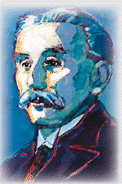 Otto Schott (b. 17 December 1851 Witten - d. 27 August 1935) grew up in a family that introduced him to making window glass, his father became a co-owner of a glassworks in Westphalia in 1853. He became the father of modern glass science and technology. Schott left home after gaining a masterly understanding of the state of the art to study chemical technology at the technical college in Aachen, and later at the universities of Wijrzbur and Leipzig. Schott later earned his Doctorate at the University of Jena in 1875 for his work about defects in window glass manufacturing. In late 1879, Schott wrote to Ernst Abbe describing his success in devising a technique to formulate a new glass that incorporated lithium, and later Schott sent a sample of this glass to Abbe. Schott’s work in his native town of Witten had by 1881 resulted in glass products with optical properties that up to that time had been unknown.
Otto Schott (b. 17 December 1851 Witten - d. 27 August 1935) grew up in a family that introduced him to making window glass, his father became a co-owner of a glassworks in Westphalia in 1853. He became the father of modern glass science and technology. Schott left home after gaining a masterly understanding of the state of the art to study chemical technology at the technical college in Aachen, and later at the universities of Wijrzbur and Leipzig. Schott later earned his Doctorate at the University of Jena in 1875 for his work about defects in window glass manufacturing. In late 1879, Schott wrote to Ernst Abbe describing his success in devising a technique to formulate a new glass that incorporated lithium, and later Schott sent a sample of this glass to Abbe. Schott’s work in his native town of Witten had by 1881 resulted in glass products with optical properties that up to that time had been unknown.
Right: Otto Schott (22,413 bytes).
Mouse over the image to view a black and white photo taken earlier in his life (18,219 bytes).
On 4 January 1881 Schott met with Dr. Abbe who encouraged Schott to employ a scientific approach to the determination of raw ingredients to be used in glass formulations, and the development of manufacturing techniques of what would lead to the development of more than one hundred new types of optical and industrial glasses. Together Schott and Abbe would also work to improve the raw materials mixing and glass annealing processes. In 1882 Schott moved to a new glass-making laboratory set up for him in Jena. In 1884 Schott together with Carl and Roderich Zeiss, and with Ernst Abbe,s founded the Glastechnisches Laboratorium Schott & Genossen to develop new types of optical and heat resistant glass. Later this later became the Glaswerke Schott & Genossen.
Schott developed many new glass types, a number of which are still in use including Borosilicate Crown that is also known as a BK glass. Schott’s glass innovation made possible the introduction by Zeiss in 1886 of their first “apochromate” lens, a lens with improved color correction. His company pioneered not only new glass types but improved their homogeneity, these lead to new applications and new markets including “Jenare Glass” a domestic glassware line, and glassware for laboratory and industrial uses. He would become involved with social concerns, being elected to city council of Jena where he served from 1896 to 1899.
This collaboration resulted in the Jena Glass Works of Schott becoming the prime source of glass and filter materials for Zeiss products. This research and development effort bore its first noteworthy fruit in 1886 when Zeiss marketed the first “apochromate” microscope objectives; this apochromatic microscope objective offered superior quality. Employing “fluorspar” elements this was the first use of crystal in an industrial optical application.
Ottos oldest son Rolf Schott was killed during World War I, so the family knew something of wartime loss. Otto Schott retired from his day to day activities at the glass works in 1926, and his surviving son Erich Schott who had come to work there some years prior, was promoted to head the company. Erich would lead the company through transformative years of the Depression, a second World War, and it's aftermath.
Landmarks And Transitions
By this time Zeiss microscopes and other instruments were well enough regarded to rate international representation. In the United States for example Francis J. Emmerich, originally at Maiden Lane by 1872, then Francis J. Emmerich & Son at 138 Fulton Street, New York City, and by 1889 at 43 Barclay Street, New York City, imported and distributed Carl Zeiss instruments during the 1880s until the death of the elder Emmerich in 1892.
The Zeiss company delivers its 10,000th new microscope! The founder Carl Zeiss lives to see this breakthrough, but soon afterward he died on 3 December 1888. This left Ernst Abbe as the sole owner of the company then with 250 employees and craftsmen.
In 1889 the Zeiss company publishes it’s Catalogue No. 28 describing their microscopes product line containing, per F. J. Emmerich Sr., “many new apparatus and improvements of importance.” He had some experience with an attempted fraud by Heinrich Hensoldt (b. 1856 - d. ca. 1918), and other attempts to pass inferior products on as Zeiss, so Emmerich went on to elaborate:
-
“I am of opinion that all makers should follow the example of Mr. Carl Zeiss, of Jena, whose name is distinctly engraved on every one of the objectives he produces, as from the way they are manufactured under the supervision of Professor Abbe, there cannot possible be an inferior article produced or delivered from his workshop. I may, however, add that every buyer should look out that he gets really the genuine article, and would caution him to beware of counterfeits.”
Flatteringly enough, counterfeiting of Zeiss products would continue even into the 21st century particularly when involving antique items or binoculars that resemble those made by Carl Zeiss Jena.
The Stiftung And Corporate Ideals
Abbe was interested in improving academic and research resources. His efforts resulted in the establishment of Institutes for Applied Physics and Applied Chemistry at the University of Jena. Abbe was also interested in social reforms culminating in the formation in 1889 of the “Carl-Zeiss-Stiftung” (Stiftung is the German term for an entity akin to a Foundation) to operate the various Zeiss concerns, with a mission to ensure the Zeiss firm follows the social vision of its founders. By 1889 there were some 350 employees and workers affiliated with the Zeiss company and foundation. The independence of the Carl-Zeiss-Stiftung was formalized in 1891 as Abbe (and later Roderich Zeiss) bequeathed his shares in the Zeiss Optical Works factory and the Schott Glassworks to the Stiftung.
The original constitution of the Stiftung provides that the profits of the Zeiss firms finance the growth and stability of the firms. The remainder of the profits are allocated to the foundation, that makes grants for: scientific research, cultural activities, and employee benefits programs. The number of employees, craftsmen, and workers enjoying the working conditions at Zeiss had grown to 520.
Some 685 personnel celebrated the 50th anniversary of the founding of Zeiss in 1896. This was nearly double the number of people there just seven years before, and the employment rolls would more than double again to 1,450 by 1905.
By 1900 the employment benefits at Zeiss were uncommonly good in their day, these included: an eight-hour work day, paid holidays, some forms of health benefits, profit-sharing, and retirement. It is our understanding that one provision of the Stiftung Statutes was that the top salaries at Zeiss could not exceed the average income of the workers by more than a factor of ten. Such concerns of employees’ well being was rare at the time, but it was returned to the company with increased employee loyalty and by attracting better-qualified candidates for employment.
In 1923 Schott also added his shares in the Glass Works to the Foundation.
Optical Technology Innovations Blossom
As Zeiss had proved how math and physics played key roles in developing optics, and Carl Zeiss Jena attracted mathematicians (some attracted through Abbe’s teaching work) and physicists like a magnet. Zeiss was developing experience and expertise so quickly, and had access to innovations of glass technologies if not calling for new glasses to be made, so that their engineers could adapt to new requirements sooner than most others in the photographic market. If an engineer had been working on a new idea and came up against some limit regarding lack of a glass with certain properties then he might ask Schott to look into making a new glass. If the glass was not available until a decade or more later, then Zeiss archives and files might contain prior research work that would help someone else, if not the author, resume work when a new suitable glass was developed. Or, a shelved effort might be resurrected and applied to an entirely new optical product.
In Photography: photography too became a major factor in the increasing success of Carl Zeiss. There were many opportunities for new photographic products, especially since Kodak and others were marketing more manageable and simpler to use film cameras geared for consumers. A camera needed basic components: a lens (Zeiss designed and made these), a shutter mechanism (Abbe designed and patented), and film (no, Zeiss did not make that). Since every camera needed at least one lens this was a major market opportunity, and this is one that Zeiss came well prepared to meet. Zeiss developed lenses introducing them with names some that remain respected today by their modern descendants,
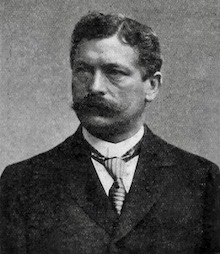 It was a Carl Zeiss Jena physicist, Dr. Paul Rudolph (b. 14 November 1858 - d. 8 March 1935), who led the effort to develop the world’s first anastigmat (or anastigmatic) lens. Every photo lens made prior to this would image in a way that photographs taken with them, under close inspection, would show one or more defects (termed aberrations in optics). The “anastigmat” was the first among a series of lenses designed for film photography that corrected astigmatism, coma, and spherical aberration. The correction of chromatism, false color that appears as a halo of violet or crimson where contrasting colors meet caused as wavelengths of light passing through glass are shifted, was less of a concern with shorter focal length lenses but improvements in glass technology to solve this in longer lenses would come later. The first of these anastigmat lenses was the Protar of 1890. This would be followed in 1895 with the Planar, the Unar of 1899, the Tessar of 1902 so sharp that it was marketed as the “Eagle’s Eye”, the Plasmat of 1918.
It was a Carl Zeiss Jena physicist, Dr. Paul Rudolph (b. 14 November 1858 - d. 8 March 1935), who led the effort to develop the world’s first anastigmat (or anastigmatic) lens. Every photo lens made prior to this would image in a way that photographs taken with them, under close inspection, would show one or more defects (termed aberrations in optics). The “anastigmat” was the first among a series of lenses designed for film photography that corrected astigmatism, coma, and spherical aberration. The correction of chromatism, false color that appears as a halo of violet or crimson where contrasting colors meet caused as wavelengths of light passing through glass are shifted, was less of a concern with shorter focal length lenses but improvements in glass technology to solve this in longer lenses would come later. The first of these anastigmat lenses was the Protar of 1890. This would be followed in 1895 with the Planar, the Unar of 1899, the Tessar of 1902 so sharp that it was marketed as the “Eagle’s Eye”, the Plasmat of 1918.
Left: Dr. Paul Rudolph (b. 14 November 1858 - d. 8 March 1935), photographic lens optical wizard of the Carl Zeiss Jena. Photo taken about 1895 (42,722 bytes).
Each innovation solved new problem or improved on performance over a prior generation; a lens might be developed for uses to cover larger and larger film formats, or a newer lens might allow faster focal ratios to shorten exposure time or reduce depth of field to increase artistic capabilities. For the consumer market a Zeiss camera or lens might have been their first introduction to the qualities of craftsmanship and performance there was coming from Carl Zeiss in Jena.
Zeiss had the means and the business acumen to know when it was time to compete, or time to acquire, and Zeiss also knew when to cooperate. By the turn of the century Zeiss lenses designs were so advanced and the name so well regarded that several of these designs were licensed by manufacturing companies overseas. Zeiss developed especially good relations with Bausch & Lomb of Rochester, New York, and Ross of London that would lead to cooperation in other areas too including binocular production.
Zeiss commenced making acquisitions to strengthen it’s position in the respective markets. In 1902 Zeiss acquired a local recent startup Palmos A.G. who was known for their Stereokamera and their Palmos 6x9 format camera, and this facility continued production as Aktiengesellschaft Camerawerk Palmos. The growth of opportunity was so extensive in the blossoming photography market that improved cooperation would be beneficial to sustain growth and innovation. So in 1909 and agreement was reached between four major German camera makers to form a new concern, Internationale Camera Aktiengesellschaft (ICA) based in Dresden. The shares of Ica were owned by the contributing companies who were:
- Camerawerk Palmos AG (Zeiss) in Jena
- Hüttig AG in Dresden
- Dr. Rudolf Krügener, Photochemisches Laboratorium und Fabrik photographischer Apparate Frankfurt-Bockenheim (Kamerawerk Dr. Krügener) in Frankfurt am Main
- Wünsche AG in Reick of Dresden
ICA products and literature were marketed as either Internationale Camera Aktiengesellschaft, ICA, Ica, or Ica-Contessa. In 1912 the G. Zulauf & Co. of Zurich joined the concern. Another well regarded manufacturer had entered into discussions, but the privately owned Heinrich Ernemann AG of Dresden elected to remain independent.
By 1914 Zeiss had become the world’s largest company involved in camera production with dozens of brands and factories, involved in production for that market at Jena, Dresden, and later in Stuttgart and Berlin. This would lead to great accomplishments and many innovative products bearing distinguished legacies, these would include Zeiss Ikon formed in 1926. The famous Contax brand would come about in 1932 under the tenure of Dr. Ing. Heinz Küppenbender.
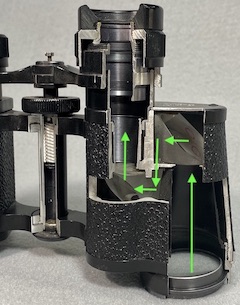 Binoculars and Porro Prisms: telescopic lenses gather light and form one image that is captured onto film or presented to an eyepiece. Because of how light is bent passing through the objective (front) lens the image appears upside down and rightsize up. It was about in 1850 when the original image erecting air-spaced paired Porro Prism was devised by an Italian Ignazio Porro (1801-1875). This invention presents a corrected image (rightsize up, and correct left to right). Furthermore, as the light path through the two prisms can take up a notable distance between the objective lens and eyepiece, this results in an instrument with a more compact form than traditional longer-barreled arrangements of that era.
Binoculars and Porro Prisms: telescopic lenses gather light and form one image that is captured onto film or presented to an eyepiece. Because of how light is bent passing through the objective (front) lens the image appears upside down and rightsize up. It was about in 1850 when the original image erecting air-spaced paired Porro Prism was devised by an Italian Ignazio Porro (1801-1875). This invention presents a corrected image (rightsize up, and correct left to right). Furthermore, as the light path through the two prisms can take up a notable distance between the objective lens and eyepiece, this results in an instrument with a more compact form than traditional longer-barreled arrangements of that era.
Among the first notable optical accomplishments by the Carl Zeiss works when by 1870 Abbe had independently reinvented his own image erecting Porro prism system, this is sometimes referred to as the “Porro-Abbe” design. By 1873 a working prototype instrument had been completed. However, due to the limitations imposed by the available types of crown glasses at the time, Abbe could not proceed with a producible design, so an improved crown glass was among Abbe's wish list items. By 1888 Schott improved the optical characteristics of crown glass to a point that Abbe resurrected the earlier project; by 1893 he had created and patented (back dated to July 9 at the German Imperial Patent Office) a 8x 20mm “binocular telescope with increased objective separation”. Abbe employed the improved glass prisms in an air-spaced arrangement, this in the form of the now traditional Porro binocular. The arrangement of two Porro Prisms allows for a wider separation between the two objective (front) lenses. This provides significant improvements over then competing designs, especially in that it resulted in markedly improved depth perception. This patent remained in force until 1908.
Right: Carl Zeiss Jena 8x 30 Deltrintem binocular cutaway, close up view of focus and hinge, right barrel with doublet achromat objective lens, prism housing, and eyepiece less these lens elements (37,850 bytes).
Note the paired Porro Prisms with one rotated 90° to the other in the prism housing, and the objective doublet lens. For clarity the simplified light path through the prisms is shown in lime green.
From Company Seven’s collection, exhibited at our museum.
Click on image to see enlarge view (81,199 bytes).
The production of Porro prism binoculars at Carl Zeiss Jena commenced in 1894 with their introduction of the 4x 11 mm, a 6x 15 mm, and 8x 20 mm models of their Feldstecher (binocular) series. Zeiss records indicate that over that first year of production they assembled at total of 205 binoculars. In 1895 Carl Zeiss Jena would introduce their 10x 25 mm, a greater diversity of models and their variants would follow.
Left: among the very earliest production Carl Zeiss Jena binoculars is this 4x Feldstecher, feldstecher being one of the terms in German for binocular (24,738 bytes).
From Company Seven’s collection, exhibited at our museum.
Click on image to see enlarge view (76,899 bytes).
Each binocular was furnished with a hard leather carry case, the flap lid that fastened to a post at front of the case. The binocular included a leather carry strap that fastened to strap loops that were, in early models, bolted to the left and right prism housings. The carry straps featured a slots cut through each end, these accommodate barbell-shaped fasteners; this leather straps and fasteners arrangement was adopted by other binocular makers but were discontinued by Carl Zeiss, Leica (Leitz), and most others the turn of the next century; however, suitable third party replacement carry straps remain available even today. The carry case too was furnished with a wider carry strap, with buckle arrangement suitable for varying overall length. Some carry cases also featured belt loops, but these loops tended to be more common for the military models.
- Carl Zeiss Jena branding,
- country of origin,
- no designation or Feldstecher, feldstecher being one of the terms in German for binocular,
- the magnification; the earliest models bear a simple number on the Bridge Cap (facing the observer) such as 4, or 6 and with a period to avoid confusing 6 for 9. Later early production binoculars may binoculars bear either Vergr.=4, Vergr.=6, or Vergr.=8 for example engraved on the right Prism Cover.
 The trade name applied onto the earliest production binoculars is “C. Zeiss, Jena”, and that is engraved on the left prism cover while the country of origin is engraved on the right prism cover. The labeling scheme was soon changed to “Carl Zeiss, Jena” and with the country of origin (D.R.P.) on the left prism cover, while the model designation and the magnification information were applied on the right prism cover.
The trade name applied onto the earliest production binoculars is “C. Zeiss, Jena”, and that is engraved on the left prism cover while the country of origin is engraved on the right prism cover. The labeling scheme was soon changed to “Carl Zeiss, Jena” and with the country of origin (D.R.P.) on the left prism cover, while the model designation and the magnification information were applied on the right prism cover.
Above right: the Carl Zeiss, Jena trade name applied in cursive script, with the country of origin referred to as D.R.P. (88,448 bytes).
Photograph of binocular manufactured in 1896, exhibited at Company Seven’s showroom.
The country of origin was referred to by the engraved letters D.R.P.*. Some binoculars were made specifically for distribution by a Zeiss office or retailer in a foreign country, so that binocular may bear the name and city of a representative in London or in Lisbon for example, a binocular may even bear the engraved name of the retailer who distributed it. Some binoculars were personalized, so in addition to the factory and retailer information a binocular may also bear an engraving of the owner’s name, possibly even an address too.
* The country of origin labeling is D.R.P., the abbreviation for Deutsches Reichspatent that literally translated to German Empire Patent. D.R.P. indicates the item was protected by a 15 year term patent filed with the Kaiserliche(s) Patentamt (Imperial Patent Office). This was the official document, legal within all German states, based on the Reichspatentgesetz law authorized on 25 May 1877 that went in effect 1 July 1877 until 1945. The item so labeled could have been manufactured by the patent holder, or it could have been made under license by some other maker. In 1919 the patent registration office became the Reichswarenzeichenregister (R.W.Z.R., for Empire Trademark Register), then in 1949 Deutsche(s) Patentamt, and after reunification this became Deutsches Patent- und Markenamt (D.P.M.A.) in 1998.
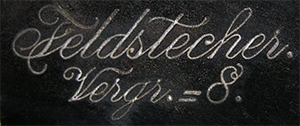 So their 8x 20 mm binoculars made for the civilian market in this era likely bear Feldstecher, and below that Vergr. 8.. In this era the markings did not indicate the lens diameter (aperture), that information is common on later production Zeiss and most other binoculars too and is expressed in millimeters.
So their 8x 20 mm binoculars made for the civilian market in this era likely bear Feldstecher, and below that Vergr. 8.. In this era the markings did not indicate the lens diameter (aperture), that information is common on later production Zeiss and most other binoculars too and is expressed in millimeters.
Right: labeling of a Carl Zeiss Jena binocular made in the mid 1890s era bearing Feldstecher and below that Vergr. 8. (111,390 bytes).
Up to this time the binoculars available in the marketplace were of the comparatively bulky and primitive Galilean optical arrangement, so as the newer and more compact Porro prism style binoculars made by Zeiss, Goerz, and others too came onto the consumer market they were sought after. But given the income of the average worker in the day, the cost of a new Zeiss Porro binocular could approach or exceed one month of wages. Civilians, military officers, and others with the means to afford it would acquire their own Porro binocular, and as their peers became acquainted with them then this too promoted more demand.
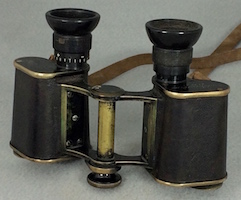 The military organizations in particular was a market niche for binoculars and one that could allocate funds, pretty much at will, to acquire equipment in some quantity; Carl Zeiss recognized this, and so he marketed to them and successfully negotiated contracts to provide them with Zeiss binoculars. The military binoculars manufactured by Zeiss in this era will bear a model designation with the prefix D. F., this is the abbreviation for Dienstglas Feldstecher; literally this translates into English as “field engraver”, but the meaning was more like ‘service glass binocular’.
The military organizations in particular was a market niche for binoculars and one that could allocate funds, pretty much at will, to acquire equipment in some quantity; Carl Zeiss recognized this, and so he marketed to them and successfully negotiated contracts to provide them with Zeiss binoculars. The military binoculars manufactured by Zeiss in this era will bear a model designation with the prefix D. F., this is the abbreviation for Dienstglas Feldstecher; literally this translates into English as “field engraver”, but the meaning was more like ‘service glass binocular’.
The first effort by Carl Zeiss to enter the military binocular market was the production of their ‘O.D.F. 95’, a 6x 15 mm made in 1896 specifically for officers; they were likely the only people in the military who could either personally afford to buy them or who had the clout to have them procured them through government channels.
Left: Carl Zeiss Jena O.D.F. MODEL 95, a 6x 15mm Offizier Dienstglas Feldstecher bearing military SN 2174, and production SN 2338 made in 1896 (24,349 bytes).
From Company Seven’s collection, exhibited with it’s original leather case (in amazingly good condition) at our museum.
Click on image to see enlarge view (85,313 bytes).
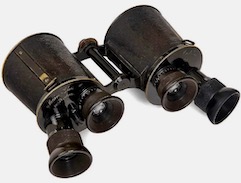 Carl Zeiss Jena was among the few companies to make this concept work when they introduced a new innovative binocular late in 1895, these are labeled “Marine-Glas”. This new binocular derived from their 10x 25 mm model, while both feature the same 25 mm objective lens the Marine-Glas is useable at 5x and by rotating the turret over each prism cover the user could dial another eyepiece in-line to operate at 10x. So the Marine-Glas prism covers bear the labeling “m. Revolver”, and “Vergr.=5 - 10”. They show 6.8° und 4° degree actual fields of view. The focus are individual, typical of marine models for better sealing, so to focus these the user would rotate each eyepiece to set them to suit. The binocular barrels are cylindrical and each incorporate the objective lens, prisms, and turret with eyepieces. The barrels are leather covered, in brown or black. While the tubes and body were constructed with nonferrous metals, largely of brass and so these are rather hefty at 1.2 kg. (2.6 lbs). The Marine-Glas were produced at Carl Zeiss Jena, and distributed through military and civilian channels through 1907.
Carl Zeiss Jena was among the few companies to make this concept work when they introduced a new innovative binocular late in 1895, these are labeled “Marine-Glas”. This new binocular derived from their 10x 25 mm model, while both feature the same 25 mm objective lens the Marine-Glas is useable at 5x and by rotating the turret over each prism cover the user could dial another eyepiece in-line to operate at 10x. So the Marine-Glas prism covers bear the labeling “m. Revolver”, and “Vergr.=5 - 10”. They show 6.8° und 4° degree actual fields of view. The focus are individual, typical of marine models for better sealing, so to focus these the user would rotate each eyepiece to set them to suit. The binocular barrels are cylindrical and each incorporate the objective lens, prisms, and turret with eyepieces. The barrels are leather covered, in brown or black. While the tubes and body were constructed with nonferrous metals, largely of brass and so these are rather hefty at 1.2 kg. (2.6 lbs). The Marine-Glas were produced at Carl Zeiss Jena, and distributed through military and civilian channels through 1907.
Left: Carl Zeiss Jena “Marine-Glas” underside perspective showing the cylindrical body, the turrets and the carrying strap loops. This image contributed by W. Werner as Company Seven does not have one of these among our exhibits (72,106 bytes).
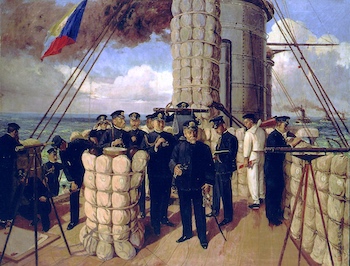 Years later a Marine-Glas earned some good international publicity for Carl Zeiss Jena. Admiral Marquis Tōgō Heihachirō (b. 27 January 1848, d. 30 May 1934) was the Commander-in-Chief of the Combined Fleet of the Imperial Japanese Navy who led the Japanese fleet to victory during the Russo-Japanese War of 1904-1905. The Admiral is depicted in a famous painting, and in statues too, holding his distinctive Zeiss turret binocular on the Compass Deck above the Bridge of the IJN Battleship Mikasa at the start of the decisive Battle of Tsushima in May 1905.
Years later a Marine-Glas earned some good international publicity for Carl Zeiss Jena. Admiral Marquis Tōgō Heihachirō (b. 27 January 1848, d. 30 May 1934) was the Commander-in-Chief of the Combined Fleet of the Imperial Japanese Navy who led the Japanese fleet to victory during the Russo-Japanese War of 1904-1905. The Admiral is depicted in a famous painting, and in statues too, holding his distinctive Zeiss turret binocular on the Compass Deck above the Bridge of the IJN Battleship Mikasa at the start of the decisive Battle of Tsushima in May 1905.
Right: Admiral Tōgō on the Compass Deck above the bridge of IJN Mikasa, at the beginning of the Battle of Tsushima on 27 May 1905. The signal flag being hoisted represents the letter Z, which was a special instruction to the Fleet. Painting by Tōjō Shōtarō (b. 1865, d. 1929). There is some artistic license here, no officer would wear their steel sword near the compass of a ship, this to avoid distorting it (72,106 bytes).
Click on image to see enlarged view (1,077,534 bytes).
The Admiral's Zeiss brown leather-covered Marine-Glas remains on public exhibit aboard the battleship Mikasa, a permanent memorial at Mikasa Park in Yokosuka, Japan. In 2017 the binocular was conserved by Carl Zeiss technicians, and on 5 July 2017 it was returned to the curators of the Mikasa by the CEO of Carl Zeiss, Ltd. (Japan).
Subsequently Zeiss obtained military contracts to deliver more 6x 15, and their 8x 20 binoculars, designated the ‘D.F. 6x’, and the ‘D.F. 95’ (8x), these commenced deliveries in 1897 with about five-hundred total being produced. Other very early Zeiss models made for the military may bear designations identifying the organization they were intended for, these include the ‘Fussartillerie D.F. 6x’ (Foot artillery 8x) exhibited at Company Seven.
As with rifles and many other military goods of the time, a model design finalized in 1895 might be in production for a decade or more. So a Model 95 binocular might have been manufactured in 1896, 1897 or even years later, the only way to date them is by their production Serial Number. The binoculars made by Zeiss specifically to fulfill for military use or for government contracts were similar to those made for the civilian market, these all tend to feature the more rugged Individual Focus (I.F.) mechanisms arrangement. The sales to this market became an important aspect, growing steadily by 1900 to about five times what were sold in 1897, and that helped Zeiss to prosper and to develop even more new products.
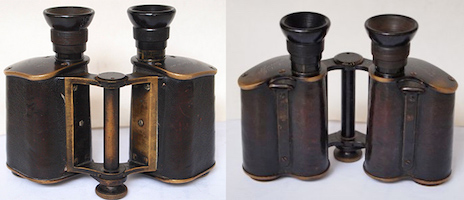
Above: Carl Zeiss Jena D.F. MODEL 95, an 8x 20 mm binocular of the model series made between 1897 to 1907 (107,641 bytes).
The military SN 1249 and production SN 6256 indicate this is among an estimated nine-hundred MODEL 95 contracted in 1897
out of a total production that year of about 4,161 binoculars made. Note the distinctive sloped prism covers.
From Company Seven’s collection, exhibited at our museum.
Click on image to see enlarged view (168,230 bytes).
 By the end of the 19th century Zeiss had negotiated limited partnership agreements or alliances with several manufacturing companies overseas. Among these was “Bausch & Lomb Optical Co.” of Rochester, N.Y., whom since 1892 had agreed to purchase components, and manufacture complementary optical products or copies of Zeiss product designs under license. This would become a triad after Saegmuller Company of Washington, D.C. was signed onto the alliance, by the Spring of 1905 Saegmuller would merge with Bausch & Lomb Optical Co. moving their facilities to Rochester. Consider that prior to the introduction of the Federal Income Tax in 1913 the United States government relied on income from import tariffs to generate much of its operating revenue. Sometimes having a product made or assembled within the country where it would be sold allowed the bypassing of expensive import tariffs.
By the end of the 19th century Zeiss had negotiated limited partnership agreements or alliances with several manufacturing companies overseas. Among these was “Bausch & Lomb Optical Co.” of Rochester, N.Y., whom since 1892 had agreed to purchase components, and manufacture complementary optical products or copies of Zeiss product designs under license. This would become a triad after Saegmuller Company of Washington, D.C. was signed onto the alliance, by the Spring of 1905 Saegmuller would merge with Bausch & Lomb Optical Co. moving their facilities to Rochester. Consider that prior to the introduction of the Federal Income Tax in 1913 the United States government relied on income from import tariffs to generate much of its operating revenue. Sometimes having a product made or assembled within the country where it would be sold allowed the bypassing of expensive import tariffs.
Left: Bausch & Lomb Optical Co. The Search-Light of Science advertisement published in 1899 featuring their “Zeiss Stereo Binocular Glasses” (54,670 bytes).
Click on image to see enlarged view (297,298 bytes).
These products were made well, they were marketed widely to the civilian consumer and industrial markets and to the U.S. military, and sold in such quantities that even today it is not uncommon to find a used binocular for sale bearing the engraving of “Bausch & Lomb Co.” as the maker, along with a reference to a Carl Zeiss Patent or Zeiss Prisms.
While the Zeiss Porro arrangement patent expired in 1908, the design had an appearance that for many decades later, after the patent expired, would be copied by many other makers of binoculars and these would be marketed as a “Zeiss type”, or “Zeiss design” binocular.
Porro and Zeiss Stereo Microscopes: the reputation of Carl Zeiss Jena originally was built on their production of microscopes. Over the decades Zeiss continued to improve them as the company advanced microscope technology, and Zeiss increased the diversity of their models and accessories. Stereoscopic microscopy, employing a pair of similar eyepieces with matching objective lenses, was first developed in 1671 by Cherubin d'Orleans. However, the d'Orleans arrangement reversed the image, with the left eye observing what was in the right barrel and so forth; confusing for many and limited by glass and design tech of the era. Decades later others attempted to produce stereoscopic images. Francis Herbert Wenham of London employed one objective feeding a beam splitter to fee two eyepieces; still not true stereo perception and with image qualities limited by glass tech of that era.
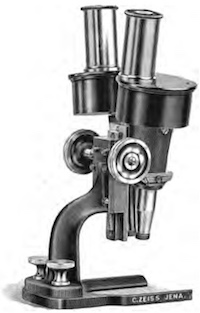 In 1892 Horatio S. Greenough, an American biologist then residing in Paris, suggested a promising concept for Abbe, by the end of 1897 the first stereomicroscope ever made providing true three-dimensional views was completed at Zeiss. The arrangement became known as a “Greenough Optical Train” that at first glance appears to be two microscope optical assemblies, each complete with its own objective lens and eyepiece but paired and aligned alongside. To change magnifications the user would change the provided paired objective lenses. This arrangement stimulates both eyes with one complete bright image (not reduced by beam splitting) and provides improved spatial resolution. Furthermore, with a three dimensional quality this allows the observer to judge depth, much as is perceived by a human with unaided binocular vision when observing a subject from a distance of bout 25 cm.
In 1892 Horatio S. Greenough, an American biologist then residing in Paris, suggested a promising concept for Abbe, by the end of 1897 the first stereomicroscope ever made providing true three-dimensional views was completed at Zeiss. The arrangement became known as a “Greenough Optical Train” that at first glance appears to be two microscope optical assemblies, each complete with its own objective lens and eyepiece but paired and aligned alongside. To change magnifications the user would change the provided paired objective lenses. This arrangement stimulates both eyes with one complete bright image (not reduced by beam splitting) and provides improved spatial resolution. Furthermore, with a three dimensional quality this allows the observer to judge depth, much as is perceived by a human with unaided binocular vision when observing a subject from a distance of bout 25 cm.
Right: Carl Zeiss Jena Greenough Optical Train stereo microscope (21,613 bytes).
Note the cylindrical Porro prisms housings, these correct the orientation of the image that otherwise would be upside down and reversed left to right.
Click on image to see enlarged view (61,428 bytes).
A side benefit of binocular observing is the reduced impact of distracting 'floaters' moving within the eye; a particular nuisance for older observers. Floaters are clumps of collagen fibers that form in the vitreous jelly-like substance within the eyeball. As the eye moves the floater(s) drift within and cast tiny shadows across your retina, so you perceive this out of focus debris moving along but you cannot keep them centered or focus sharply on them. When observing an object with binocular vision then the brain tends to averages these out.
The Greenough arrangement provides a true stereo perception, this differs from a binocular microscope that employs only one objective lens focused on the object of study with a beam splitter to divert the light from the one image, then feed it on to two eyepieces. It would not be until 1957 when the American Optical Company introduced their Cycloptic® Stereomicroscope that the Greenhough design would be superseded.
To this day many microscopes are available in monocular or in a binocular arrangement, but few are true stereo systems built upon parallel optical trains. There are microscopes made by Carl Zeiss that are binocular, and some marketed as stereo microscopes that include the Carl Zeiss “Stemi” series. Some binocular heads feature an additional port to accept a camera, this being referred to as a trinocular arrangement. The Carl Zeiss industrial and educational microscopes tend to be an adaptable modular arrangement, where any one of several binocular (eyepiece tube) or trinocular (termed phototube by Zeiss) heads can be attached to the stage. While most standard Zeiss some heads show an image that is erect but reversed left to right, there are some heads made incorporating image-erecting optics.
As an important aside, astronomical telescopes rarely incorporate image erecting optics as any unnecessary loss of light or reduction of resolution is a greater concern than observing an image that has been modified to appear rightsize up and correct left to right. To an astronomer it does not matter if the Moon, a planet or a star appear right side up or correct left to right, as long as they are as bright and clear as possible.
Martin's Favorite Zeiss Division Is Founded
Dr. Max Paulÿ (b. 15 November 1849, d. 26 April 1917) was an industrialist, and optician. His background is quite a story of experimentation and innovation. I offer a bit more personal background herein about Paulÿ as what is published seems inadequate given his contributions to building the foundations of Carl Zeiss Jena's Astro Division.
Johannes Gustav Max Paulÿ was born at Halle an der Saale (Halle, on the Saale River), a city in what was then the Prussian Province of Saxony in what would be in 1850 the reestablished Deutscher Bund (German Confederation), and after 1871 the Deutsches Kaiserreich (German Empire). His first four decades were largely spent in a central region of Germany residing in what were then the Duchy of Anhalt, Saxony, Brandeburg, and Prussia. He was described as a frail boy, the eldest of the three siblings in a family of five. His father Gustav Adolph was bright but appears to have lacked some stability of mindset and temperament, at times with a violent disposition even with wife Marie Louise (née Heffter); these characteristics made maintaining long term employment a challenge. Regardless of the family environment, by age 4 Max was demonstrating uncommonly good mechanical aptitudes.
In 1858 Paulÿ was attending the Frank School in Halle. A family relocation to the west in 1859 found him attending the elementary school in Harzgerode, in the Duchy of Anhalt. In 1862 he was enrolled in the secondary school of the orphanage in Halle, far from his home. In 1863 he was enrolled in yet another secondary school in Halberstadt in the Province of Saxony, to the north of Harzgerode.
Despite being an excellent student, in 1866 father apprenticed Max to work for a locksmith Dittmar, in Harzgerode; this would nurture his understandings of metals and machining. The following year Max was employed as a locksmith at “Billeter & Klunz Handelsgesellschaft”. This was a partnership company founded in April 1857 by machinist Heinrich Billeter and blacksmith Wilhelm Klunz at Aschersleben in the Province of Saxony, about 20 km northeast of Harzgerode. Their company would grow to become a large machine tool factory and iron foundry. It is noteworthy that among the equipment they were involved producing were beet washers. Paulÿ subsequently studied at the universities in Berlin, and Halle, and at the Technical University in Berlin.
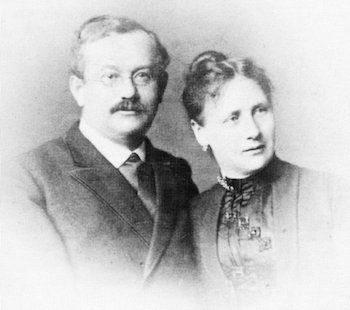 With his experience in machinery and its production, and likely with knowledge of beet washers gained while at Billeter & Klunz, Paulÿ was employed by 1878 managing Zuckerfabrik Brottewitz, a sugar and beet factory founded in 1872. This was near the village of Brottewitz close to the Alte Elbe River, and a few kilometers north of Mühlberg in the Province of Brandenburg.
With his experience in machinery and its production, and likely with knowledge of beet washers gained while at Billeter & Klunz, Paulÿ was employed by 1878 managing Zuckerfabrik Brottewitz, a sugar and beet factory founded in 1872. This was near the village of Brottewitz close to the Alte Elbe River, and a few kilometers north of Mühlberg in the Province of Brandenburg.
Right: Max Paulÿ with his wife Klara, née Küttner (54,670 bytes).
Click on image to see enlarged view (297,298 bytes).
On 8 September 1881 Max and Klara Eugenie Küttner were married in Dresden, then in the Kingdom of Saxony. Their marriage record mentions his employment in factory management, and his “Doctor Philosophiae”.
From an early age Paulÿ had been fascinated by the night sky. By the 1880s he was studying practical optics, then set up his own laboratory in the in the basement of his house. In 1885 while attending the Industrial and Trade Exhibition at Görlitz, Silesia, Paulÿ observed then studied a reflecting telescope owned by Mr. v. Schlicht. The telescope had been manufactured by Mr. G. Meiβner in Potsdam. This inspired Paulÿ to visit Potsdam where he met Mr. G. Meiβner who helped Paulÿ learn more about optical surface preparation, and the application of reflective coatings. This inspired Paulÿ to not only study work of others, but build his own small scale optical production and testing apparatus so that he could actively become involved with his own experiments. Two assist with the work, her persuaded two employees of the sugar factory to help him: August Shäfer, a blacksmith who would handle mechanical fabrication, and bricklayer Karl Tauchnitz to assist with optical grinding and figuring.
Paulÿ invented methods and equipment for rough grinding glass mirrors, lenses, and prisms. He examined the materials and the surfaces carefully, and making notes to help refine his techniques. He improved tolerances, fashioning measuring equipment so he could critically verify the desired lens curves and thicknesses. He learned how to recognize, then compensate for, slight variations that were typical in the glass materials made in that era. For lens designs Paulÿ relied on opticians and mathematicians who could calculate the radii and other parameters. When making the element he would pay special attention to getting the radius of curvature at the various zones to be nominal, even developing techniques to head off some problems before they might need remedy. He also came to understand the effects of temperature changes on refractive lens elements and of cementing media, and impacts of mounting techniques. So he avoided designs that necessitated cementing lenses together unless absolutely necessary and developed improved ways of holding a lens in place. Within a couple of years he was producing as an enthusiast, a series of telescope lenses and mirrors, prisms, and auxiliary optics, some that rivaled the qualities of what a professional factory might offer.
The disciplined professionalism of his research, the diligence, led to his results that impressed many of his contemporaries and astronomers too. Consequently, a demand for his products developed. Soon he was not only fabricating optics for his own telescopes and experiments, but was producing for opticians as well as for other enthusiasts. In several instance his generosity to some who could not pay was noted, Paulÿ seemed content to help others in his pursuits, and no doubt their constructive feedback was valued.
In 1886 Paulÿ completed a 6-inch objective for the O'Gyalla Observatory, a private observatory of the astronomer Mikulás Konkoly-Thege, then in Austria-Hungary; this now the Hurbanovo Observatory, an active public observatory with a planetarium, in Hurbanovo, Slovakia. Paulÿ also produced two 10-inch objectives for the directors of the Observatories of O'Gyalla, and of the Hérény Astrophysical Observatory founded by Hungarian astrophysicist Eugen (Jenő) von Gothard. Paulÿ must have been doing something right to inspire an astronomers some hundreds of miles away to trust his optics.
In 1887 Johannes Gustav Max Paulÿ was admitted to membership of the “Astronomischen Gesellschaft” (Astronomical Society) in Germany. He was then still listed as a factory director, then residing in Mühlberg a.E. He still took pride in producing what he characterized as the finest sugars. While still with at Zuckerfabrik Brottewitz, in 1889 he invented the “Paulykocher”, a pressure cooker that improved efficiency of the process of evaporating liquids thus reducing the amount of coal formerly required, by about 30 percent; Paulÿ was 'green', before it was politically correct.
In 1888 Paulÿ completed the production of his own personal 8-inch refracting telescope. The lens was designed by his friend Miklós Konkoly-Thege. Paulÿ contemporary obituary mentioned “At the beginning of the 1890s, the 8-inch telescope was mounted for his own observatory based on designs by his friend von Konkoly, and a primitive dome was built. A transit instrument by von Gothard and a Strasser pendulum clock completed Paulÿ's small observatory, where the sun and planets were diligently observed, but which primarily served to test new instruments.”
-
As a side note, we at Company Seven come across mentions in literature from this era of “Parisian inches”. At 27.07 mm in length, the Parisian inch is 1.066x longer than the 25.4 mm US/English inch. So when we read mentions of his 8 inch telescope, consider we could, by our standards of measure, be discussing an 8.53-inch aperture telescope. An early achromatic refracting telescope, publicized as a 9-inch f/18 was in 1846 used by Johann Gottfried Galle (9 June 1812 - 10 July 1910) and Heinrich Louis d'Arrest (13 August 1822 - 14 June 1875) at Berlin Observatory to confirm the planet Neptune, to within 1° of the position predicted by the mathematical calculations of French astronomer Urbain Jean Joseph Le Verrier (11 March 1811 - 23 September 1877). This refractor is also described as a 24.4 cm (9.6-inch), by others as 25 cm (9.8-inch),s making it hard to reconcile the advertised discrepancies. In some instances it may be the descriptions were rounded up or down for convenience, or simply mistaken.
Initially Paulÿ with his assistants had devised grinding and polishing apparatus that were belt-driven and powered by hand or foot. By the early 1890s the machines in the basement of his house were motorized. In 1895 he completed a polishing machine capable of working optical surfaces up to 600 mm (23.6 inches) diameter.
Elsewhere in Jena, Dr. Otto Schott was working to develop and refine new glass types for Carl Zeiss Jena, but the small sizes of the raw blanks to produce the tiny microscope elements hindered evaluating them for larger applications. Schott became acquainted with Paulÿ, and would on occasion send larger blocks of glass to him for experimentation. It was Paulÿ who suggested casting these blanks not as squares but in cylindrical forms, resulting in less work and less waste. Paulÿ evaluated several new glass types from Schott AG and although at times he might attain the desired results, he documented subtle inconsistencies of these first examples of glass. Schott AG appreciated the feedback as this helped them to improve their products.
Between 1891 to 1894 Paulÿ completed several telescopes including: a 7-inch apochromat for the Observatory in Jena, a 6-inch Apo for the Urania Society of Berlin, and in 1893 a 175 mm (6.9 inch) Apo for observations by Spiridon Gopčevič.
Paulÿ had grown the sugar factory business, expanded his factory facilities, and while maintaining his high standards. But he had never been a model of physical fitness and health and like many others who were involved with fabrication that involved heavy metals (such as in glass) and materials in polishing compounds, after several years he showed signs that prompted his physician to recommended Paulÿ taper his activities. He had reached a fork in the road where one path continued on his prosperous sugar and beet business, the other on a path with optics that lead to the unknown. As Paulÿ had reportedly concluded before, “Zucker machen könne auch ein anderer, große Linsen schleifen aber nicht” (“Anyone else could make sugar, but not grind large lenses”). Paulÿ elected to retire from the sugar business to continue working with optics.
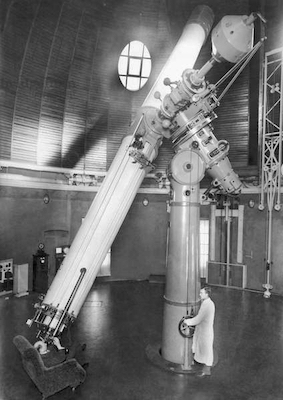 Fa. Carl Zeiss, Abteilung Astronomie: Paulÿ relocated to Jena where he collaborated with teachers, engineers and technicians, and here he met Ernst Abbe. Abbe respected Paulÿ's accomplishments, his intellect, and managerial skills. Abbe was particularly intrigued by the work Paulÿ had done to manufacture optics suitable for astronomical telescopes. It had only been a few years since Carl Zeiss Jena commenced the design and production of sporting optics (binoculars, field telescopes, etc.), that department was new and blossoming when in 1897 Abbe persuaded Paulÿ to join Carl Zeiss Jena in a partnership to establish another new department. This would be the “Fa. Carl Zeiss, Abteilung Astronomie”, translating to English as Factory Carl Zeiss, Astronomy Department, established 1 April 1897. This would specialize in the design and production of all components of astronomical telescopes, including their optics and mechanical components, and their accessories including oculars, astrophotography cameras, binocular telescopes, large binoculars, and specialized related scientific instruments.
Fa. Carl Zeiss, Abteilung Astronomie: Paulÿ relocated to Jena where he collaborated with teachers, engineers and technicians, and here he met Ernst Abbe. Abbe respected Paulÿ's accomplishments, his intellect, and managerial skills. Abbe was particularly intrigued by the work Paulÿ had done to manufacture optics suitable for astronomical telescopes. It had only been a few years since Carl Zeiss Jena commenced the design and production of sporting optics (binoculars, field telescopes, etc.), that department was new and blossoming when in 1897 Abbe persuaded Paulÿ to join Carl Zeiss Jena in a partnership to establish another new department. This would be the “Fa. Carl Zeiss, Abteilung Astronomie”, translating to English as Factory Carl Zeiss, Astronomy Department, established 1 April 1897. This would specialize in the design and production of all components of astronomical telescopes, including their optics and mechanical components, and their accessories including oculars, astrophotography cameras, binocular telescopes, large binoculars, and specialized related scientific instruments.
Right: Carl Zeiss Jena Astronomy Department 650 mm (25.6 inch) refracting telescope with observatory dome.
Constructed for the Berlin University Observatory at Babelsberg, completed in 1915, shown here about 1924 (84,000 bytes).
From the owner of Company Seven's viewpoint, this is what a real telescope looks like consequently, here we focus more attention on these.
Click on image to see enlarged view (129,884 bytes).
Paulÿ persuaded August Shäfer and Karl Tauchnitz to accompany him in relocating to Jena. They set up manufacturing for the mass production (large volume for the time) of lenses and mirrors, prisms, and auxiliary optics, and to produce the mechanical components. The cooperation of mathematicians and opticians already at Carl Zeiss Jena were especially beneficial to developing entirely new designs of lenses and instruments. Collaboration between the Astronomy Department and Schott AG resulted in them producing more new, or better optimized glass types.
Positive reviews of the “Jena telescopes” soon were being published. At the International Astronomical Association (Astronomische Gesellschaft) seventeenth Congress, convened on 23 September 1898 in Budapest, Dr. Max Wolf, Director of the Heidelberg Observatory, described observations with, and testing of, “an objective worked by Dr. Pauly in Jena” whose “colours are exactly comprised from the extreme red to the blue; only towards the G line the colours begin to deviate....The correction of sphericity is also small.“ Interestingly, there was no mention of Zeiss or of Schott, only a passing mention of “a new glass of Jena“ that made the new 212 mm f/21 telescope's high performance possible. Dr. Paulÿ, also attending the conference, also spoke about the manufacture of the new objective.
Some background about Achromat, Apochromat: in order to present an image that is perceptibly sharp and clear, well-representing the object of study, designers of telescopic lenses have to solve many aspects of optical physics termed “aberrations”. One of the challenges had been to produce a lens that could focus the primary colors of the spectrum (red, green and blue) to, or near to the same one image plane. The descriptive word Achromat; is derived from the Greek word for color “chrôma” and their term “alpha privatum” meaning without. Achromatic describes a lens that can focus two of the three primary colors at the same plane. With a suitably long focal ratio, on the order of f/18 or longer, the early achromat's showed little false color, at just barely perceptible levels. However, being able to focus only two colors leaves the third component color slightly out of focus. So an achromatic telescope optimized for visual uses for example would focus red and green, but leave the blue (or violet) slightly out of focus thus showing a bright object (Moon, a star) with a slight violet halo.
A higher order correction would focus all three primary colors at the same plane, and do so with so little differences or dispersion of the rays. A telescope that would show no 'false color', such as that violet or crimson halo, would show a more intense and detailed image. The system that corrects all three primary colors presents sharper, more intensly clear images than less advanced lenses. Apochromatic describes that higher order of optical performance by lenses introduced for use in microscopes of the 1850s, later for photographic cameras, and finally for premium refracting telescope objectives. Apochromat derives from the ancient term “apo,” meaning away from, hence away from color. The development of the apochromat was hindered until the late 1800s when more knowledgeable designers, improved glass types and manufacturing resources became available.
An early definition of apochromatic was that none of the light rays comprising three primary visual colors that combine to form an image, those made up of red, green and blue colors of the spectrum, spanning from Fraunhofer's C to F lines, would be out of sync from the other rays by not more than 0.05% of the focal length of the lens. Modern true apochromatic, or apo, telescopes may be corrected over wider ranges with C to G being not uncommon today. Because good refractors are so versatile and comparatively lightweight for what they show, they remain highly desired even today. Consequently there are lesser telescopes being marketed as “Apo” where in their case this is being carelessly applied. As in the days of old when good refractors were expensive, Martin cautions “good Apos even today are not cheap, while cheap Apos are not that good.”
More Great Minds: Carl Zeiss employed a number of persons whose names have become familiar to those who use optical instruments. Among the more prominent were Dr. Paul Rudolph (1858 - 1935) who pioneered developments in lenses for cameras and microscopy, and most notably is credited for “Rudolph'schen Prinzip der anastigmatischen Bildfeldebnung” (Rudolph principle of anastigmatic field flattening). Each would not only develop new advances in optics, but would also nurture their co-workers and those new to the company: there was much 'cross-pollination' back and forth between the designers and those at Schott developing the glass types.
 Among these talented minds would be one who had notable impacts in our favorite, astronomical instruments: Dr. Albert König (in English usually spelled Koenig), (b. 16 August 1871, d. 30 April 1946). Albert König was a student of mathematics and physics at the Universities of Jena and Berlin König became acquainted with Zeiss management. He received his doctorate in Jena for his thesis “Beiträge zur Theorie der Fresnelschen Beugungsspektra” (Contributions to the Theory of Fresnel's Diffraction Spectra), which was assigned to him by his teacher Professor Dr. Ernst Abbe. König was invited and came to work for Carl Zeiss Jenas on 1 October 1894. By 1895 König had completed the work for his Ph.D. After his arrival at Carl Zeiss Jena, König promoted quickly to become responsible for leading a design team which would develop numerous optical systems including several famously successful eyepieces, prisms, range finding and measuring instruments, and telescopic objectives.
Among these talented minds would be one who had notable impacts in our favorite, astronomical instruments: Dr. Albert König (in English usually spelled Koenig), (b. 16 August 1871, d. 30 April 1946). Albert König was a student of mathematics and physics at the Universities of Jena and Berlin König became acquainted with Zeiss management. He received his doctorate in Jena for his thesis “Beiträge zur Theorie der Fresnelschen Beugungsspektra” (Contributions to the Theory of Fresnel's Diffraction Spectra), which was assigned to him by his teacher Professor Dr. Ernst Abbe. König was invited and came to work for Carl Zeiss Jenas on 1 October 1894. By 1895 König had completed the work for his Ph.D. After his arrival at Carl Zeiss Jena, König promoted quickly to become responsible for leading a design team which would develop numerous optical systems including several famously successful eyepieces, prisms, range finding and measuring instruments, and telescopic objectives.
Left: another optical master of Jena, and head of the team who designed Martin's precious Carl Zeiss Jena Type B Apo, Dr. Albert König.
Photo from about 1924 (19,151 bytes).
Keep in mind that many of the more complex optical designs and glass types came about then as a result of coordinated teamwork. In this era teams or even rooms full of mathematicians could be assigned the task of calculating and optimizing optical designs over days, weeks, or longer. Today one person with a computer and optical design software can, with the broader range of available optical glass types, produce similar or even better results in minutes. Still, the modern lens designers and developers of optical glasses and crystals have largely built upon the accomplishments of their predecessors, including those at Carl Zeiss Jena.
In 1900 Dr. König became more involved in calculating optical designs and mechanics for Zeiss terrestrial and astronomical telescopes. promoting to head the Carl Zeiss Jena department for terrestrial telescopes at the Zeiss-Works. In 1921 he commenced the calculations for the optics of geodetic and precision measuring instruments, managing the scientific section of the department for geodetic instruments until 1930. Dr. König survived to see the end of World War II and its initial impacts on Germany, including the nation's partition; in 1946 at age 74 Dr. König passed at home after a brief illness. It is said that even up to a few days prior to his passing, even though bedridden he was still calculating optical designs. It is difficult to overstate his contributions to optics, the exact number of his accomplishments has yet to be tallied, if at all possible. However, one fact remains that over his tenure at Carl Zeiss Jena more than eighty Patents became associated with his name.
Zeiss Type B “Apo” (Apochromatic) Objektiv
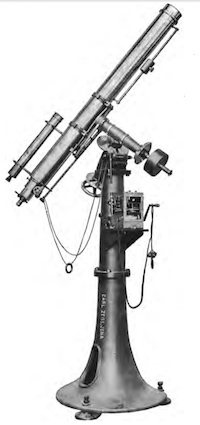 At the turn of the 20th century Carl Zeiss Jena introduced their landmark “Type B” triplet apochromat objective. The Carl Zeiss Jena team that developed the Type B was led by Albert König. This design was likely conceptually influenced by an air-spaced triplet apochromat f/18 lens patented in 1894 by Harold D. Taylor, chief engineer of T. Cooke & Sons of York, England, but neither that lens nor any other produced up to then (mostly achromatic) could not rival the Zeiss B for all three major considerations of: performance, durability, or speed as the Type B works well at f/15.
At the turn of the 20th century Carl Zeiss Jena introduced their landmark “Type B” triplet apochromat objective. The Carl Zeiss Jena team that developed the Type B was led by Albert König. This design was likely conceptually influenced by an air-spaced triplet apochromat f/18 lens patented in 1894 by Harold D. Taylor, chief engineer of T. Cooke & Sons of York, England, but neither that lens nor any other produced up to then (mostly achromatic) could not rival the Zeiss B for all three major considerations of: performance, durability, or speed as the Type B works well at f/15.
This air-spaced triplet (three lens elements) consists of BaLF4 (Barium light flint), KzF2 (short flint) and K7 (crown) glass that reduce chromatic and spherical aberrations to a heretofore unprecedented levels that would not be bested until the late 1970s. The Type B solves:
- Secondary spectrum
- Spherical aberrations
- Chromatism from any spherical aberration (Gaussian aberration)
- Freedom from zones
- The Abbe sine condition is fulfilled (exhibiting sharp images of off-axis as well as on-axis object of study)
Right: Carl Zeiss Jena Parallaktisch montierter Refraktor (Equatorially mounted refractor). An astronomical 90mm f/15 refracting telescope, equatorially mounted and supported by a German Equatorial Mount with mechanical Right Ascension clock drive, and metal pier. If with E Objective then this would be designated their “EUBAGI” priced at 2000 Marks, if with the B Objective then “EUCARPIO” selling for 2220 Marks. This arrangement with pier would have been installed in a domed observatory so the Dew Shield (Lens Shade) might not needed, and this is not installed for this image. Another side note, this pier has leveling feet and so it could have operated on any firm ground or on a concrete footer, or the feet could have been removed and the set bolted onto anchor bolts (26,869 bytes).
Click on image to see enlarged view (59,689 bytes).
The Type B glass lenses curves are steep (some have mentioned “bowling ball curves”), with the middle element becoming very thin at the middle, hence were very complicated and difficult elements to grind, polish and sfigure. Furthermore, due to the strong refractive power of the individual lenses, the Type B components are very sensitive to decentering, or to changes in the spacing of its three lens elements. This called for an unprecedentedly complex Lens Cell made of components including metals and glass, to support the three lenses precisely centered and spaced, even while also allowing for temperature changes compensation.
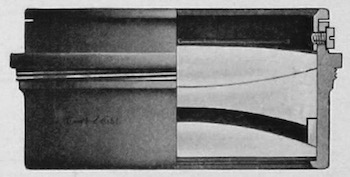 The Type B is a very complicated, time-consuming and difficult to produce lens. In order to achieve the calculated top performance it was necessary for Schott to guarantee the glass refractive indexes and homogeneity were of theirs highest specification.
The Type B is a very complicated, time-consuming and difficult to produce lens. In order to achieve the calculated top performance it was necessary for Schott to guarantee the glass refractive indexes and homogeneity were of theirs highest specification.
Left: Carl Zeiss Jena “Refraktor Type B” lens in cell cutaway view, from Zeiss astronomical instruments catalog (22,177 bytes).
Click on image to see enlarged view (63,754 bytes).
The Type B telescopes remained well regarded from the turn of the century until being discontinued before World War II. But even today the owners of a Type B, the enthusiasts, and repair technicians (the few who will touch one) remain in awe of what that team under König accomplished. Company Seven's founder owns and in the past serviced his 130 mm f/15 Type B Apo telescope, a “EUHEMERO” that was completed in about 1910. Company Seven does not exhibit this instrument.
For an example of weight and costs, the Carl Zeiss Jena 130 mm Type B telescope optical tube assembly components are made of precision machined iron, steel and brass, plus the glass lens, and this amounts to a weight of 61-¾ lbs. The telescope OTA with all the standard basic accessories, and fitted wood storage cases, amounted to 352 lbs. The German Mount and Pillar crated added another 1188 lbs. With the crated set taking about 93-¼ cubic feet. The complete telescope set of the 1910 era had a base cost of 3920 Marks, plus shipping. The exchange rate of US Dollars to Marks in 1913 was 4.20:1, so then the base price of this telescope in 1913 would have been equal to $933.33, or equivalent in buying power to about $42,864.95 in 2025. In 1910 the cost of this telescope was about twice an average laborer's annual salary, half the average pay of a dentist, a bit more than the base cost of the Ford Model T (that would drop to $290 by 1924), and could be almost half the price of a modest new three-bedroom home.
Comparing this to a modern 130 mm Apochromat, several made in 2025 are optically superior, lighter weight telescope that is more versatile too. A modern top-of-the-line 13 cm Apo such as the Astro-Physics Co. 130 GT that has a focal ratio of f/6.3 with overall length under 28-½ inches, with the OTA weighing about 18 lbs. Even if sold with a suitable precision German Mount, such as a Losmandy G-11, this basic set could cost about $12,000. To add accessories comparable to what were included with the new Zeiss 130 mm Type B telescope, could yet another $4,000. But nothing made in 2025 will appear as striking, even imposing, as an original Carl Zeiss Jena Apo made early in the 20th century.
Carl Zeiss Jena continued to develop astronomical telescopes and instruments, even inventing the Planetarium that would inspire many generations of us to look up. Their refracting, reflecting and catadioptric telescopes could always be counted on to be finely crafted, and representing the state of the art, even if not the largest.
König was responsible for the development of new ocular designs, some which featured unprecedented apparent fields of view of up to ninety degrees and with good performance. His eyepiece designs over the years included several lens arrangements: combinations of singlet and doublet lenses, of varying glass types, etc. Although there are some contemporary makers who advertise a “König Eyepiece”, that is in fact not a design that is known as having any one particular lens arrangement. Many that are represented to be a König eyepiece tend to be wide-angle designs of from 65 to 70 degree apparent field of view, and these work best when used with telescopes of longer focal ratios.
In the 1930’s Dr. König entered into discussions that would lead co-worker Dr. Alexander Smakula (b. 9 Sep. 1900, d. 17 May 1983) to develop antireflection lens coatings that are discussed later in this article. His remains one of the more remarkable careers in optics, spanning some 52 years with Zeiss, achieving noteworthy patents in terms of quantity and of quality. König was a man of remarkable intellect and with management style ideally suited to achievement in his times.
Carl Zeiss Jena product designations and serial numbering: before the turn of the century management adopted a policy that most common Zeiss products would bear a designation, a name that clearly identified the product and would facilitate cabling information and the placing of orders. Keep in mind that many orders at the time were placed by telegraphy (radio or by wire) and telex (a switched network of teleprinters) at the time, and there were good reasons to keep transmissions brief and succinct. The differences names could also refer to variations of accessories. So for example, a particular 80 mm achromatic refractor telescope furnished with the alt-azimuth stand and wood field tripod, a fitted wood storage case, and selection of accessories was designated “ASESTARON”; this word is a Spanish verb. An astronomical refracting telescope ordered with an Achromatic objective lens would have its own name, while if ordered similarly equipped but with an Apochromatic objective lens instead, then it would bear another name.
By 1907 Carl Zeiss Jena binoculars too would be labeled with a designation, a label such as “TELEX” for a 6 ×21 manual focus model, or “TELEXEM” for one with central focus. That one brief naming term explained to sales and production people alike what item(s) were expected to be delivered.
From the commencement of production at Carl Zeiss Jena Astronomy Department there was maintained a hand-written log diary known as the Zeiss “Diarium”. The Diarium lists production of telescopes, their optics and accessories. In the early years it also included accounting information including employee working hours. The Diarium record lists each lens or mirror produced with its Serial Number, and includes information about it, and often its original destination/customer. Modern archivists reason the date entered was either when the order was entered into the production schedule, or the date on which the item serial number(s) was issued to those in the workshop' this would not necessarily be the date when fabrication of the item was completed, or when the item was handed over for delivery to the customer.
Over the initial few years of production there was no standard for labeling the telescope objective lenses and mirrors. So most early Carl Zeiss Jena telescope lenses and mirrors bear only a hand-engraved Serial Number, and each might or might not include design information or labeling such as “Apochromat” for example. There are some mentions that Paulÿ himself engraved the information on some of these early lens cells. The early Carl Zeiss Jena binoculars also bore their company name and product labeling in factory engraved cursive with serial number stamped in block numerals on a hinge frame, until all their labeling transitioned to block lettering in about 1904.
The Astronomy Department production labeling transitioned from cursive to machine-engraved block letters before production serials reached the 300 series. But other information including the lens type designation, and focal length was not standardized until about 1900, by more than 800 lenses had been produced. For most of the pre World War II production the lens cell was labeled around its outer radius with: trade name “Carl Zeiss, Jena”, lens serial number “Nr. xxxx”, type (A, B, etc.), and Focal Length as “f= xxx cm”. By the time of WWII, and afterwards, the Carl Zeiss Jena telescope lenses may bear the information on a label or metal plate affixed to the lens cell.
Carl Zeiss Jena telescope mirrors were made of glass melted into a mold. Initially these were labeled with brand, serial number, and measurement details that typically included a measure of the focal length. After the Carl Zeiss Jena achromat logo was adopted, then the glass molds were made to incorporate this so that when the glass was poured and annealed, the rear surface of the mirror would bear the embossed logo.
The lenses and mirrors were sold as part of a telescope optical tube assembly but these main optics were also available for purchase separately, with the lens or mirror in its cell provided in a fitted wooden case. In several models of astronomical telescope the objective lens could be interchanged, so for example an E objective might be replaced by a similar aperture and focal length B objective. A damaged mirror could be replaced with like. An original focuser intended for light duty applications could have been replaced later with one better suited for heavier payloads.
As sales increased it became more cost effective to produce many of an item, rather than one or a few at a time. The more commonly requested telescope objective lenses, mirrors, optical tube or mount components, and accessories (eyepieces, Zenith diagonal, image erecting prisms, etc.) were manufactured in lots. Their serial numbers would be assigned in batches, so if making 100 focusers then serial numbers 5100 to 5199 might be assigned to this production lot, and in the production log the date might have been the date these were ordered however, the entry for each would be edited later to reflect them being assigned to a new telescope. Some of these items could be in stock and on a storeroom shelf, ready to be selected to assemble a complete new telescope, for some time before it was needed. So, a component manufactured prior to Zeiss adopting the famous achromatic lens trademark might have been delivered with a telescope made years after the trademark was adopted; this could confuse someone trying to date the item.
The typical Carl Zeiss Jena astronomical telescope made before World War II will have at least two identifying serial numbers because the major components were engineered to be removed to facilitate servicing for example, or even upgraded. The approximate date when the telescope was originally assigned a serial number during production is usually deduced from reading the information on the objective lens cell or mirror. The telescope focuser too will bear its own serial number, this is engraved along the top of the draw tube housing and this number will be different that that on the objective, reflecting production sequence of the focuser only. The focuser or a prism might have been fabricated and serialized years before the telescope was completed. By today, components now on an older Carl Zeiss Jena telescope could have been installed decades after the telescope was originally completed, or the telescope might have been restored with parts from several used telescopes to complete one “Frankenscope”. It takes some experience to judge the components together to deduce which could have been original.
Carl Zeiss Jena Telescope Objectives the astronomical refracting telescopes initially developed were built on an air-spaced doublet achromatic lens arrangement. It was Joseph Ritter von Fraunhofer who developed this, since know as the classic Fraunhofer doublet achromatic lens arrangement. The Fraunhofer double places a positive crown glass element first, as these types of glass have better resistance than the negative flint glass element to the atmospheric elements. Later variations were developed where the elements are basically reversed, this can provide slightly improved performance with some designs such as a doublet with either CaF2 (synthesized calcium fluorite) or FLP53 (fluorocrown glass) leading elements. Carl Zeiss Jena would also develop two highly acclaimed triplet apochromatic objectives, about 80 years apart.
The aperture (lens diameter), focal ratio, degrees of color and spherical aberrations correction, and some other qualities of the lens could be selected based on their products intended purpose. The standard production Carl Zeiss Jena Astronomy Department refractor telescope objectives were identified by a letter designation:
- Zeiss A Objektiv: doublet achromat lens made of KzF2 and BaLk2 glass. Typically with a ratio of f/17.5 or longer.
- Zeiss B Objektiv: landmark high performance triplet apochromat lens of 1900. This is discussed in some detail farther down in this article.
- Zeiss C Objektiv: doublet achromat of BK7 and SF2, made in apertures ranging from 25, 30 and 45 mm f/8 for auxiliary and finder telescopes, and as an objective for larger telescopes made in apertures of 60mm at f/4.1, 63 mm and 80mm and with focal ratios as fast as f/6.25, or a 110 mm f/6.8, 110 and 130 mm at f/12. The C is well suited for low magnification uses with wide field astro or terrestrial field telescopes, and binoculars. A cemented 63mm longer focal ratio f/13.3 was produced for use in smaller, moderate cost achromatic astro telescopes including the Telementor. It's chromatic and spherical correction are less favorable than E lenses however, since C lenses operate with lower magnifications, the remaining errors are not noticeable.
- Zeiss D Objektiv: triplet achromat lens available in apertures from 80mm up to 200mm for applications similar to those of the C telescopes, but with a larger aperture ratio and improved optical properties (chromatic and spherical correction), the performance is better. About forty of the 80 mm f/6.25 were produced in 1910-1912 for sale as a lens option for the “Kometensucher” (Comet finder) telescopes, though many more were produced with the C Objective.
- Zeiss E Objektiv: doublet achromat lens, typically with a ratio of f/13.3, f/14 or f/15. Often suited for use in terrestrial telescopes where demands of magnification are less than for astronomical applications.
Later, the Astronomy Department developed these lenses:
- Zeiss APQ Objektiv: another landmark high performance triplet apochromat lens. Featuring a CaF2 (Calcium Fluorite) middle element, in an oiled (not air-spaced) arrangement. Released in 1984, and produced until the, then unified, Zeiss Astro Department production ceased in 1995. Produced, but not all publicized, in apertures ranging from 80 mm up to 200 mm and with focal ratios ranging from f/6.25, f/6.4, f/7.7, f/7.8, and f/10. There was a design for a 305 mm f/12 however, none were produced before the shutdown of the department. The APQ lens development is discussed farther down in this article.
- Zeiss AS (Astro Spezial) Objektiv: doublet achromat design by August Sonnefeld completed in 1926. Similar color correction to the A Objective but with KzF2 and BK7 glass elements providing improved correction of spherical aberration. The longer focal ratio lenses of f/15 were sometimes termed a semi-apochromat. We know of 63 mm f/13/3, 80mm f/10.5, and 100 mm f/10 lenses also having been produced though with reduced color correction.
Carl Zeiss Jena mirrors could be suppled uncoated, or coated with silvered, nickel, speculum, or gilded of gold. Their front surface was figured as either;
- Parabolic Concave Mirror: with focal ratio as requested, in diameters of 110 mm up to 500 mm or larger on request.
- Spherical Concave Mirror: with required radius as requested, in diameters of 30 mm up to 500 mm or larger on request.
- Plane (flat) Mirror: circular or elliptical, in diameters of 30 mm up to 500 mm or larger on request.
Special notes about this era:
There could be issues of longevity resulting from extended exposure to moisture or chemical air pollutants particularly near urban centers or factories. Most buildings of this era relied on burning coal or wood, gas or oil for heating, power generation and manufacture. The Carl Zeiss Jena factory facilities were primarily coal-fired and with some natural gas. The combustion produces nitrogen oxides and sulfur dioxide that are exhausted into the atmosphere, these combine with water to form acid rain. Acid rain has damaged stonework and other components of ancient buildings and monuments. Telescopes are not used in the rain, but acidic dew can condense on them and some glass types had poor stain resistance. Lens element(s) made of early glass types and exposed to such environments over time could become stained or even etched, gradually clouding the views while appearing as light hazing or dust that will not clean off the lens. There are examples of Carl Zeiss Jena being called upon to service etched lenses, this would involve grinding off the etched surface then polishing/refiguring that would change some properties (certainly focal length) of the lens. There are records of some lenses having been refigured several times, some until it became impractical to reworks and that would result in having to replace the etched element(s), if not the entire objective. Newer glass types and coatings were developed that considered improved resistance to staining and breakdown, while better civic air quality management too has helped. Also, by 1912 the environmental problems associated with the combustion were recognized, and led by Dr. Straubel (mentioned farther down in this article) remedies to reduce this were commenced.
The Carl Zeiss Jena Astronomy Department produced lenses and mirrors to suit special requirements. So for example, lenses with uncommon aperture diameters or of extraordinary focal lengths (f/20 or longer) were produced for laboratory uses or for some special applications.
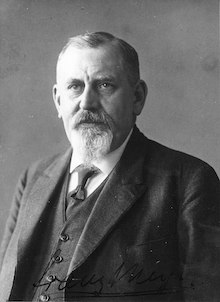 Franz A. Meyer (b. 6 June 1868 Hamburg, d. 29 May 1933 Jena) became in 1902 the first college educated engineer employed at the Optical Workshops at Carl Zeiss Jena; a person of his qualifications and experience was deemed necessary by Abbe for the design and construction of large astronomical instruments. Although he also played a part in many other areas of production at Jena, among these accomplishments he would lead the team that produced one of the two planetariums designed for Das Deutsche Museum of Munich. Over the coming decades Meyer would contribute in other areas of scientific instrument development, some very notable for their contributions to science and physics in particular.
Franz A. Meyer (b. 6 June 1868 Hamburg, d. 29 May 1933 Jena) became in 1902 the first college educated engineer employed at the Optical Workshops at Carl Zeiss Jena; a person of his qualifications and experience was deemed necessary by Abbe for the design and construction of large astronomical instruments. Although he also played a part in many other areas of production at Jena, among these accomplishments he would lead the team that produced one of the two planetariums designed for Das Deutsche Museum of Munich. Over the coming decades Meyer would contribute in other areas of scientific instrument development, some very notable for their contributions to science and physics in particular.
Left: Franz A. Meyer of Carl Zeiss Jena, c. 1924 (18,542 bytes).
One project commenced in 1930 under Prof. Dr. Rudolf Straubel, the scientific director of Carl Zeiss Jena, would have Franz Meyer's working with Friedrich Schiller University of Jena Professor Dr. Georg Joos. The instrument designed by Meyer was built in the astronomy workshop, it attained an unprecedented level of accuracy. Their experimentally proved that Einstein's theory of relativity was valid, and this was among the highlights of Franz Meyer's career. Franz Meyer Ing. become Dr. Ing. Franz A. Meyer in 1930 when the Friedrich Schiller University of Jena awarded him the title Dr. h.c. for his services to scientific instrument construction; it was a very rare honor to have this awarded to a practicing engineer.
The partnership arrangement changed when in April 1903 the Carl Zeiss Jena company took over this department, and Paulÿ became its first Manager.
Precision tracking, especially needed for long exposure astrophotography, mandated rigid and smooth moving mounts whose Right Ascension axis is motorized, so Dr. Meyer and his team designed telescope mount electric-powered drive (some weight-driven, for remote locations) with regulating controls. This team also devised instrument interfaces (for cameras, etc.), Filar micrometers and other measuring devices including photometers, spectroscopes, spectrographs, binocular viewing attachments, and other accessories for their telescopes making each Zeiss telescope capable of becoming a well-integrated system.
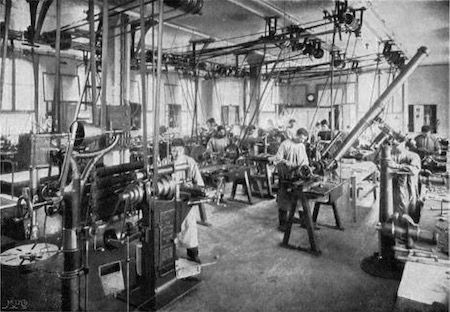
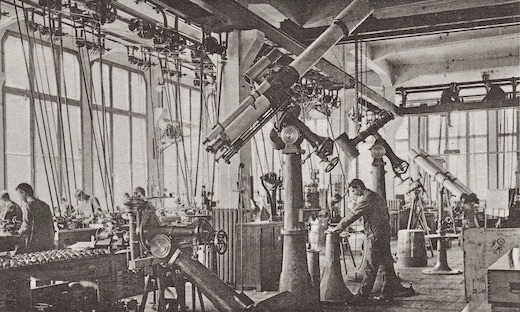
Above: Carl Zeiss Jena astro division's workshop, about 1904 (66,484 and 93,775 bytes).
Described in their catalogs as (translated to English) “adjustment workshop for smaller astronomical and terrestrial telescopes.”
Image at left shows the machining and components assembly areas, note their belt-driven machinery. At right is the far side of the same room
where smaller telescopes are being assembled and components integrated. For perspective note four-legged steel platform just right of center
in the first photo, while the same table appears left of center supporting a German Mount in the second photo.
The photo at left shows about a 90 mm (3.5 inch) aperture achromatic refracting telescope on the German mount and pier post.
The physical length points to it being a “Eubulidem” with the longer 1600 mm focal length “E” objective lens.
Photo at right shows (left to right) a German Mount with half pier, then a 150 mm photo-equatorial refractor with astro camera
and guide telescope; this is either an achromatic “Eustasia” with ”A” or apochromatic “Eutelidas” with “B” objective lens.
Then another German mount and pier. At far right is a “Asal” 130mm terrestrial binocular telescope with column stand.
As larger and larger telescopes were being built they required a domed observatory that could adjust the floor height relative to the telescope focuser, so elevating floors and observation platforms would be among the features designed and produced by Carl Zeiss Jena. Dr. Franz Meyer would become Director of the Konstruktionsabteilung (Design Engineering Department) of Carl Zeiss Jena.
Up to the turn of the century the physically longer telescopes tended to be installed on a German Equatorial mount such as those shown in the telescope shop photos above. These mounts tended to be motorized; their payload could move could counter the Earth’s rotation and with enough precision to keep the telescope pointed onto an object of study for extended sessions. Franz Meyer developed an innovative, counterbalanced mount that was among the hallmarks of many Carl Zeiss Jena 20th century astronomical refracting telescopes. This was termed by some the “Meyersche Montierung„ (Meyer’s Mount), or “Entlastungsmontierung„ (Relief Mount) owing to the precise counterbalanced axes. Carl Zeiss Jena english literature described these as an “offset fork stress compensating system”.
The German Equatorial mount Declination Axis saddle supports the telescope optical tube assembly, the tube is attached at about midway along its longitudinal axis so one-half the telescope length overhangs either side of saddle. With the conventional German Equatorial mount, depending on where the object of study is overhead, the eyepiece could end up at any one of four quadrants around the mount; pointed towards the north or south on either East or West side of the mount. Depending on how high or low in the sky the object of study is, the height of the eyepiece or payloads from the observation floor could vary so dramatically that the larger telescope observatories featured elevating floor decks (also developed by Dr. Meyer’s team) to accommodate this.
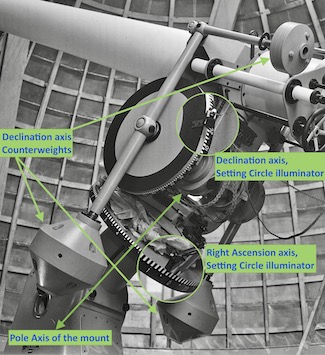 The mount developed by Dr. Franz Meyer is fundamentally a fork equatorial arrangement. The axes are made with hollow axles, and with parallel rods with their counterweights riding on threaded section of the rod; the weights were adjusted to balance the anticipated payload. Metal rods bore most weight of the telescope and counterweights, while the loads on the bearing axes were minimized.
The mount developed by Dr. Franz Meyer is fundamentally a fork equatorial arrangement. The axes are made with hollow axles, and with parallel rods with their counterweights riding on threaded section of the rod; the weights were adjusted to balance the anticipated payload. Metal rods bore most weight of the telescope and counterweights, while the loads on the bearing axes were minimized.
Right: Carl Zeiss Jena refractor fork equatorial mount as developed by Dr. Franz Meyer, this one completed in 1934.
Photo annotated by Company Seven to identify both axes and some features (59,126 bytes).
The quantity and position of counterweights attached permits about three-quarters of the length of the optical tube’s longitudinal axis to extend forward, from the Declination axis saddle. While only about one-quarter of the length of the optical tube assembly extending towards the observer’s position. The factors that this is a Fork Equatorial, and with very little of the telescope optical tube extending towards the observer means these telescopes are much easier with work with, their eyepiece(s) and payload positions more readily accessible, than with a German Equatorial mount.
Characteristic features of this mount included:
- the Right Ascension axis shaft, and it’s drive gear set are supported by a main bearing.
- The Right Ascension axle is counterweighted, this is attached to the Pole Axis under the base casting of the mount.
- Atop the Right Ascension axle and gear is a two pronged horn, this rotating east or west.
- The Declination Axis axle, bearings and spur gear ride atop of and are supported by this horn.
- The four main Declination axle counterweights are symmetrical, two on east and two on west side of the optical tube.
- The Declination axle counterweights enable the optical tube to be balanced while it extends far forward of the saddle.
The pole alignment, the adjusting of the rotational Pole Axis of the mount to be parallel to the rotational axis of the Earth, is made during the final installation in the observatory by adjusting the tip and tilt of the Right Ascension axis base casting.
Owing to the design, quality of materials and components, and how these mounts were precisely machined to high tolerances, it was possible to achieve a very precise and nearly frictionless movement with precise tracking of celestial objects.
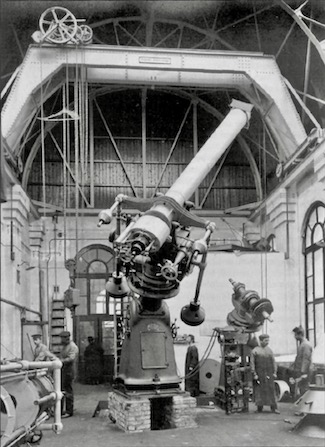
In 1903 the first telescopes incorporating a new achromatic doublet lens design, the Zeiss “E” were produced. With their decision to proceed into the manufacture of much larger astronomical telescopes, in 1903 they completed construction of a large assembly hall, and also built onto the roof of the factory an 8.5 m (25 foot) internal diameter observatory dome of wood and iron where they could install and test new telescopes and instrumentation. To this day, the dome features on most photos of the Carl Zeiss Jena works at Jena.
Left: Carl Zeiss Jena Astro Division's large assembly hall, with a roll-off roof, in about 1906. Nearing completion on the block foundation is a 300mm f/16.8 Achromat refractor mounted on “Meyersche„ (Meyer’s) mount destined for the Urania Sternwarte (Observatory), Zurich, Switzerland. Note how most of the optical tube assembly length extends forward of the Declination Axis saddle area, made possible by the counterweights near the rear of the optical tube that offset the tube’s leverage. The assembled weight of this telescope is about twelve tons, hence this facility incorporated a moveable overhead gantry crane. To the right of the nearly completed 300mm telescope is another Meyer’s mount under construction, note the open Declination Axis shaft and gear assembly (63,420 bytes).
In 1904 the first large Carl Zeiss Jena reflecting telescope, a 720 mm (28.3 inch) aperture system started in 1901, was completed and installed for the Heidelberg Observatory.
Many of the larger astronomical telescopes incorporated two or more telescope optical tubes attached in parallel to the primary telescope atop a tracking German equatorial mount. The largest of these, the primary telescope would have at least one smaller telescope attached in a location on the primary telescope so that the smaller telescope was accessible by an observer near the main telescope focuser. This smaller telescope would allow the user to observe much wider fields of view than the primary optical tube could show, and would aid the operator centering the primary telescope onto the target. Larger telescopes might have two or more of these Finder telescopes for those instances where one finder alone might not always be easily reached by the observer.
The photographic emulsions of the time mandated fairly long times exposing the film to build up an image of faint objects. So most larger telescopes incorporated another smaller telescope attached in parallel to help guide the main telescope during photography sessions. With about one third to one half the focal length of the primary telescope, a patient astronomer at the eyepiece of the photoguide telescope would center and observe a guide star. If during the session he perceived any drifting of the star, then he would make fine adjustments to the mount's tracking as necessary to maintain nominal tracking.
There were some configurations where the large primary telescope was complemented by a dedicated 'piggybacked' photographic telescope;, also attached in parallel, but that could photograph a wide field of view or take exposures in a shorter time. This could be a relatively compact reflector, or something resembling a camera lens with a plate film holder.
These auxiliary telescopes usually did not need to be as sophisticated as the primary telescope. So a Type B triplet Apo refractor or a large reflecting telescope might have an auxiliary Type E refractor photoguide telescope, with a Type C refractor lens finderscope.
Carl Zeiss Jena also offered double or even triple astronomical telescopes, where large primary telescopes were attached in parallel. These telescopes could incorporate different or identical large refracting telescopes, a Type E main telescope with a Type A photoguide telescope for example, depending on the intended uses. Or two large telescopes could be paired to facilitate sharing and teaching during the limited observing sessions, or mated with a third being used as photoguide telescope.
Many of the early Carl Zeiss Jena telescopes, turret and larger binoculars, military light and signal devices too were initially constructed with direct involvement of Paulÿ. The others working at Carl Zeiss Jena took notice of how quickly the new Astro Division had become organized and productive, and how well-regarded their instruments were becoming.
Under Paulÿ's management the quantity and selection of instruments completed at the workshop continuously increased, as did the selection of larger and larger telescopes. The Astro Division under Paulÿ completed or contracted to deliver some notable telescopes including:
- A triple refractor: one 150, with two 120 mm for Simejis (Simeiz) Observatory, in Crimea (1906),
- the 720 mm, their first reflecting telescope, for the Landessternwarte Heidelberg-Königstuhl (1901-04),
- the 640 mm objective prism for the Royal Observatory, Cape of Good Hope (1902),
- the zenith telescope for the Jena Observatory (1904-06),
- the 400 mm reflecting telescope for Innsbruck (1903-05),
- the 300 mm refractor for Urania Sternwarte, Zürich (1907),
- a 1000 mm reflecting telescope for the Hamburg Observatory, Bergedorf (1908-11),
- the 145 mm UV Petzval with 15° and 10° objective prisms for the Yerkes Observatory, Chicago(1905, 1911),
- the triple 300 mm and paired 360 mm refractors for the Observatoire cantonal de Neuchâtel (1908-10),
- the 340 mm astrograph for Bergedorf (1909-11),
- the 650 mm refractor for Babelsberg Observatory (1915),
- and the 1200 mm reflecting telescope for Babelsberg Observatory, begun in 1914 but unfinished because of the war.
The Carl Zeiss Astro Division catalogs and articles published described the availability of double and even triple telescopes. The could be identical or different optical designs or dimensions of optical tube assemblies mounted in parallel, complementing each other, all installed onto one equatorial mount. A striking example of this was the Carl Zeiss Jena Dreifachrefraktor (Triple Refractor) produced for the Observatoire cantonal de Neuchâtel, at Neuchâtel, Switzerland.
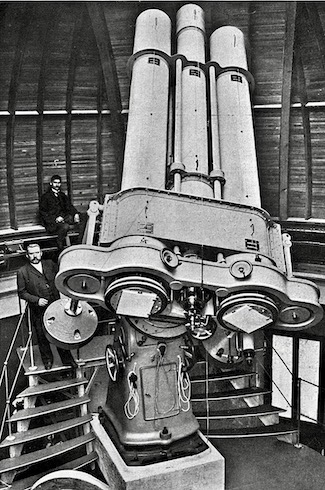 Prof. Adolphe Hirsch (21 May 1830 - 16 April 1901) was the founder and first director of the Observatory at Neuchâtel. Prof. Hirsch headed the institute from 1858 to 1901 and under his tenure the Observatory had become an international standard bearer in the field of chronometry, this owing to their precise 117 mm Meridian Transit telescope. Prof. Hirsch bequeathed his fortune to the city of Neuchâtel, asking the funds be applied to construct a new building with a large observatory dome at the complex. Prof. Hirsch’s successor as director was his assistant since 1892, Dr. Louis Vilmar Arndt (25 November 1861 - 24. February 1940), whose efforts ensured the new Art Nouveau extension building was constructed and upon completion in 1911 dedicated as the “Pavillon Hirsch”. Dr. Arndt and his team developed the goals and specifications for the forthcoming new large telescope, this would be dedicated primarily for astrophotographic applications including studies in the then little-understood ultraviolet regions of the spectrum.
Prof. Adolphe Hirsch (21 May 1830 - 16 April 1901) was the founder and first director of the Observatory at Neuchâtel. Prof. Hirsch headed the institute from 1858 to 1901 and under his tenure the Observatory had become an international standard bearer in the field of chronometry, this owing to their precise 117 mm Meridian Transit telescope. Prof. Hirsch bequeathed his fortune to the city of Neuchâtel, asking the funds be applied to construct a new building with a large observatory dome at the complex. Prof. Hirsch’s successor as director was his assistant since 1892, Dr. Louis Vilmar Arndt (25 November 1861 - 24. February 1940), whose efforts ensured the new Art Nouveau extension building was constructed and upon completion in 1911 dedicated as the “Pavillon Hirsch”. Dr. Arndt and his team developed the goals and specifications for the forthcoming new large telescope, this would be dedicated primarily for astrophotographic applications including studies in the then little-understood ultraviolet regions of the spectrum.
The new Dreifachrefraktor was contracted from Carl Zeiss Jena in 1908, and installed at Neuchâtel in 1912. The Dreifachrefraktor features a central 300 mm x 4500 mm focal length f/15 achromatic refractor, bordered at either side by 360 mm x 4500 mm focal length f/12.5 triplet telescopes incorporating quartz lenses to pass ultraviolet. Both 360 mm telescopes were configured not for visual use but equipped with glass plate cameras to photograph regions of the sky. Both astrographs were also provided with Carl Zeiss Jena spectrographs to study the chemical composition of stars, as well as their physical properties. The telescopes are supported by a Meyer style equatorial fork mount, this attached to an isolated pier; the lead counterweight at the end of the mount Right Ascension axis weighs nearly 1000 kg (~2,200 lbs.). The telescopes housed in the motorized rotating 8 meter diameter dome made of wood with insulation to help acclimate the telescope for evening operations.
Right: The Carl Zeiss Jena Dreifachrefraktor of the Neuchâtel Observatory in 1912 (88,372 bytes).
Click on image to see enlarged view (381,177 bytes).
While the production of the UV capable lenses were a noteworthy accomplishment, this was all for naught because the Earth's atmosphere absorbs much of the ultraviolet, especially for locations approaching sea level, and at higher latitudes. If they had only read Company Seven's article Ultraviolet Spectrum Primer, they could have saved great expense and some effort. Consequently, the astrographs were not really usable for the intended experiment and this only helped to reconfirm the impossibility of imaging distant celestial objects in the UV. The 300 mm telescope nonetheless remained useful visually, while the astrographs could take photos of objects in the visual spectrum and near infrared.
By 1912 the Carl Zeiss Astro Division had become well established, was delivering amazing products, and had no shortage of brilliant people working there. But Paulÿ's health was declining, so he resigned from Carl Zeiss Jena. By 1914 Paulÿ returned to Halle, residing at Wolfstrasse 14. It is said the hardships many German civilians were enduring owing to World War I contributed to his passing on 26 April 1917 in Halle-Nord (Halle), Sachsen-Anhalt (Saxony-Anhalt).
In December 2020 the Association for the History of Technology installed seventeen commemorative plaques in the inner courtyard of the former Carl Zeiss main factory. This is known today as the Ernst-Abbe Campus, on the west side of Building 15. The plaques recognize outstanding Zeiss employees (“Zeissians”), and Max Paulÿ is among those honored.
In 1913 Dr. Walter Augustin Villiger (b. 25 December 1872 in Lenzburg, Switzerland, d. 5 February 1938 in Jena) was promoted to head the Astro Department. His input as an engineer, and with first-hand experience of a trained astronomer, helped Carl Zeiss Jena devise and innovate. The designer Alfred Wieland and engineer Georg Orth collaborated to improve fabrication methods that resulted in even better quality and scale of production of lenses and mirrors for the telescopes and other devices produced at the Astro Department.
By 1900 the Zeiss company employed some 1,070 people, while Zeiss products overseas were typically represented by an independent company that had negotiated distribution rights for a country or territory. At the turn of the century in the United States microscopes and some other instruments made by Carl Zeiss Jena were represented by Eimer & Amend, advertising themselves as General Agents, at Nos. 205 to 211 Third Avenue, New York. Those in Jena were still subjects of the Duke of Anhalt, in the Grand Duchy of Saxe-Weimar, in the German Empire, but their world was in a matter of years about to change forever.
Another Changing Of The Guard: on 24 September 1903 Prof. Dr. Abbe notified the Stiftung that due to ill health he was retiring from active management. Abbe was succeeded by Prof. Dr. Siegfried Czapski (b. 28 May 1861, d. 29 June 1907) a physicist and optician who had been affiliated with Abbe at the University since at least 1884, and consequently came to work for Abbe at Carl Zeiss Jena in 1886. In 1891 Dr. Czapski became one of the company's three managing directors, and was subsequently appointed an authorized representative of the Carl Zeiss Stiftung.
In 1903 Oskar von Miller commenced efforts to establish a German scientific and technical museum in Munich, this would become the Deutsches Museum. The museum contracted Carl Zeiss Jena to produce a reflector telescope and a refractor telescope, these were delivered in 1908 and 1909. Prof. Dr. Czapski was elected to the Board of the Deutsches Museum. However, due to the World War and the subsequent rampant inflation, the completion and formal opening of the museum was delayed until 1925.
Dr. Rudolf Constantin Straubel (b. 16. June 1864 in Kleinschmalkalden, Thüringia, d. 2 December 1943 in Jena) earned his degrees in physics at the University of Jena, where he studied under Professors Ernst Abbe and Gottlob Frege. He continued his studies from 1886 to 1886 at the University of Berlin. He returned to Jena in 1886, completing his doctorate in 1888 under Carl Johannes Thomae, his dissertation being Zur Berechnung der Fraunhoferschen Beugungserscheinungen unter besonderer Berücksichtigung der Beugungstheorie im Heliometer (On the calculation of Fraunhofer's diffraction phenomena with special consideration of the theory of diffraction in the heliometer). Straubel became in 1893 a Professor at the Physics Institute in Jena. In 1901 Abbe persuaded him to come to work at Carl Zeiss Jena.
In 1903 on his recommendation, Prof. Dr. Straubel succeeded Dr. Abbe as Scientific Director at Carl Zeiss Jena, and became a member of the management board. He tended to promote the company and his employees, more than himself. Straubel had the intellect, management disposition, an experimental experience and theoretical knowledge of physics and other sciences. He brought to Zeiss attributes that were instrumental to the growth of the company through the 1930s and into the 1940s. The year 1933 would be when some would come to comprehend he was a man with uncommon loyalty and integrity, but more about his story is below in our discussion of Carl Zeiss Jena planetarium instruments.
Ernst Abbe died in Jena on 14 January 1905.
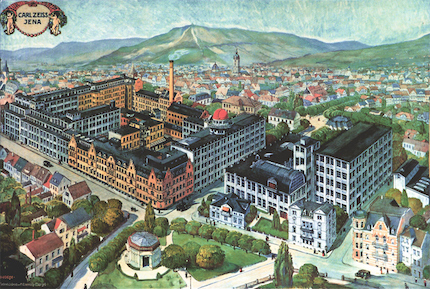 A memorial to Abbe was proposed by members of the local community, and of the Academy too, these included Eugen Diederichs (b. 1867, d. 1930) a local publisher. The Memorial Committee contracted Henry van de Velde, a well known architect and director of the (Großherzoglichen Weimarer Kunstgewerbeschule) Grand Ducal Weimar Art School, for the design. The Ernst Abbe Denkmal (Ernst Abbe Memorial) was approved and funded by the citizens of Jena. The donations amounted to some 115,000 Kaiserreich Marks, about one million Euros today. That amount was the equivalent then of about $28,050 (U.S. Dollars) at a time when the average worker earned something under ten dollars per week or about $500 per year.
A memorial to Abbe was proposed by members of the local community, and of the Academy too, these included Eugen Diederichs (b. 1867, d. 1930) a local publisher. The Memorial Committee contracted Henry van de Velde, a well known architect and director of the (Großherzoglichen Weimarer Kunstgewerbeschule) Grand Ducal Weimar Art School, for the design. The Ernst Abbe Denkmal (Ernst Abbe Memorial) was approved and funded by the citizens of Jena. The donations amounted to some 115,000 Kaiserreich Marks, about one million Euros today. That amount was the equivalent then of about $28,050 (U.S. Dollars) at a time when the average worker earned something under ten dollars per week or about $500 per year.
Left: color illustration of the Carl Zeiss Jena factory as it appeared in about 1910. This is the classic perspective observing the site from the west.
Note the domed octagonal Ernst Abbe Denkmal at Carl Zeiss Platz (Carl Zeiss Square) just left of center in the foreground; this is adjacent to Carl Zeiß Straße (Carl Zeiss Street) that traverses the front of the factory from the center left down to the bottom right corner. The observatory dome atop the Astro Division workshops is also depicted (183,521 bytes).
The Ernst Abbe Denkmal building is an octagonal structure built of limestone, with four entry portals each with hinged bronze doors. The floors are inlaid. The structure is covered by a bronze-clad dome made of reinforced concrete and incorporating glass panels; these panels allow areas of the interior to be illuminated in what some have described as a transcendental manner. The memorial houses a bust of Abbe atop a marble column by Max Klinger (b. 1857, d. 1920), with bronze reliefs by Constantin Emile Meunier showing Abbe’s lifework in areas of science, technology, and worker’s welfare.
The memorial was dedicated on Sunday, 30 July 1911 at the conclusion of a local weekend festival with Henry van de Velde and Max Klinger too attending the ceremony.
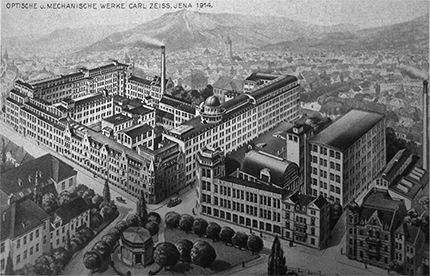
Right: black and white postcard labeled “Optische un Mechanische Werke Carl Zeiss Jena 1914”. This illustrates the Carl Zeiss Jena factory as it appeared in about 1914 and depicts the most pronounced changes: 1. just across the street, to the south east of the Ernst Abbe Denkmal building. And 2. the 6-story main complex factory building has been extended eastward by an addition, this just beyond the observatory dome (167,925 bytes).
As accomplished as he was for his impacts in many areas that would span the world, there is no doubt Ernst Abbe was locally a much admired and appreciated individual. Unfortunately some of those in recent generations lack the reverence or civility genes, and so his memorial is no longer routinely left open to avoid it being vandalized.
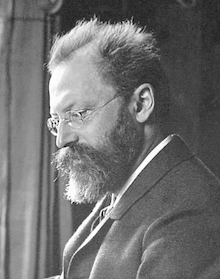
More Transitions: Dr. Czapski had long been suffering from ill health. His increasingly immense workload as representative of the Carl Zeiss Stiftung, responsibilities to Carl Zeiss Jena while also coordinating efforts with Schott glass works, service as a board member of the sDeutsche Museum, and other civic comittments must have left little spare time in his days. But the work combined with a happy marriage to Margarete Koch on 11 August 1887 that had produced eight children. It must have been challenging to be Dr. Czapski.
Right: Dr. Siegfried Czapski (1861 - 1907), Managing Director, and representative of the Carl Zeiss Stiftung (42,722 bytes).
Click on image to see enlarged view (312,464 bytes).
In June 1907 he became ill enough so that a doctor had to be consulted, when he was diagnosed with appendicitis. Consequent to the appendectomy surgery, Siegfried Czapski developed complications, then suffered a pulmonary embolism dying on 29 June 1907 at Weimar. He was buried nearby his respected predecessors at the Nordfriedhof, North Cemetery, in Jena to be joined years later by his wife, and some of their children.
In honor of Dr. Czapski, a street near the Carl Zeiss Promenade was named Siegfried-Czapski-Straβe. A publication prize for young researchers at the Friedrich Schiller University of Jena was named after Siegfried Czapski, as a student dormitory of the University was named “Wohnanlage Siegfried-Czapski-Straβe 2” residence hall.
AGNES HOLZMAN
née PRIEBATSCH
BORN 1863
DEPORTATION 1942
THERESIENSTADT
MURDERED 12 April 1942”
With the death of Dr. Czapki, Prof. Dr. Straubel was also appointed Managing Director of the Glastechnische Laboratorium Schott & Genossen (Glass Technical Laboratory Schott & Associates), becoming more casually known as the Schott glassworks. Straubel thus held a dual role as managing director of both Jena foundation companies. These are just two among the several top and Board positions he would hold, more about some of these follows later in this article. He would survive long enough to see him and his family suffer the coming storm.
Another famous Zeiss employee who came on in this era was Heinrich Erfle (b. 1884 - d. 1923) who in 1917 Patented a practical design for a wide angle ocular that since 1918 has appeared in many binoculars and telescopes.
Zeiss Binoculars and other Sporting Optics Boom:
As mentioned above, the first binoculars made bearing the Zeiss trade name were introduced in 1894;. Carl Zeiss Jena tended to list up to 60mm handhold-able models in their binocular catalogs. The serial numbers were up to about 30,600 by 1900, and sales soon skyrocketed to over serial number 200,000 by 1910, then by 1914 their serial numbers approached 500,000.
A consumer 12x 40 might carry a designation “TELEDUZ”, while the military contract version carries a “D.F. 12x 40” designation for example with the D.F. indicating Doppelfernrohr (binocular). Between 1907 and 1914 Zeiss listed at least five 6x 30 mm binoculars in production: “JAGDGLAS”, “SILVAREM”, “SILVAMAR”, “NAVY MARINEGLAS”, and a military “D.F. 6x 20”.
The the turn of the century also saw larger Carl Zeiss spotting telescopes and binoculars being developed. A second production handheld Carl Zeiss Jena turret model binocular was introduced in 1914, the “BIFORT” is a 10 + 18x 50 mm aperture binocular that was produced only in this one year, and it did not appear in their binocular catalog.
Larger binoculars and binocular telescopes were advertised only in their astronomical telescopes catalogs as these were produced by the Astro Division of Carl Zeiss Jena at their main factory in Jena. Commencing in 1897 Carl Zeiss Jena binocular telescopes of 60 mm and up to 240 mm aperture were produced by their Astro Division for the consumer and military markets. This series will bear their own serial number sequence, and their production cannot be correlated to consumer binocular production.
Their large binocular refractor telescopes were marketed more commonly as “doppelfernrohr” (double telescope), often marked with abbreviation D.F., in apertures of 60 mm, 80 mm, 110 mm, 130 mm, 150 mm, 210 mm, and as large as the “ASALAK” 60, 90 and 144x 240 mm. Some large observatory models were even “dreifaches fernrohr ” (triple telescope) arrangements. The joining of two smaller telescopes in parallel could allow true binocular viewing experiences, or for larger models they could be different in size and even in design so a refractor in parallel to a Cassegrain telescope for example could permit one to guide the other during long exposure imaging, or could accommodate various sensing instruments to operate in tandem.
The 60 mm, 80 mm and 110 mm models clearly resembled conventional binoculars, just scaled up. These large turret model binoculars were engineered to be tripod or pier mounted. For these binocular telescopes Zeiss opticians were able to fashion the lenses of up to about 110 mm aperture to perform well enough to suit the magnifications and relatively compact forms intended for these binoculars. The 110 mm “ASENGLAR” for example was only about 84 cm (33 inches) long. These usually featured a three eyepiece per turret arrangement, and were provided with an adjustable height wood field tripod or pier mount; the binocular or possibly the entire set with tripod could have been sold in a wood case. Each turret eyepiece magnification was labeled, 12x, etc. and the right prism cover bore the designation that could be “12.20.40x 80” for example in the case of the pre World War “ASEMBI”.
The early production Carl Zeiss Jena ASEMBI 80mm binocular featured magnifications of 12, 20, and 30x. These early models are easy to spot because they incorporate on each turret a mechanical spring-loaded locking mechanism, the later models feature and internal click stop arrangement.

Rear turrets and side views of a
Note the three eyepieces on each turret. This example was produced in 1910 and is in Company Seven's showroom collection (99,204 bytes).
Click on image to see enlarged view (257,987 bytes).
Soon after the start of the World War the ASEMBI, sans external turret locks, were produced for the military designated “D.F. 12.20.40x 80”; these were the the highest production wartime era turret binoculars. Because the higher magnification was impractical, there were some ASEMBI contracted for the Kaiserliche Marine (Imperial German Navy) with only two eyepieces per turret, these were designated “D.F. 12.20x 80” and bear the Navy marking. On the whole ASEMBI were the the highest production wartime era turret binoculars. The “D.F. 33.52.72x 110” were the largest aperture turret binoculars contracted by the German military during World War I.
After the war these resumed production as ASEMBI and other models consumer names, with D.F. models also being produced for the military. By the 1920’s offerings included “STARMORBI” (at least some produced at the Carl Zeiss affiliate Nedinsco), 12.24.42x 60 mm, and ASENGLAR 15.30.50x 110 mm. Later Astro catalogs of Carl Zeiss Jena show “ASALTANTI”, and the “ASPECTEM” and many others. In addition there were some custom products, or prototypes that do not appear in their conventional catalogs.
These, up to their very last production series of 80 mm binocular, employ comparatively short 500 mm focal length achromatic type C double objective lens. Their focal ratios being a fairly fast f/6.25 compares favorably to Zeiss's conventional refracting telescopes that have much higher focal ratios, on the order of f/10 to f/15. After World War II the Carl Zeiss Jena 80 mm models were the most commonly produced and these were usually recognizable as a large binocular, but beyond these the larger models more closely resembled paired telescopes and would be custom made.
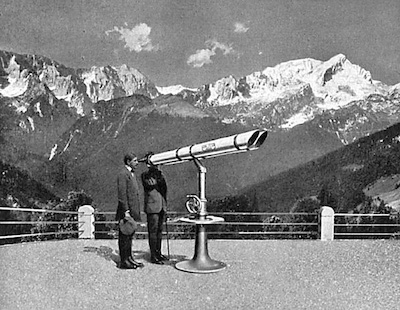 The Carl Zeiss Jena 80mm models were recognizable as large binocular, incorporating Porro Prisms, but beyond these the even larger models more closely resembled paired telescopes. To deliver even greater magnifications with brighter images they developed binocular telescopes that were truly paired telescopes, assembled and precisely aligned in parallel. These included the 33, 52 and 72x 110mm “ASALTUR”, and their 25, 58 and 116x “ASAL” of 130mm shown in the Zeiss Astronomical Instruments Catalogs. The Carl Zeiss Jena astronomy department produced even larger binocular telescopes of up to 240 mm, made with alt-azimuth support stands that could be ordered with either a transportable tripod or pillar base. The larger instruments stands were provided with rising center columns with geared manually operated elevation control mechanisms, this to help keep the eyepiece at a convenient height for the users. These were initially sold for terrestrial observing, most often at mountain lodges where the observers could study sights in the distance, even track parties of mountain climbers. These large binoculars were procured for use by border patrol, coast watching, law enforcement or military forces, with many being sold for export to other nations.
The Carl Zeiss Jena 80mm models were recognizable as large binocular, incorporating Porro Prisms, but beyond these the even larger models more closely resembled paired telescopes. To deliver even greater magnifications with brighter images they developed binocular telescopes that were truly paired telescopes, assembled and precisely aligned in parallel. These included the 33, 52 and 72x 110mm “ASALTUR”, and their 25, 58 and 116x “ASAL” of 130mm shown in the Zeiss Astronomical Instruments Catalogs. The Carl Zeiss Jena astronomy department produced even larger binocular telescopes of up to 240 mm, made with alt-azimuth support stands that could be ordered with either a transportable tripod or pillar base. The larger instruments stands were provided with rising center columns with geared manually operated elevation control mechanisms, this to help keep the eyepiece at a convenient height for the users. These were initially sold for terrestrial observing, most often at mountain lodges where the observers could study sights in the distance, even track parties of mountain climbers. These large binoculars were procured for use by border patrol, coast watching, law enforcement or military forces, with many being sold for export to other nations.
Left: a Carl Zeiss Jena model ASAL 130 mm achromatic binocular telescope with image erecting Porro Prisms, on an Alt-Az pedestal mount. Shown at mountain overlook in Europe c. 1919 (66,318 bytes).
Click on image to see to see enlarged view (257,987 bytes).
For terrestrial observing the most compact smaller telescopes could incorporate a Porro Prism, built-in to present an image that was right-side up and correct left to right. The larger telescopes were provided with an accessory Porro Prism that attached onto the focuser drawtube.
These telescopes tended to operate within modest demands in terms of magnifications, so their objective lenses tended to have a shorter focal length, and consequently a shorter optical tube, than those similar aperture telescopes intended for astronomy. Owing to the lens tech of their day however, refractors of this era were physically very long relative to their apertures, typically on the order of f/10 to f/15. The 110 mm ASALTUR for example, with its 4.3 inch diameter objective lens has an 51 inch focal length, this compares to the focal length of about 65 inches for the conventional Zeiss 110mm astro telescope of that era.
These telescopes were very long and heavy by todays standards as they were constructed with optical tubes of steel and brass, consequently these also mandated a massive tripod or pier (or pedestal) and Alt-Az head arrangement to support them. One of components that points to their intended terrestrial use is the cylindrical Lens Shades with a beveled leading edge, as shown at left, while the the Lens Shade made for the astronomical telescopes do not have this cutaway.
From the World War through 1945 the newly completed 60 mm, 80 mm and 110 mm binocular lenses were uncoated though it is possible that some sent in for refurbishment could have been coated. There are examples of World War I issue D.F. 80 mm with a “T” (Transparenz) designation (coated) and measuring reticle installed in the right side 12x and 20x eyepieces. It is also possible that decades after having been produced, a lens could be sent to a professional optical shop and have MgFl or modern multicoatings applied.
For World War II there were some “D.F. 12.20.40x 80”; binoculars manufactured at Carl Zeiss Jena for the Kriegsmarine (German Reich Navy) that featured lightweight alloy metals and lenses that were antireflection coated. These also bear the Nazi Eagle and letter M markings. After the war production of civilian and military versions of turret binoculars resumed until the 1970s when the turret design was replaced with a successor designated “20.40x 80/500 ”, each with a multi focal length (20x and 40x) eyepiece. Later the final versions of the ASPECTEM were offered with fixed magnification eyepieces, or with a Vario (zoom) 20x to 50x eyepieces.
The Famous Zeiss Trademark
 Zeiss products manufactured up to 1905 bear any one of several company identifying inscriptions but will always mention Zeiss in some form. Examples of their trade naming of items are exhibited at Company Seven and these include “C Zeiss Jena”, or “Zeiss”, or “Carl Zeiss”, or “Carl Zeiss Jena”; we see these stamped or engraved in block text. While some items bear their labeling in harder to read cursive writing, such as on the early binoculars and microscopes in our collection.
Zeiss products manufactured up to 1905 bear any one of several company identifying inscriptions but will always mention Zeiss in some form. Examples of their trade naming of items are exhibited at Company Seven and these include “C Zeiss Jena”, or “Zeiss”, or “Carl Zeiss”, or “Carl Zeiss Jena”; we see these stamped or engraved in block text. While some items bear their labeling in harder to read cursive writing, such as on the early binoculars and microscopes in our collection.
In May 1904 application was made for a new Zeiss trademark, then on 24 June 1904 the issuing certificate was approved by the Imperial Patent Office. This logo was fashioned with “Carl Zeiss” within in the border of an achromatic doublet lens outline that derived from the rear doublet of the acclaimed Carl Zeiss Jena Tessar photographic objective lens design.
The doublet lens logo shape was designed in 1902 by Emil Dönitz, and Engineer and then head of the patent division of Carl Zeiss. While the logotype was created by consultant Erich Kuithan (b. 1875, d. 1917) who was an accomplished artist and designer residing in Jena since 1903. We have observed that by no later than in 1906 this trademark started to appear on Zeiss products, and this was to become a world famous symbol of innovation and excellence.
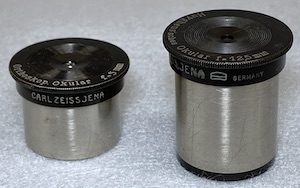
In our collection are items that show the evolution of Carl Zeiss Jena script and text styles of branding, some have bene shown above in this article. For comparison of branding used at the turn of the 20th century consider the example bearing “CARL ZEISS JENA” on the ocular shown at left. Later, as Carl Zeiss Jena instituted the achromatic logo trademark, there are smaller items that might not have accommodated the full logo, and so these may bear labeling “CARL ZEISS, JENA” followed by a simple achromatic doublet lens logo with no lettering inside, and with the logo followed by “GERMANY”.
Left: Carl Zeiss Jena branding examples on astronomical telescope eyepieces (oculars). At left is a Carl Zeiss Jena branded Orthoscopic 5 mm telescope eyepiece, designed by Abbe, that was made not earlier than 1897, but prior to introduction of their achromatic lens logo patented in May 1904. At right is a 12.5 mm Huyghens with interim with achromatic lens logo with no Zeiss labeling within that small logo.
Both are among an exhibit of Carl Zeiss Jena astronomical telescopes and accessories at Company Seven (27,854 bytes).
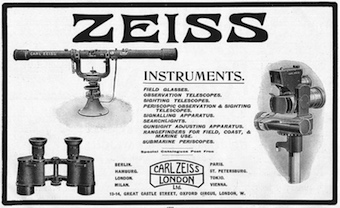
As Zeiss established representative offices in Berlin, Hamburg, London, Milan, Paris, St. Petersburg, Tokyo, and Vienna, their overseas offices might employ a variation of the logo. In the coming years authorized subsidiaries of Carl Zeiss Jena too (Zeiss Ikon AG for example) employed variations on the original trademark. An example of the use of the Zeiss logo by an overseas office appears in the advertisement at left that was placed by the Carl Zeiss London Ltd. office in 1914.
Right: advertisement by Carl Zeiss London Ltd. from 1914 (39,653 bytes).
Click on image to see enlarged view (234,979 bytes).
The advertisement mentions: Zeiss Instruments, Field Glasses, Observation Telescopes, Sighting Telescopes, Periscopic Observation & Sighting Telescopes, Signaling Apparatus, Searchlights, Gunsight Adjusting Apparatus, Rangefinders for Field, Coast, & Marine Use, Submarine Periscopes.
The original logo remained in use throughout World War II. After that war this logo remained the corporate trademark employed by Carl Zeiss Jena of East Germany until the reunification of Germany and that of the Zeiss companies in the 1991; this is explained later in this article. After World War II the Optron company, later Carl Zeiss West Germany, founded at Oberkochen in the State of Baden-Württemberg employed variants of this trademark too, without the “Jena”, until 1972. Almost two decades after the reunification of East and West Germany, we observed the original logo gradually coming back into use by Zeiss. Zeiss mentioned this is done “in order to maintain the industrial property rights”, and maybe at some corporate level that sterile legalize flies with somebody, but to us at Company Seven celebrate this as more a matter of Carl Zeiss gaining back some of the company’s lost soul.
We note however, there were companies that were completely unassociated with any Zeiss concern who have mimicked the doublet lens logo for their own use, no doubt attempting to capitalize on the fame and good reputation built by Zeiss. To our way of thinking, some of this tastelessness continues even today.
The 7x 50 Is Born:
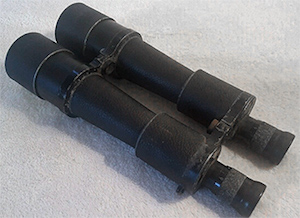 By the turn of the century glass and prism technologies were being improved so that Zeiss could explore the possibilities for developing larger aperture binoculars. Some of these would be marketed specifically for low light applications, for work in adverse seeing conditions, or where higher magnifications were desired. The anticipated uses for the improved hand held models included work at sea on boats and ships, hunting in low light conditions, etc. Studies by Zeiss demonstrated the Iris of a typical healthy adult eye, when dark-adapted, would dilate (open) to about 7mm diameter. Since a 7 mm Exit Pupil with 7x magnification pointed to 50 mm objectives, Zeiss developed their first 7x 50 mm binocular and assigned it the model name “Noctar”.
By the turn of the century glass and prism technologies were being improved so that Zeiss could explore the possibilities for developing larger aperture binoculars. Some of these would be marketed specifically for low light applications, for work in adverse seeing conditions, or where higher magnifications were desired. The anticipated uses for the improved hand held models included work at sea on boats and ships, hunting in low light conditions, etc. Studies by Zeiss demonstrated the Iris of a typical healthy adult eye, when dark-adapted, would dilate (open) to about 7mm diameter. Since a 7 mm Exit Pupil with 7x magnification pointed to 50 mm objectives, Zeiss developed their first 7x 50 mm binocular and assigned it the model name “Noctar”.
Right: the long and slender profile of the Carl Zeiss Jena Noctar, their first production 7x 50mm binocular. Note the cylindrical Porro I prisms housings. The retractable lens shades (shown extended) help to cut glare and ghosting from off-axis stray light and reduce likelihood of dew or spray build-up on the objectives (front) lenses (image 130,088 bytes).
The Noctar was announced simultaneously with a higher-magnification variant of the arrangement, marketed as the 10x 50 “Dekar”. There are some conflicts in the data at Company Seven about when this was formally introduced and put into production, but the information points to this happening either in 1910 or 1911 with this first model being discontinued in 1919. Company Seven has a Zeiss 7x 50 Noctar that by its serial number points to having been produced after 1919. There is also some debate about whether it was Carl Zeiss Jena or Ernst Leitz company in Wetzlar that produced the first 7x 50, we are simply not sure as most people who could tell us are either dead or senile, and we have not (yet) come upon dated documentation to provide either was the first on the market.
The slender arrangement of these first 50 mm models relied on the patented Abbe (or Abbe-König) prism design, sometimes referred to as Porro I, that was described as early as 1895 by Prof. Dr. Siegfried Czapski. The basic prism design is so sound that it remains in production, being employed in the Zeiss Victory series and other premium binoculars of today.
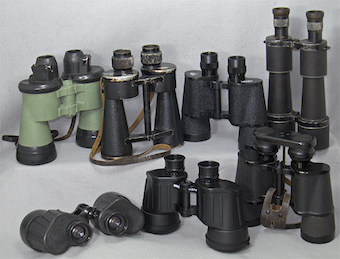 The 50 mm aperture became adopted as the standard configuration for applications where observing in low light or adverse circumstances required the light gathering power. While 7x was about the limit of what most people could hold the binocular with good stability over extended observing sessions. For marine work in particular the choice 7x is a good balance of magnification, reasonable field of view, and stability on these moving platforms. For decades to come, and even today, 7x 50 remains the most popular marine binocular.
The 50 mm aperture became adopted as the standard configuration for applications where observing in low light or adverse circumstances required the light gathering power. While 7x was about the limit of what most people could hold the binocular with good stability over extended observing sessions. For marine work in particular the choice 7x is a good balance of magnification, reasonable field of view, and stability on these moving platforms. For decades to come, and even today, 7x 50 remains the most popular marine binocular.
Left: several generations of Carl Zeiss 7x 50 Marine binoculars exhibited at Company Seven.
Counterclockwise and starting at top right: the tall and slender Carl Zeiss Jena NOCTAR - their first 7x 50 introduced in 1911, Carl Zeiss Jena 7x 50 BINOCTAR introduced in 1919 and produced through 1990, a Kriegsmarine issue 7x 50H introduced in 1938 (this example with AR Coatings captured at sea early in 1941), a Carl Zeiss Jena BLC-marked model designed specifically for U-Boat service produced from 1942 to 1945, a civilian Zeiss West Germany Marine binocular made 1964 to 1972, the latest and greatest Carl Zeiss 7x 50 B/GA T* made from 1979 to 2016 with this one having been made in 2016, a sophisticated Carl Zeiss Jena RLN-marked 1944 military issue model (image 148,191 bytes).
Click on image to see enlarged view (260,364 bytes).
This formula of maintaining a ratio of aperture to magnification that produces a 7-ish mm diameter exit pupil remains the world standard for marine and for astronomy uses. By 1914 Zeiss had introduced the more compact and manageable 7x 50 “Binoctar” to the consumer market, this is the binocular that was to become the model in terms of optical arrangement and external appearance for generations of marine and low light binoculars to come.
The individual focus Binoctar introduced in 1919, and it’s central focus version the Binoctem, along with some variants (D.F., etc.) would remain in production at Carl Zeiss in Jena, and later at the Eisfeld, East Germany factory of Carl Zeiss Jena, with some improvements in materials and design until 1990.
Carl Zeiss of West Germany too would introduce their own more compact and robustly constructed 7x 50, later culminating in what may be the finest 7x 50 ever made: the individual focus Carl Zeiss 7x 50 T∗ B/GA Nautik marine binocular Model 525505. These would be discontinued in 2016 ending more than one hundred years of Zeiss 50mm marine binocular production. One of our last arriving new 525505 has been retired to our museum collection exhibit (shown among the group of 7x 50 binoculars above at left), and so we exhibit a comprehensive span of Carl Zeiss 7x 50 history to date.
Back to Innovating: by 1904 Zeiss had developed and manufactured the “stereo comparator”. This instrument facilitates the measurement of relative distances and reveal changes within a star field by comparing one image against another simultaneously. This tool would become invaluable for the discovery of many celestial wonders including asteroids, comets, and another notable achievement - the discovery of Pluto by Clyde Tombaugh.
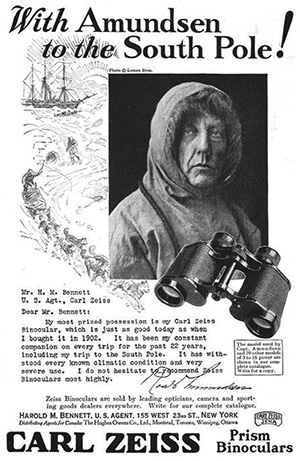 In 1908 Carl Zeiss placed responsibility for the design of a revolutionary prescription spectacle lens in the hands of scientist Moritz von Rohr (b. 1868, d. 1940). The result was that in 1909 Zeiss Punktal lenses were invented. Bt 1912 the new Punktal spectacle lenses were introduced to the market and for the first time a prescription lens could be bought that would provide identical visual quality even over a wide field of view.
In 1908 Carl Zeiss placed responsibility for the design of a revolutionary prescription spectacle lens in the hands of scientist Moritz von Rohr (b. 1868, d. 1940). The result was that in 1909 Zeiss Punktal lenses were invented. Bt 1912 the new Punktal spectacle lenses were introduced to the market and for the first time a prescription lens could be bought that would provide identical visual quality even over a wide field of view.
Zeiss products received acclaim from scientists, explorers, and naturalists. The Zeiss name was becoming more well known around the world because in part of the appeal to the consumer and professionals too of their photographic and sports optics, and of course for their microscopes too upon which the foundation for the company was laid. Of course many military organizations were contracting Carl Zeiss Jena to provide photo and visual optical and measuring instruments too.
Zeiss could capitalize on the achievements of their popular clients, often featuring testimonials from them in Zeiss advertising. Among the more notable people to vouch for Zeiss products was the Norwegian explorer Roald Amundsen. Amundsen attained world acclaim for leading the first expeditions that, beyond reproach, reached both the North and the South poles. He purchased his own Carl Zeiss Jena binocular in 1902, and he carried this with him over numerous expeditions over more than twenty two years, including during his pioneering and successful venture climaxing on 14 December 1911 when he and his team of four others were the first people to set foot at the South Pole. He commented about problems with their compass at -40 Degrees F, but made no mention of any problems with his Zeiss and Goetz binoculars though especially if this was a central focus model this was likely prepared with special cold climate lubricants. His letter complimenting Zeiss was first published in 1925 advertising.
On 1 November 1924 Amundsen wrote a letter to Mr. Harold M. Bennett, the representative for Carl Zeiss in New York:
-
“Dear Mr. Bennett:
My most prized possession is my Carl Zeiss Binocular, which is just as good today as when I bought it in 1902.
It has been my constant companion on every trip for the past 22 years, including my trip to the South Pole.
It has withstood every known climactic condition and very severe use.
I do not hesitate to recommend Zeiss Binoculars most highly.”
Right: Carl Zeiss Jena advertisement featuring testimonial letter from the world renowned Norwegian explorer Roald Amundsen (72,494 bytes).
Click on image to see enlarged view (159,597 bytes).
By the beginning of World War I, Carl Zeiss Jena had developed a total of about fifty-nine models of hand held binocular for consumer and military use.
Zeiss Growth, and Heading Green: Carl Zeiss Jena derived heating and electrical power from their gas and coal-fired steam power plant located near the southern end of campus, its smokestack features prominently in factory images of the era. The steam plant had been upgraded in 1902, but with rapid growth of factory this power plant was becoming inadequate. With Jena being in the Saale valley the winds tend to be westerly, often from the southwest. These winds are particularly prevalent in winter, just when the demands from their power plant might be highest. These winds tended to blow the power plant exhaust towards the north and east, right over the nearby Astronomical Department facilities and across the rest of the campus. The obstructive and corrosive effects of this progressively adversely impacted precision production, and testing.
 By the turn of the 20th Century cleaner hydroelectric power plants were going on line in Germany, some plants in the upper Saale were selling power to Carl Zeiss Jena. Anticipating future needs, Carl Zeiss Jena under the direction of Prof. Dr. Straubel set about to build their own hydroelectric power plant. Straubel was well acquainted with the sources and distribution of electricity and gas to power the Carl Zeiss Jena facilities, in part because one of his his first assignments, set personally by Abbe, had been to head the negotiation of contacts with the Jenaer Elektrizitätswerke (Jena Electricity Works).
By the turn of the 20th Century cleaner hydroelectric power plants were going on line in Germany, some plants in the upper Saale were selling power to Carl Zeiss Jena. Anticipating future needs, Carl Zeiss Jena under the direction of Prof. Dr. Straubel set about to build their own hydroelectric power plant. Straubel was well acquainted with the sources and distribution of electricity and gas to power the Carl Zeiss Jena facilities, in part because one of his his first assignments, set personally by Abbe, had been to head the negotiation of contacts with the Jenaer Elektrizitätswerke (Jena Electricity Works).
In 1909 Carl Zeiss Jena purchased a former lumber and pulp mill in nearby Burgau, just south of Jena on the Saale River and about a 3 miles (4.8 km) drive south of the main factory. In 1910 plans were approved, and the construction was contracted to Dyckerhoff & Widmann AG, of Nüremberg, who with at least eleven other companies from the area were involved in the construction. The power was to be provided by the water flow of the Saale River. As the river flows to the north and northwest, the water intake to drive the turbines faces south. To facilitate expansion, one of the old Jena-Burgau Saale bridge piers was replaced, another two were joined as one. A raceway to feed water from the river to the facility, while the weir was improved. Water flowing through three turbines made by Amme, Giesecke & Konegen AG, of Braunschweig, driving a three-phase generator by AEG Berlin. By the time power generation commenced in 1912 this project had cost Carl Zeiss Jena a total of about 400,000 M. The metal label plates, complete with serial number and other important information remain on this original equipment to this day. With the new and older facilities combining to produce a total output of 1,000 kW (1,248 hp) of electricity, annual power output reached 3 million kWh.
Right: the new Turbine Room at the Carl Zeiss Jena hydroelectric power plant in 1912, nearby at Burgau.
For scale note the person standing towards the rear of the room, right of center (50,903 bytes).
Anticipating the new plant and growing demands, a new electrical substation was built at the Zeiss factory power plant, this also distributed the power coming in from the several regional power plants. Carl Zeiss Jena would gradually acquire more land, and additional water rights to the Saale River.
In the fall of 1917, as Erster Weltkrieg (The Great War) raged, Prof. Dr. Straubel, who was already head of both major components of the Carl Zeiss Foundation, established the Wasserbauamt (Hydrotechnical office). This office would develop and coordinate operations of hydroelectric power plants. The old mill, with its still functional turbines, and auxiliary buildings, continued to generate electricity until 1938. In 1991 the recently reunified Carl Zeiss Jena GmbH judged much of their remaining properties in the area surplus to their needs, the power plant complete with the old mill and remaining buildings were sold to a master miller, who renovated the facility.
Zeiss Bau 15: as Carl Zeiss Jena factory productivity and products offerings were increasing even before the outbreak of The Great War in July 1914. More space would be needed to accommodate the growth in the main Carl Zeiss Jena workshops complex. Management also reasoned, if this new building could be constructed tall and rigid enough then long distance ranging equipment could be developed and tested here; these factored in management's calculations regarding the necessary height.
Carl Zeiss Jena management approached city authorities with a plan to build what was for Germany an unprecedentedly tall building. Being a military contractor, considered by the German government to be vital for the war effort, gave Carl Zeiss Jena management additional leverage with permissions, and resources necessary to build during wartime. Zeiss Building 15 would replace an earlier smaller structure at Ernst-Abbe-Platz 5 in Jena.
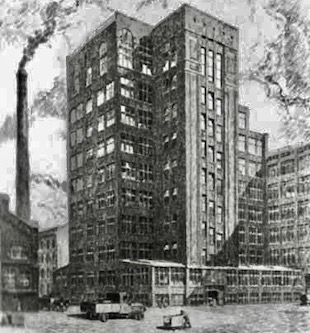 There were initially concerns about it's height and the consequential visual impacts on the skyline of their historic city. Then several planned aspects of the steel and masonry structure, a design largely based on successes observed in American Chicago style high rise construction, had been underwhelming to those who reviewed the plans and drawings. To win over approval by the city authorities and the community on the whole, Prof. Friedrich Pützer (25 July 1871 - 31 January 1922), a German architect, university professor and urban planner, was contracted to revise the plans. Prof. Pützer completed this within a few weeks. The Building Permit was granted on or soon after October 1915.
There were initially concerns about it's height and the consequential visual impacts on the skyline of their historic city. Then several planned aspects of the steel and masonry structure, a design largely based on successes observed in American Chicago style high rise construction, had been underwhelming to those who reviewed the plans and drawings. To win over approval by the city authorities and the community on the whole, Prof. Friedrich Pützer (25 July 1871 - 31 January 1922), a German architect, university professor and urban planner, was contracted to revise the plans. Prof. Pützer completed this within a few weeks. The Building Permit was granted on or soon after October 1915.
Left: Carl Zeiss Jena factory complex Building 15 in about 1916, viewed from east-southeast. The basic arrangement of the building, if seen from overhead, resembles a “T” but with a very short vertical component seen here.
The illustration etched onto the historical information plate of the building today is based on this image (62,790 bytes).
The contract to build this structure too was awarded to Dyckerhoff & Widmann AG, of Nüremberg. The main building structure was completed, and the first sections occupied in 1916. The last spaces to be completed were occupied in 1917.
This eleven story building had an overall height of 42.48 meters (139.4 feet), thus it was the first, and now still the oldest, high-rise (in German “Hochhaus”) building in Germany. The building was design to house factory offices and some of the Zeiss optical production and assembly workshops. During the air raid bombings of World War II the building was damaged, subsequent fires gutted several floors but the structure&s overall integrity survived.
After the war this was rebuilt, and eventually even expanded, but always maintaining the basic exterior appearance. At the time of the reunification the Carl-Zeiss-Stifftung elected to not retain much of the former Carl Zeiss Jena VEB facilities; this building was among those sold to private interests for redevelopment. Today, the completely renovated and updated 11,700 m² building houses offices and residential apartments, it continues to be regarded as architecturally significant.
This was among the projects to which Prof. Dr. Straubel would contribute, even as he had and would continue contributing for the advancement of the company he came to in 1901. A few decades later he and his family would not be well-treated by Germany, or by those of the Carl-Zeiss-Stifftung Board members of that era.
End of Empire: 1914 to 1918
The German Empire was one of the Central Powers that became embroiled in the “War to End All Wars”. However, the German side was doomed to defeat in part because up to 1914 Germany had become heavily dependent on imports, most notably of food and raw materials. Germany could not control the sea lanes, and it was geographically surrounded by adversaries. Furthermore, their war economy was never all that well organized and often simply mismanaged, so that up to the end of the war it never fully adapted. Shortages of materials for war, food and conditions for their civilian population on the home front deteriorated too.
The war had seen steady increases in government contracts for equipment from Zeiss. In response to the increased demands the company rolls swelled from the 5,300 arbeiter und angestellte (workers and employees) of 1914, up to a peak of 11,043 workers in 1917.
Right: looking east along Carl Zeiß Straße towards the Carl Zeiss Platz (Carl Zeiss Square), with the Carl Zeiss Jena factory beyond and the observatory dome to the left of center. The domed octagonal Ernst Abbe Denkmal just left of center in the foreground (231,546 bytes). Image taken prior to 1914, some afternoon between the fall to early spring season, possibly some Sunday or holiday since the area is sparsely populated.
Click on the image to see and enlarged view (752,209 bytes).
The entry of the United States into the war on the Allied side in April 1917 tipped the balance of manpower and material well in favor of Germany’s adversaries. The Armistice of 11 November 1918 ended the fighting between Germany and the Allied Powers. It would be some months later when the Treaty of Versailles was signed on 28 June 1919, that the war between Germany and the Allied Powers was formally ended. The German Empire was among those on the losing side of the war, but it would be Germany that suffered the most harsh terms and demands for reparations of all the Central Powers; the treaty contained a War Guilt clause requiring “Germany accept the responsibility of Germany and her allies for causing all the loss and damage”. This treaty would all but guarantee World War II.
The devastatingly effective Allied blockade of food and material to Germany continued until July 1919. The post war environment of 1919 to 1923 was one of marked decline in demand for products from the government, as was the case for many manufacturing companies on both sides of the war. However, the financial chaos that enveloped Europe, and especially Germany after the Treaty of Versailles, resulted in not only in a predictable decline of demand for military related optics but this also stifled demand by consumers too. The civilian population were strapped by the consequences of the war; they could not ameliorate the precipitous decline in demand even for manufactured consumer products. This led to dramatic lay-offs of personnel and reduction of production.
Zeiss International Marketing, Alliances, and the War: before the beginning of World War I Zeiss had established the “Carl Zeiss, Jena Optische Werkstaette” with marketing branches in Berlin, Frankfurt, Vienna, London, and Hamburg with other sales agents around the world. Other firms offered Zeiss products including: Eastman Kodak who manufactured a Zeiss “Anastigmat” lens under license for its cameras; and Ross Ltd. of London.
After the war the Treaty of Versailles imposed strict (and arguably unfair) terms and conditions on Germany. Economic and political conditions in Germany continued to free fall for some time after the war with runaway inflation, and rampant shortages; conditions were difficult for German manufacturers. In the German photographic industry for example, the prices published by manufacturers were being quoted as subject to change, and with the factory retaining the right to delay promised delivery dates. As explained by one author in May 1920, “In its effects, it even goes so far as frequently to violate the principles of commercial etiquette.”
From shortly before World War I, and after the War To End All Wars during the interval leading up to World War II, the Carl Zeiss firm established subsidiaries in European countries to produce optics. Some of these subsidiary companies produced military optics (binoculars and range finding optics for example) which if made in Germany might have aroused international concern. It is not unusual to find the traditional Zeiss trademark with the city of origin in place of “Jena” listed as “Petersburg” Russia, or “Nedinsco Venlo Systeem Carl Zeiss Jena”; both being located outside of Germany.
Possibly to avoid past or future legal litigation, after World War I Carl Zeiss Jena established a distributor in New York, this was “Bennett & Co.” owned by Mr. Harold M. Bennett and initially located at 110 East 23rd Street in Manhattan, New York City. A business man with proven experience, Bennett had already spent considerable time visiting Dresden and Jena, learning about the technology and nurturing business relations that would later help him lock in his position with Zeiss. In 1920 he was the appointed representative for Ica-Contessa Cameras. By 1922 the organization had moved some blocks away to occupy the entire 11th floor of the building at 153 and 155 West 23rd Street, New York City. This was partitioned into a showroom to host visits from professionals and members of the trade, stock rooms, and business offices. The exhibits included: laboratory instruments including microscopes, spectroscopes, refractometers, medical and diagnostic instruments, spectacles, field glasses, opera glasses including the Teleater, astronomical telescopes with some equipped for astrophotography, terrestrial observation telescopes, Ica-Contessa cameras and lenses, and magnifiers including folding and models suitable for craftsmen including watchmakers. In December, 1925 this organization was incorporated as “Carl Zeiss, Inc.” at 485 - 5th Avenue, Manhattan, New York City, N.Y. Their regional representative agent offices were also established in Chicago, Illinois and Los Angeles, California.
Seventy-five Years: 1846 to 1921: After the war Carl Zeiss Jena management revised their production to meet the new realities; there was little demand for Zeiss Periscopes even by allied navies for example. However, the post war era found many countries with thriving consumer markets demanding cameras and other goods. So on the whole, things could have been worse: 1921 found 5,300 gainfully employed workers celebrating the seventy-five year anniversary of the founding of the Carl Zeiss company.
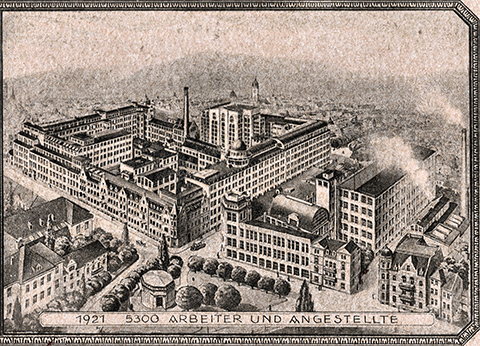
Above: illustration from 75 Year Anniversary commemoration of the Carl Zeiss Jena showing growth of the factory by 1921 (316,749 bytes).
As in the images above from 1911 and 1914, note the domed octagonal Ernst Abbe Denkmal at Carl Zeiss Platz just left of center in the foreground.
This seems to be an updated and enhanced version of the illustration from 1914; note the horse-drawn carriage and vehicle by the intersection,
and even the number of pedestrians appear identical, and they are all located at the same spots.
Click on image to see enlarged high resolution view (1,104,140 bytes).
A Downsized Zeiss Sporting Optic, the Turmon: 1921* saw the introduction of a really nifty very compact sporting optic, the Carl Zeiss Jena TURMON Faltmonokular (folding monocular). A monocular can be a solution for those needing extreme portability, or hoping to save money as it cost less than a bulkier and heavier binocular. It could be all that a one-eyed observer needs. Heretofore, Carl Zeiss and other optical companies offered monoculars that tended to be based on one-half of a binocular, so one could buy many of the more compact binoculars of about 8x 20, 8x 30, even a 7x 50, in a more compact form than a full binocular.
*Company Seven has a F.8x 21 with a serial number that points to it having been completed later in 1919 or early 1920. It may be some were made before they were fully in production a year or so later when they became available world-wide.
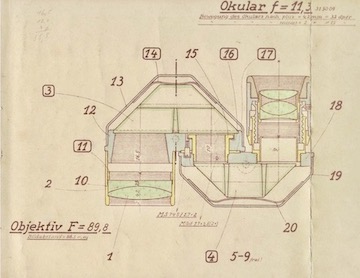 What distinguishes the Turmon is how, with its two articulated body sections, these provide a form more compact than the typical monoculars of the day. Each articulating half incorporates a Porro prism, one with an eyepiece attached the other with an objective (front) lens assembly. When the Turmon is to be stowed then the two sections swivel to form a flat in-line profile only 24 x 45 x 70 mm, better suited to slip into the furnished leather pouch and into a shirt pocket. If the user is observing when the Turmon is flat then the image appears correct left-to-right, but is upside down. When the two body sections are rotated 90° to a form resembling a coiled snake then this presents to the observer an image that is correct side up, and properly oriented left and right.
What distinguishes the Turmon is how, with its two articulated body sections, these provide a form more compact than the typical monoculars of the day. Each articulating half incorporates a Porro prism, one with an eyepiece attached the other with an objective (front) lens assembly. When the Turmon is to be stowed then the two sections swivel to form a flat in-line profile only 24 x 45 x 70 mm, better suited to slip into the furnished leather pouch and into a shirt pocket. If the user is observing when the Turmon is flat then the image appears correct left-to-right, but is upside down. When the two body sections are rotated 90° to a form resembling a coiled snake then this presents to the observer an image that is correct side up, and properly oriented left and right.
Right: Carl Zeiss Jena factory drawing showing cross-section view of Turmon F.8x 21 monocular (50,631 bytes).
Click on image to see enlarged higher resolution view (179,570 bytes).
A 21mm aperture 89.8 mm focal length doublet achromatic objective lens focuses the light to pass through two Porro prisms, then on to the 11.3mm focal length Kellner eyepiece; this provides 8x with a true field of view about 6.3° wide. The focus is accomplished by rotating the eyepiece upper assembly, dialing up to plus 4.2 mm or minus 2 mm for a range of from +32 to -15 diopters. The permits focusing to as near as 1 meter (3.3 feet), or even closer with optional auxiliary lenses. The eyepiece barrel features a diopter scale (± 25) embossed and inlaid in white paint so the user could quickly adjust it for their eyes at a desired distance, or to reach some alternate focus distance distance quickly. With this threaded rotating eyepiece focus arrangement there is less to go wrong than with the typical central focus binocular, and water-resistance can be better.
With ours, even those made in the 1920s, we at Company Seven have observed up to four of Jupiter's moons astride the giant planet.
The Turmon was introduced bearing the Carl Zeiss Jena logo with the designation F. 8x 21, and with a serial number; the bodies are black with all labeling filled in white paint. We at Company Seven expect the F. was their abbreviation for Faltmonokular, German for folding monocular. Some suggest this F. represented Fernrohr that translates to telescope, or Feldstecher for binocular; both that remain common German terms for sporting optics. However, none of their other monoculars of the time bore the F. prefix, so we are inclined to believe Faltmonokular. By the mid-1920s the designation labeling was changed to TURMON 8X.
The serial numbers were a seven-digit number. These were assigned as a block of sequential numbers to each production lot, as was typical of their general Carl Zeiss Jena sporting optics (binoculars, spotting telescopes, etc.) production. So, a production lot of Turmons might have a consecutive series of numbers starting with 123xxxx, but this does not necessarily mean the entire lot of some thousand, or mores were completed in the same year as those made when the lot commenced being serialized.
The brown leather pocketable case furnished with the Turmon through 1929 is shown in the photo below at left. These first generation cases consist of two panels of durable leather joined together, one outside and another for the interior lining. These leather panels were then formed in a rectangular mold, then the panel borders were sewn together resulting in a hard pouch with flap lid. The case has one continuous sewn seam extending along a side, across the bottom, and up the other side of the case. These 1920's leather cases feature a lid flap with riveted brass handgrip integrating a post that snaps into the brass spring-loaded fastener of the case body. The brass fastener of the original case, and that of some interim cases made in 1929, appear a bit more elegant than the fasteners of later cases as these earlier ones have rounded edges with scalloped sides, and with a wider thumb tab. The case features the Carl Zeiss Jena achromat logo embossed between the brass fastener and the pouch opening.
Left: a very early Carl Zeiss Jena Turmon F. 8x 21 monocular, early black textured lacquer finish and black anodized objective lens cell,
shown rotated and configured for visual use. Also shown is its provided stitched leather case, with brass flap post and scalloped fastener.
Among the exhibits at Company Seven's showroom museum collection (38,779 bytes).
Click on image to see enlarged higher resolution view (224,137 bytes).
In 1929 Zeiss changed the case arrangement to what we at Company Seven term a first version second generation pocketable case, this built with three leather panels. Two side panels support the main panel extending from the open flap edge, down along the back and bottom, up to the front of the case. The second generation cases are easily distinguished by these sewn-on side panels, and by the thread lines running along the edges of the case front and back, and in a U-shaped pattern along the sides. At least some of these second generation cases of 1929 were built incorporating the original style lid fastener (with scalloped edges). After stock of the original fasteners were exhausted, certainly no later than in 1930, Zeiss changed to a simpler mechanism with a rectangular form and with a smaller release tab. The later version of these prewar cases retain the Carl Zeiss Jena achromat logo but also have MADE IN GERMANY embossed between the Zeiss logo and the brass fastener plate.
It is rare to find these early case fasteners intact and functioning, many have at least part of the fastener mechanism missing. It could be that some people became frustrated and ripped the lid thereby damaging the fastener, or the mechanism failed over time.
By about 1931 the final version of the second generation leather case became standard. The leather profile was the same, but the lid fastening mechanism was changed to a more conventional, maybe more 'idiot proof' spring-loaded sliding “tuck lock”, one where the steel lid snap mechanism slides through a steel catch clasp. These prewar cases have a lid incorporating a leather flap grip, with a steel latch mechanism and squared-end fastener that continued to be the norm through World War II, and soon after. Going into the 1950s the lid dispensed with the hand-grip, while the steel fastener was changed slightly to a different style with a rounded end tip. All of these second generation cases continue to incorporate the Carl Zeiss Jena achromat logo embossed above the spring-loaded fastener, and MADE IN GERMANY embossed between the Zeiss logo and the spring-loaded fastener.
In the 1960s the provided case was changed to a simpler black leather pouch, one with a flap lid that slid through the loop spanning the fabric lined pouch compartment.
Right: among the last of the Carl Zeiss Jena labeled Turmon 8x 21 monoculars produced, shown with provided textured black case.
Among the exhibits at Company Seven's showroom museum collection (43,206 bytes).
Click on image to see enlarged higher resolution view (260,619 bytes).
The cased Turmon were marketed world-wide, and even if half the cost of a similar binocular, it was not inexpensive to manufacture. In the United States the cased Turmon cost about $25 (USD) from the 1921 and into the early 1930s, increasing to $37 by the mid 1930s. Keep in mind that adjusted for inflation the Turmon would cost about $800 in 2024.
Zeiss was enthusiastic about the potential for other markets for the Turmon, they developed options including eight attachable lenses, ranging from +2 diopter to +16 diopter, to increase its magnification, and filters that snapped on to the eyepiece. With an optional close-up lens this reduced the near focussing distance so that the Turmon could be employed as a long-distance microscope. For these inspection uses Carl Zeiss Jena marketed an optional stand, with or without a back-illuminating object platform, that is illustrated in their “ZEISS Feldstecher Als Fernrohrluper” (literally translated to Binoculars as a Telescope Magnifier) brochures.
Consumer optics produced much before World War II predate the availability of antireflection lens coatings technologies, so the Turmons made up to the war have lenses and prisms that are uncoated. Late 1940s models may have a reddish antireflection coating, having a chemical antireflection coating process termed bloomed. The Carl Zeiss Jena consumer optics, including the Turmon, transitioned to fully antireflection coatings by about 1948, at first Magnesium Fluoride with the distinctive purplish tone, and by the later 1960s to fully multicoated. The final evolution of the multicoatings appeared about 1978, continuing through 1990 when production ceased.
From the onset of production to about 1936 or 1937 the Turmon metal alloy focus dial of the Turmon feature a diamond-checked engraved pattern grip, this is as shown in the image above at left. The early Turmons weigh about 114 grams owing to their machined brass components, thick mounting plates, and longer eyepiece lens housing. The mix of brass for the objective lens barrel and cell and for the eyepiece barrel, and aluminum alloy for the prism housings, makes these early Turmons durable and resistant to corrosion.
By 1936 or 1937 the eyepiece focus grip had been changed from the longer barrel with diamond check pattern to a shorter barrel with a simpler longitudinally-oriented linear engraving. The metals were shifting away from brass (such as in the front lens cell) to aluminum and similar lightweight alloys so these are somewhat lighter at about 100 g. By 1970, the time the postwar models were being made at their sporting optics factory in Eisfeld, the weight had pared down to about 82 grams. The lighter weight was owing to use of alloys and plastics, lighter moulded prism housings with some textured to appear leather-clad.
After World War II Carl Zeiss Jena VEB changed from the original painted logo and product-designating label, to a black recessed label plate bearing an embossed factory logo or marketing trade name, and TURMON 8x21. Initially the serial number was painted on in white, along with the product labeling. Later the serial numbers were engraved onto a recessed flat at bottom of the prism housing proximal to the eyepiecee; these small black numbers against a black background are easy to overlook. The Turmon, or its provided case, will usually be labeled either “GERMANY” or “Made in Germany”, while post-war production Turmons may bear the “DDR”. Those produced after the 1960s for export were marketed with the “JENA” or “aus JENA” trade name, with many of these bearing no obvious Carl Zeiss Jena serial number.
For people with good mechanical competence, discipline, and some luck the Turmon are simple enough to disassemble for cleaning. It is possible to upgrade some components of an older model, replacing parts with those from later years; we advise against this as 100% success is not always assured, and this would bastardize any historic value.
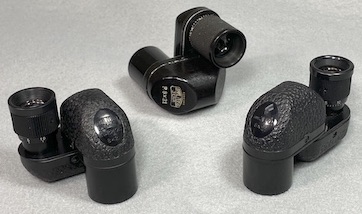
Above left to right: one of the last “Carl Zeiss Jena” labeled Turmon monoculars, a 1922 Carl Zeiss Jena Turmon F. 8x 21,
and “aus JENA” branded Turmon from 1980s. Among the exhibits at Company Seven's showroom museum collection (35,836 bytes).
Click on image to see enlarged higher resolution view (190,761 bytes).
Subcontracted, licensed Turmons
Carl Zeiss Jena was contracted by third parties to produce some products, including the Turmon, bearing their private company labels. While some production of the Turmon was also transitioned to overseas manufacturers. We are not certain which monoculars appearing identical to the Zeiss Turmon were made in part, or completely, at Jena for export under these labels. It is more likely the designs were licensed for production overseas. The most notable third-party labeled Turmons bear the labeling of optical manufacturers, and because the Turmon is so simple an item to produce, we at Company Seven expect these may have been produced overseas. The candidates for production overseas after World War II include:
- PANORA 8x21 marketed by Wray Optical Works London. Each Panora each bearing a five or six-digit serial number assigned by Wray.
- PARVO 8x21 is another nearly identical version of the prewar Turmon originated from Dollond & Aitchison of London, Ltd. Each Parvo bears a six-digit consecutive serial number, the sequence bracketed by those made by Wray.
The Wray and Dollond monocular each included a two-snap leather pouch. Both of these examples, made up to at least 1963, also feature antireflection coatings that were initially, around 1950, bloomed while later the lenses had magnesium-fluoride coatings applied. Both labeled products continued with the checked eyepiece grip, well after Zeiss Jena had transitioned theirs to the linear engraved grip. It is possible both monoculars marketed as Wray and as Dollond were produced at the same shop in the United Kingdom.
- Filotecnica Salmoiraghi S.p.A. of Milan had since 1865 a history of technical design and production, one of its original founders being Ignazio Porro, inventor of the image erecting prisms. Soon after World War II, Filotecnica introduced their version of the Turmon marketed as the Mococolo prismatic 8x21, their Mod. 2120. The Filotecnica version appears similar to that made by Zeiss Jena at the time, labeled 8 x 21 over their company F triplet lens logo, and below that FILOTECNICA. Construction of the ribbed eyepiece housing (similar to the Turmon of this era, but with eye lenses not as recessed), the prisms covers, frame, objective cell, and objective lens retaining ring (with prominent embossed edge grip, unlike that of the German Turmon), are machined or stamped of an aluminum alloy then painted in a textured black. The Filotecnica 8x 21 lacks the diopter scale, and weighs about 7 grams less than the Turmon of this era. Because of differences between the versions we surmise it is probable some licensing arrangement with Carl Zeiss Jena allowed Filotecnica to fabricate optics for incorporation into their metalwork, with final assembly by Filotecnica in Italy however, we have no information to confirm or to disprove this.
After the reunification of the two Germany's and the demise of Carl Zeiss Jena, descendants of the Turmon continued to be produced. We see the identical monocular being marketed by LZOS of Russia, their model “Monocular Pupil-8” (of the eye, 8x) labeled “3рачок 8x21” and “Made In Russia”. We are not certain, but this Russian version appears to have been marketed in the early 1990s. After then, in 1990 a revised Turmon was made under the “Docter Optik” trade name, the name of the Wetzlar-based company that acquired the former Carl Zeiss Jena VEB sporting optics factory at Eisfeld, resuming operations there with 550 employees on 1 August 1991. The Docter Optik version of the Turmon has a more contemporary, streamlined appearance featuring panels and mechanical construction of composites and plastics, it is just as functional and likely a bit better sealed than the Turmons formerly made by Zeiss Jena. Even after the demise of Docter Optik sporting optics production we observed descendants of the Docter version of the Turmon popping up under other brands, including the “Bresser” brand marketing it as their “8x21 Travel Monocular”. The basic arrangement continues to pop up here or there under other brands.
So, the humble little Turmon has enjoyed a production life, in one form or another, of more than one hundred years!
Inspiring, or imitated?
The Turmon may have been the original articulated Porro prism monocular, or the Turmon developers may have been inspired by a very similar product marketed as early as 1919 by Optische Anstalt C.P. Goerz of Friedenau in Berlin. K.P. Goerz was a subsidiary factory established in 1908 at Bratislava, Slovakia (by 1919 Czechoslovakia), and it was there where they produced their 8x20 Faltmonokular (folding monocular) labeled:

(serial number)
 Their monocular Porro prism housings have more of a pyramidal form that are narrower and shorter than those of the Turmon. Accordingly, the Goerz eyepiece and objective lens barrels are longer than those of the Turmon. To erect the view one rotated one of the Porro prism assemblies against the other, as with the Turmon. However, unlike the Turmon the Goerz Porro prism sections can swivel to either side and this may better accommodate a left-handed user. Another distinguishing characteristic is the objective lens barrel of the Goerz tapers from a narrow section near the prism, widening to fit the objective lens. The Georz 8x20 Porro prism monocular weighs 105 g. Goerz produced optional magnifying lenses and a stand for their monocular that are similar to those offered by Carl Zeiss Jena, so the monocular could be adapted for use as a microscope.
Their monocular Porro prism housings have more of a pyramidal form that are narrower and shorter than those of the Turmon. Accordingly, the Goerz eyepiece and objective lens barrels are longer than those of the Turmon. To erect the view one rotated one of the Porro prism assemblies against the other, as with the Turmon. However, unlike the Turmon the Goerz Porro prism sections can swivel to either side and this may better accommodate a left-handed user. Another distinguishing characteristic is the objective lens barrel of the Goerz tapers from a narrow section near the prism, widening to fit the objective lens. The Georz 8x20 Porro prism monocular weighs 105 g. Goerz produced optional magnifying lenses and a stand for their monocular that are similar to those offered by Carl Zeiss Jena, so the monocular could be adapted for use as a microscope.
Left: for comparison are a Carl Zeiss Jena Turmon F. 8x 21 monocular at left, alongside a K.P. Goerz 8x20 Faltmonokular.
Among the exhibits at Company Seven's showroom museum collection (27,405 bytes).
In 1923 the founder of the company Carl Paul Goerz died, while the postwar company was in dire straits. By 1926 with little left to leverage, what was left of the Goerz Trust merged with (more accurately, was acquired by) Carl Zeiss Jena. This with the mergers of Contessa-Nettel, Heinrich Ernemann AG, and ICA AG, formed Zeiss-Ikon. With Carl Zeiss Jena holding the majority stake, production of many competing products, including the Goerz 8x21, was gradually discontinued by the end of 1927. Based on our sobserved serial numbers, the production of these monoculars may have amounted to about four thousand.
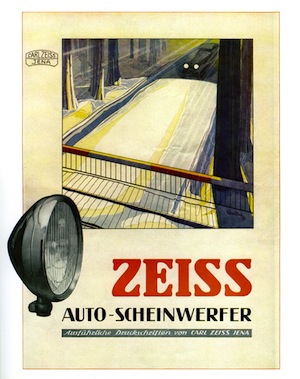 Zeiss And Diversification: the growing production capability at Jena continued into diverse areas including manufacture of automobile and boating acetylene headlights and spotlights beginning in 1911, which were initially ground of crystal glass with a silver plated parabolic reflector. By October of 1912 this was incorporated into “The Auto Department”. By 1921 electrical headlights were in production at Jena. Shortly after World War I the demand for these components increased with production expanding between 1927 and 1929 into related areas of spot lamps, and fog light headlamps. But, by 1933 Zeiss sales in these areas had declined to insignificance as may other companies entered the market, at times with improved designs and often selling at far lower prices. However, the basic knowledge gleaned about how to make precision reflectors was applied to also producing larger searchlights of immense proportions, these used to spot aircraft especially during World War II.
Zeiss And Diversification: the growing production capability at Jena continued into diverse areas including manufacture of automobile and boating acetylene headlights and spotlights beginning in 1911, which were initially ground of crystal glass with a silver plated parabolic reflector. By October of 1912 this was incorporated into “The Auto Department”. By 1921 electrical headlights were in production at Jena. Shortly after World War I the demand for these components increased with production expanding between 1927 and 1929 into related areas of spot lamps, and fog light headlamps. But, by 1933 Zeiss sales in these areas had declined to insignificance as may other companies entered the market, at times with improved designs and often selling at far lower prices. However, the basic knowledge gleaned about how to make precision reflectors was applied to also producing larger searchlights of immense proportions, these used to spot aircraft especially during World War II.
Right: advertising poster for the Carl Zeiss Jena “auto-scheinwerfer” (automobile spotlight) from October 1929 (49,008 bytes). Translates: “Zeiss Automobile-Spotlight. Detailed publications from Carl Zeiss Jena”. From Company Seven’s museum archives.
Click on image to see enlarged view (108,525 bytes).
By 1913 Dr. Hans Lehmann at the Ernemann Werke at Dresden prototyped a very high speed movie camera that produced images that when played back on a conventional projector, it allowed the study of motion. This would be marketed by the Instrument Department of Zeiss Ikon as the “Zeitlupe”. The original hand driven commercial camera operated at about 300 frames per second but, with improvements over the years Zeiss eventually produced cameras capable of many thousands of images per second.
By 1923 Carl Zeiss Jena manpower was up to about 5,000 employees, this in spite of the worldwide economic recession and depression of the 1920’s the Zeiss company continued to grow. Representation overseas increased too for example the Carl Zeiss, Inc. office at 485 Fifth Avenue in New York City established a “Pacific Coast Branch” at 728 South Hill Street, in Los Angeles, California. The advertisements for Zeiss in the U.S.A., at least through 1928, show both locations.
Zeiss’s Inspirational Planetariums: among the areas of prominent growth in the sciences at the time was the field of astronomy. As the demand grew for larger and more complicated telescopes and mountings, this could be met only by a firm with well-integrated resources including Zeiss. Their association with astronomy would produce an entire new product line for Carl Zeiss Jena, and with it the prestige that resulted from their world-wide installations.
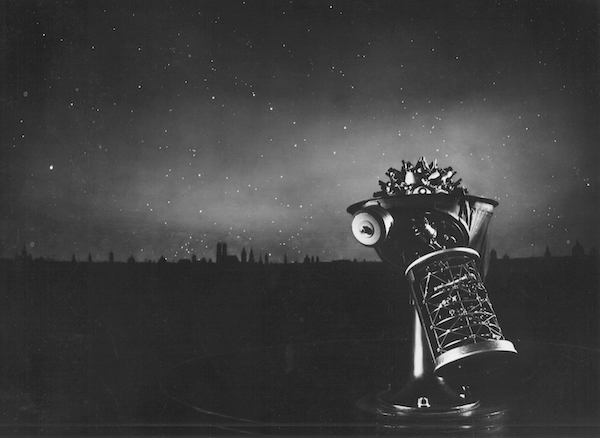
Above: Carl Zeiss Jena Modell I Planetarium projector and dome at Das Deutsche Museum, Munich, Germany in 1925 (139,471 bytes).
Notice how the horizon, around the circumference of the dome, depicts major structures of the city as they would be perceived from outside of the planetarium.
Image courtesy Carl-Zeiss-Stiftung.
Click on image to see a high resolution enlarged view (3,427,207 bytes).
One of the technologies that Zeiss pioneered and dominated before World War II was the development and production of planetarium instruments. A planetarium instrument is a projector housed in the center of a room with a hemispherically domed ceiling. The instrument projects points of light, and images of deep sky objects too, onto the ceiling to simulate the night sky as viewed from various times and dates. So the presentations can demonstrate seasonal, or historical views of the Earth-sky relationship.
Keep in mind the context of these times, life in this era was very different than ours. Radio programs, and for those near a city silent movies too, were among their most fascinating forms of entertainment that at times even conveyed news and infotainment. There was so much about science and the night sky that were unknowns; some educated people believed there was intelligent life on Mars maintaining 'canals' that seemed visible in large observatory telescopes. So the opportunity to gather and to be fascinated by impactful presentations could at the least be entertaining, while for some it might actually change their course in life. Since the 1980s we at Company Seven has spoken with many who could still recall their first visit to a Zeiss planetarium. Particularly for those growing up between the 1920s into the 1960s, it is no understatement that these experiences motivated many young people to better comprehend astronomy and celestial navigation, to question, and some to to explore.
The original concept of a planetarium, one that preceded that eventually perfected by Carl Zeiss Jena, was an idea by Dr. Wallace W. Atwood who was then director of Museum of the Academy of Sciences, in Chicago, Illinois. In 1912 his team completed building a planetarium based upon an overhead 15-foot diameter rotating metal sphere; it’s shell was precisely pierced so that the patterns and varying diameters of the holes corresponded to brightness and locations of 692 stars in the northern hemisphere overhead. This globes was backlit so that the light peeking through the holes simulated stars of the night sky, the holes of those brighter stars were larger in diameter while those for fainter stars were smaller.
In 1912 Dr. Max Wolf, Director of the Heidelberg Observatory, discussed astronomy oriented exhibits with Oskar von Miller, an Engineer and cofounder of Deutsches Museum von Meisterwerken der Naturwissenschaft und Technik (German Museum for Masterpieces of Natural Science and Technology) at Munich. This new museum was still under construction and would not be completed until 1925. Professor Wolf outlined two conceptual devices, including the planetarium developed in Chicago, which he thought could assist in teaching concepts about astronomy to the public at the museum’s forthcoming larger facility. By 1913 von Miller contacted Carl Zeiss Jena to discuss these ideas.
The Carl Zeiss Stiftung’s Scientific Director was Prof. Dr. Rudolf Straubel. Straubel had been with Zeiss since 1901 and had been promoted to his current position in 1903, then taking over for and by the choice of the esteemed Prof. Dr. Ernst Abbe. Straubel was well experienced in physics and well understood the teaching of it since he had been a Professor at University. Since then at Carl Zeiss Jena and at his other positions too he had gained insights to other sciences, manufacturing, and corporate management.
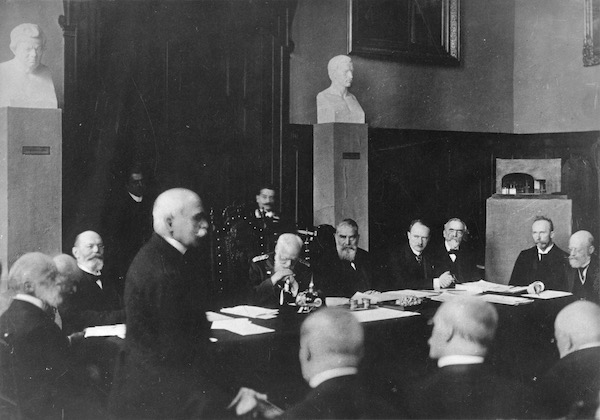 After Siegfried Czapski's death in 1907, Dr. Straubel was elected to membership on the Board of Deutsches Museum, where he served from 1912 to 1920. In reply to overtures from von Miller in 1913, Dr. Straubel pledged support by Carl Zeiss Jena for the development and construction of the two planned planetariums, one to demonstrate a Copernican system and the other Ptolemaic. Dr. Straubel was involved from the earliest discussions and meetings in the work that would produce these new planetarium instruments.
After Siegfried Czapski's death in 1907, Dr. Straubel was elected to membership on the Board of Deutsches Museum, where he served from 1912 to 1920. In reply to overtures from von Miller in 1913, Dr. Straubel pledged support by Carl Zeiss Jena for the development and construction of the two planned planetariums, one to demonstrate a Copernican system and the other Ptolemaic. Dr. Straubel was involved from the earliest discussions and meetings in the work that would produce these new planetarium instruments.
Right: Prof. Dr. Rudolf Constantin Straubel, seated second from the right, attending a meeting at the Deutsches Museum in 1917. At center is Oscar von Miller, founder of the museum. The wartime photos shows an elderly uniformed Bavarian officer (seated at von Miller's right) with a Pickelhaube on the table. A model, apparently of some astronomy apparatus, is in the background at right (70,723 bytes).
Click on image to see enlarged view (360,399 bytes).
It is a modern consensus that much credit to Prof. Dr. Straubel for his work on these planetarium instruments, and his many other contributions too, were erased later under the Nazi (NSDAP) regime.
Left: Dr. Rudolf Constantin Straubel. Particularly in the enlarged view, Dr. Straubel seems to exude integrity and intellect (90,069 bytes).
Image courtesy of Linda Langer Snook.
Click on image to see enlarged view (266,61 bytes).
Although Straubel was a christian Protestant, his wife née Marie Kern (30 June 1865 in Gleiwitz - April 20, 1944 in Jena) of more than fourty years was Jewish. She was the daughter of a Jewish industrialist and banker from Silesia. They met at the Jena home of Felix Auerbach, a notable Physicist. They married in Berlin in 1894, and together they had four sons including one who died a young man, Wolfgang (1899 - 1919). Marie became noteworthy on her own account due to her work for women's rights, and especially the right of girls and women to education, and admission to university. In 1902 Marie Straubel became the first chairwoman of the Jena branch of the “Women's Education - Women's Studies” association. She was in 1903 a founding member of the Jena Art Association.
In 1933 the ancestry of Marie Straubel came to the attention of Julius Dietz, the appointed Stiftungskommisars (Nazi Party Commissioner of the Carl Zeiss Foundation), and Fritz Wächtler, Gauorganisationsleiter und stellvertretenden Gauleiter für den Gau Thüringen (Organizational Leader and Deputy Leader for the Thüringian Gau) was a regional administrative leader of the Nazi party, while Gau was a regional administrative division akin to a state or province. The Nazis reported Marie Straubel to the Board of Management at Carl Zeiss Jena; the Board included several members whom Prof. Dr. Straubel had personally helped to hire, develop and promote. Consequently Dr. Straubel, himself a Board member, was given a choice by his fellows to either divorce his wife Marie or resign: he chose to resign. Dr. Straubel returned to teaching at the University of Jena.
- In the Germany of the National Socialist (Nazi) Party, in September 1935 the Reichstag (German Parliament) unanimously passed the “Reichsbürgergesetz und Gesetz zum Schutze des deutschen Blutes und der deutschen Ehre” (Reich Citizenship Law and Law for the Protection of German Blood and German Honor), known as “Nürnberger Gesetze” (Nüremberg Laws), to facilitate the gradual elimination from society of Jews and others deemed otherwise undesirable.
Afterwards his surviving wife Marie received a Summons to be transported to Theresienstadt; instead of turning herself in she too committed suicide in 1944. A commemorative Stolpersteine (stumbling block) is outside their family home at Botzstraße 10, translated to English this reads:
MARIE STRAUBEL
née KERN
BORN 1864
SHE ESCAPED DEPORTATION AND DIED
20 April 1944”
In recognition of the achievements of Prof. Dr. Rudolf Straubel, on 6 February 2023 the Lecture Hall 2 in the Abbeanum was ceremoniously dedicated as the Rudolf-Straubel-Hörsaal ("Rudolf Straubel Lecture Hall).
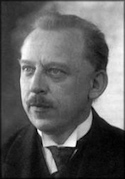 Dr. Ing. Walter Wilhelm Johannes Bauersfeld (23 Jan. 1879 in Berlin, d. 28 Oct. 1959 in Heidenheim an der Brenz) as an engineer and physicist who had since 1908 been the Geschäftsführer (Managing Director) of Carl Zeiss Jena. Bauersfeld would become the Zeiss name most closely associated with their planetarium instruments, and he certainly contributed to their design and keeping them in production over some challenging times to come.
Dr. Ing. Walter Wilhelm Johannes Bauersfeld (23 Jan. 1879 in Berlin, d. 28 Oct. 1959 in Heidenheim an der Brenz) as an engineer and physicist who had since 1908 been the Geschäftsführer (Managing Director) of Carl Zeiss Jena. Bauersfeld would become the Zeiss name most closely associated with their planetarium instruments, and he certainly contributed to their design and keeping them in production over some challenging times to come.
Right: Dr. Ing. Walter Wilhelm Johannes Bauersfeld (107,792 bytes).
Dr. Straubel and Dr. Bauersfeld met with von Miller and other museum representatives extensively over 1913. The concept of the first apparatus resembled an Orrey, but suspended from a ceiling and motorized. The second would would be based on electronic lamp projection technology, there was discussion about this being in a rotating room or a rotating dome.
Among the landmark meetings of the early team members was one at Munich on 24 February 1914 where the Carl Zeiss Jena team under Dr. Straubel, and including Dr. Bauersfeld who originated a counterproposal. Their idea was to produce a moving projector that would cast images onto a fixed dome ceiling. All attending agreed on this projection system arrangement, and committed to proceed. Years later, just two before his death, Bauersfeld wrote “This was the moment in which the Zeiss-Planetarium was born”.
Described as a “Copernican Planetarium”, this first apparatus relied on motorized models of the planets, Sun and Moon being suspended from a circular framework and tracks overhead in a room. On the floor below moved a platform that traveled on a circular track; people staged standing in line outside this circular center area. The moving platform carried an observer who could view select areas of this sky through one periscope. The Copernican Planetarium may have been the penultimate mechanical planetarium but this 12-meter diameter room did not have great capacity, nor did it provide a particularly immersive experience. Regardless, this was designed by a team at Zeiss led by Franz Meyer, then completed in 1924 and installed at the Deutsches Museum in Munich.
Dr. Bauersfeld was assigned to be the direct manager of the planetarium development team at Carl Zeiss Jena; they proceeded with engineering studies, then commenced design work for both types of planetariums. However, World War I interrupted many civilian oriented projects under development, and these projects too. But commencing immediately afterwards Carl Zeiss Jena resumed design and engineering, then started construction of the prototype Copernican Planetarium, and a projection planetarium too.
Originally named “Ptolemäischen Planetariums” (Ptolemaic Planetarium), it would be more simply designated the “Zeiss-Modell I”.
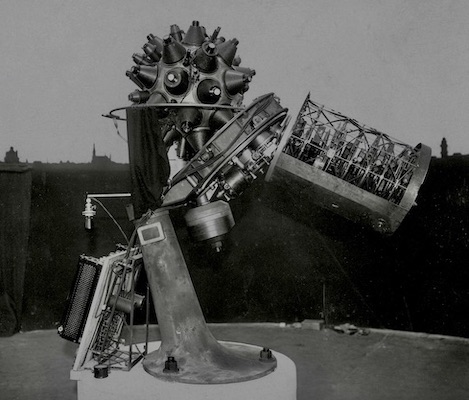 The planetarium projector consisted of a spherical head of about 50cm diameter. This housed a 200 watt, 220 volt electric lamp, and housings for thirty-one optical lenses termed Projektoren (projectors) each to project points of light, representing some 4,500 stars, and images of celestial objects. The fields blended, focused onto the ceiling of the domed room. The head dedicated another forty-one Projektoren to project a semblance of the hazy Milky Way. During the presentation the presenter could turn on Projektoren dedicated to projecting linear overlays that connected certain stars to show Constellations. The cylinder beneath the globe housed geared mechanisms the presenter could activate to project the planets onto the dome.
The planetarium projector consisted of a spherical head of about 50cm diameter. This housed a 200 watt, 220 volt electric lamp, and housings for thirty-one optical lenses termed Projektoren (projectors) each to project points of light, representing some 4,500 stars, and images of celestial objects. The fields blended, focused onto the ceiling of the domed room. The head dedicated another forty-one Projektoren to project a semblance of the hazy Milky Way. During the presentation the presenter could turn on Projektoren dedicated to projecting linear overlays that connected certain stars to show Constellations. The cylinder beneath the globe housed geared mechanisms the presenter could activate to project the planets onto the dome.
Left: the prototype Zeiss Modell I planetarium projector, as operating at the Das Deutsche Museum in May 1925. Projection head assembly with lenses, the cylindrical girdle at center supporting the motorized main drive gear, counterweights on a short shaft, the cylindrical frame area at right incorporated the planets modules. To the left of the support base are the control panel, and over this the red light (61,699 bytes).
Image courtesy Carl-Zeiss-Stiftung.
Click on image to see enlarged view (237,709 bytes ).
The projector head assembly was counterbalanced and driven by an AC-powered electronic motor through a gear reduction mechanism, that in turn drove the main gear to precisely rotate the head assembly. The axis of rotation of the projector head was tilted at an angle corresponding to the latitude, in Munich for example about 41°, and so by driving the main gear that motion corresponded to the Right Ascension motion of the Earth. The entire assembly bolted onto a concrete foundation, while the control panel was alongside the projector support pier. A dim red light bulb installed just over the control panel provided the light for the presenter; that would not hinder the night vision of the audience.
The rotating head demonstrably represented the relative apparent positions and motions of celestial objects, including solar system objects, in a way that could simulate observing these from Earth. The horizon all around the observers depicted buildings of the area, this helped visitors to better understand the motions of the night sky from east, peaking in the southern sky, and setting in the west, all while objects to the north rotated about the celestial pole. The planetarium project could represent current sky, or dial back to show events of the past or forward to present the future.
The room lights would dim, and the presenter would stand by the control panel of the planetarium projector. The lecturer would introduce the planetarium and explain to the audience what would be happening overhead and why. This introduction would allow some minutes for the audience members eyes to become dark adapted. Then the presentation began. The presenter would point out selected objects overhead with a flashlight that projected the image of an arrow to highlight an object on the dome. All this would be happening while the observers remained comfortably seated in the midst of a simulated night sky overhead and surrounding them.
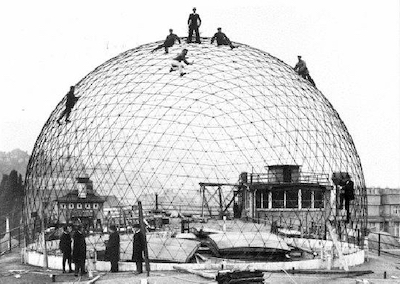 The dome is a critical component for the planetarium, this needs to have the nominal curve and surface smoothness for projector to present at its best. The importance of a suitable smoothly finished dome interior, and complexities of how to construct it were never overlooked by the team members. Many different approaches were considered, some were pretty conventional, while others ingenious. Factors including costs, the practicalities of constructing them on site, and the necessity of the dome to be durable even while the outer shell is exposed to the elements, and all of this while being comparatively lightweight, pointed towards the more ingenious solution.
The dome is a critical component for the planetarium, this needs to have the nominal curve and surface smoothness for projector to present at its best. The importance of a suitable smoothly finished dome interior, and complexities of how to construct it were never overlooked by the team members. Many different approaches were considered, some were pretty conventional, while others ingenious. Factors including costs, the practicalities of constructing them on site, and the necessity of the dome to be durable even while the outer shell is exposed to the elements, and all of this while being comparatively lightweight, pointed towards the more ingenious solution.
Right: prototype 16-meter diameter planetarium dome steel framework being assembled at the Carl Zeiss Jena factory in 1922.
Notice the curved wood forms staged inside the dome, prior to applying concrete (image 100,166 bytes).
Click on image to see enlarged view (186,367 bytes).
The dome design was finalized in 1922 by Walter Bauersfeld and Franz Dischinger (b. 8 October 1887, d. 9 January 1953). Dischinger had earned his civil engineering degree in 1913, then started working for Dyckerhoff & Widmann A.G., an engineering firm in Germany. They developed a way to build a thin-shell concrete roof in the shape of a hemisphere. A metal framework would be constructed to form as series of triangular braces joined to form the basic shape of a dome, wood forms would be attached, then there would be a specially formulated concrete sprayed onto the framework. The interior and exterior surfaces of the dome would gradually be smoothed, waterproofed, soundproofed, and then painted or clad. Their technique for building this was subsequently patented.
Dischinger would later return to college earning his doctorate at the Technical School in Dresden in 1928. Later in 1928, Dischinger published a paper explaining the relevant mathematics of the concrete dome. Dischinger returned to school in 1928 to receive his doctorate at the Technical School in Dresden, Germany. Dr. Dischinger would become recognized as a pioneer of the use of prestressed concrete, patenting the technique of external prestressing (where the prestressing metal bars or tendons are not encased in the concrete) in 1934.
The projection planetarium instrument was patented in 1922. Early in 1923 the prototype 16-meter dome was completed on the flat roof a five-story building at the Carl Zeiss Jena factory complex, this is shown in the photo below at right. By 1929 the planetarium dome had been removed and another story was added to the building; this was an extensively glazed level featuring an arched ceiling. This building was long ago demolished, but bordered what is now Ernst-Abbe-Straße near the Carl-Zeiss-Platz. However, the old telescope observatory dome remains, about one block almost due north.

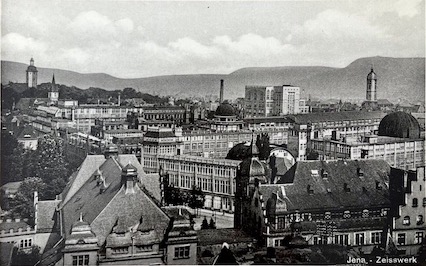
Above left: Optische Werkstat Carl Zeiss Jena, 1922 looking towards North-Northeast prior to installation of the Planetarium Dome.
The Carl Zeiß Straße borders the factory along the west side, with the Carl Zeiss Jena factory telescope shops Observatory Dome to the left of center.
Closer are a half-cylinder roofed building and to the right a chimney stack that border that building that would soon house the Planetarium Dome (image 75,888 bytes).
Above right: Optische Werkstat Carl Zeiss Jena with Planetarium Dome, 1935 looking towards East-Northeast.
The telescope shop Observatory Dome is at center, and to the far right is the Planetarium Dome atop the factory building.
Between them in the foreground is what is presently the Tanztheater Jena e.V also on Carl-Zeiss-Platz (image 59,446 bytes).
The tower beyond the Planetarium Dome of the Zeiss complex is of the Stadtkirche Sankt Michael (St. Michael Church) at Kirchplatz 1, since about 1381 in Jena.
This was damaged during World War II, though much of this beautiful church has been restored the crypt remain closed undergoing restoration as late as 2025.
Click on each image to see their enlarged view (224,419 and 185,016 bytes).
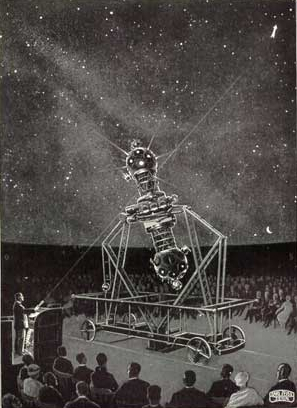 The components for this first planetarium instrument, ultimately destined for Deutsches Museum, were largely completed by the summer 1923, including the 16-meter dome for the Mark I projector. The projector itself was being assembled inside the dome in August. This first installation would help developers perfect designs, practice installation techniques, and refine programs to be supported by the imagery generated by the projector. By mid-September 1923 the assembly of planetarium projector was largely completed, and the instrument commenced final testing. Later that month the projector was removed, then transported to the Deutsches Museum at Munich where it was installed by Carl Zeiss Jena technicians Paul Lange and Fritz Pfau.
The components for this first planetarium instrument, ultimately destined for Deutsches Museum, were largely completed by the summer 1923, including the 16-meter dome for the Mark I projector. The projector itself was being assembled inside the dome in August. This first installation would help developers perfect designs, practice installation techniques, and refine programs to be supported by the imagery generated by the projector. By mid-September 1923 the assembly of planetarium projector was largely completed, and the instrument commenced final testing. Later that month the projector was removed, then transported to the Deutsches Museum at Munich where it was installed by Carl Zeiss Jena technicians Paul Lange and Fritz Pfau.
A meeting of the Deutsches Museum committee who commissioned the planetarium, was convened inside the dome where on 21 October 1923 Dr. Bauersfeld from Carl Zeiss Jena demonstrated the Zeiss Mark I planetarium. This was the first time the program in full had been demonstrated to an audience.
Right: a later model Carl Zeiss Jena Planetarium 23c projector. Note the program lecturer is holding a flashlight with an arrow over the lens, this was used for pointing out objects on the ceiling of the Planetarium dome. This is similar to what the first audience would have been amazed by (107,792 bytes).
In this era especially these would have been dazzling entertainment, as well as the basis of educational programs. As described by Carl Zeiss, this first Mark I projector:
- “allowed for the display of 4500 stars, the Milky Way band and the names of important constellations. The projectors in the cylindrical part reproduced the Sun, Moon and the planets Mercury, Venus, Mars, Jupiter and Saturn on the dome. Motors and gears allowed for the simulation of daily rotation in increments of 50 seconds, 2 minutes or 4 minutes. The change in positions of the sun, moon and planets in the sky, the so-called annual motion, could also be illustrated using the planetarium projector. A year could be illustrated in increments of 7 seconds, 1 minute or 4 minutes. The design of the projector was intended for viewing the starry sky from the latitude of Munich. Later models also allowed for changing the apparent position on the Earth and showed the complete starry sky.”
It would be some year and a half later before all other construction of the Deutsches Museum complex, including the 10-meter planetarium dome for the Mark I projector, were completed. Oskar von Miller formally opened the new museum to the public on on 2 May 1925.
After the first projector was removed to Munich another Zeiss Mark I planetarium projector was installed at the dome at Carl Zeiss Jena, and this was opened to the public. The attraction became very well-attended, and through at least the fall of 1924 there are reports that attendance exceeded 80,000. Intended or not, this turned out to be very good for marketing because this enticed civic authorities and education organizations representatives from several other communities. The success promoted Jena to build their own Planetarium, of course with support from Carl Zeiss Jena, and when this opened the dome atop the Carl Zeiss Jena factory was dismantled.
The original instrument at Das Deutsche Museum was designed to reflect the sky at the latitude above Munich, but it attracted visitors from far away. The presentations created such a sensation that not only did the general public flock to attend, but also attending were members of the military, and those in ocean navigational companies. What had been an engineering exercise to create a special instrument for a single museum became a great product for education and inspiration world-wide.
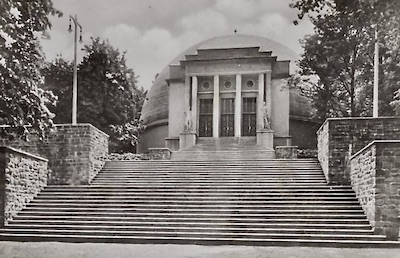 Orders for several other new planetariums arrived before the first installation at Das Deutsche Museum was opened. The next few planetariums to be completed would be in Barmen-Elberfeld, then Leipzig, and Düsseldorf.
Orders for several other new planetariums arrived before the first installation at Das Deutsche Museum was opened. The next few planetariums to be completed would be in Barmen-Elberfeld, then Leipzig, and Düsseldorf.
The success of this first instrument demonstrations prompted other German cities to follow suit, soon planetariums with their Zeiss projectors were operating in several cities. The first purpose-built built stand alone planetarium originated in the Fall of 1924 when the Mayor of Barmen-Elberfeld, now the Barmen district of the city of Wuppertal, and his deputy visited Carl Zeiss Jena. There they were impressed by the prototype planetarium demonstration. They urged their City Council to approve 350,000 Reichsmarks to build a planetarium; this was a hefty sum in 1924 (then $82,940 USD) or about 42 times the cost of a nice house.
Left: The Barmer Planetarium, in Barmen-Elberfeld, Germany c.1926 (56,441 bytes).
Click on image to see enlarged view (148,236 bytes).
The Modell I planetarium was certainly revolutionary, and inspiring to most who attended. But it had some shortcomings, aspects that an experienced astronomer or presenter might notice. For one, the single tungsten lamp made it impossible to represent stars as having colors. To cover the entire dome with stars and the Milky Way required this projector be installed nearly three meters above the floor; it was bolted onto a concrete footer. But this set the audience well below the level of the horizon, leaving them to feel as though they were observing from some well. This had been made to work at the latitude of Munich, but growing demands from other latitudes meant Carl Zeiss would have to come up with a better design. The Barmer Planetarium would give Carl Zeiss Jena engineers their next chance to improve.
This housed an improved planetarium projector, the “Zeiss-Planetarium”, often termed the “Modell II”, this could support presentations in domes of larger diameters. The Modell II had been under development since at least 1924 when Dr. Walter Villiger, head of the Astro Division, provided suggestions that contributed to the developments. Villiger and Dr. Bauersfeld shared credit on the Patent of 1925 for development of this “device for projecting stars”.
The Barmer Planetarium opened on 18 May 1926. Vistors were greeted at the entrance with flanking large statues by Paul Wynand of the Roman god “Mars”, and the goddess “Venus”. This facility could seat up to 600 people, and so while it was the first it would soon become second in capacity to the planetarium opened later at Düsseldorf. The Barmer Planetarium would be destroyed during an air raid by the Royal Air Force’s Bomber Command over the night of Saturday 29 to Sunday 30 May 1943 as their incendiary area bombing produced destructive firestorms. By 1955 the remains were demolished. The nearby stone Toelleturm (observation tower) that dated back to 1888 survives, but today there is only a memorial plate to commemorate The Barmer Planetarium.
The Leipzig Planetarium with its Zeiss Modell II projection system opened on 20 May 1926, just two days after the Barmer Planetarium opened. The Leipzig Planetarium was located at the south-west corner where meets Pfaffendorfer Street meets Kickerlingsberg Street, and adjoining the zoo grounds. This art deco structure featured a dodecagonal exterior base supporting a pyramidal roof. Leipzig remained an important railway hub and was a wartime factory center during World War II, consequently it was bombed by allied air forces. The worst was when the city was visited by 442 Royal Air Force bombers between 3:50 and 4:25 am on 4 December 1943. Consequently explosions and the subsequent firestorm destroyed the planetarium and claimed more than 1,800 lives.
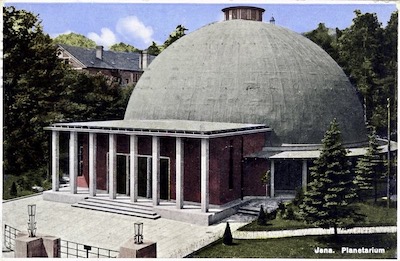 In part as a technology demonstrator and also as a part of the Stiftung’s sense of civic duty, the Zeiss Planetarium Jena was commenced in 1924. As with astronomical observatory construction, Carl Zeiss Jena was not a general contracting builder, so their observatory and their planetarium building and dome designs would be provided to a local licensed architect and builder, and then construction would proceed with the cooperation of representatives from Carl Zeiss Jena. In the case of the Jena planetarium building and dome, the architects selected for this project were Schreiter & Schlag, while the building prime contractor was Dyckerhoff & Widmann A.G.
In part as a technology demonstrator and also as a part of the Stiftung’s sense of civic duty, the Zeiss Planetarium Jena was commenced in 1924. As with astronomical observatory construction, Carl Zeiss Jena was not a general contracting builder, so their observatory and their planetarium building and dome designs would be provided to a local licensed architect and builder, and then construction would proceed with the cooperation of representatives from Carl Zeiss Jena. In the case of the Jena planetarium building and dome, the architects selected for this project were Schreiter & Schlag, while the building prime contractor was Dyckerhoff & Widmann A.G.
Right: Zeiss Planetarium Jena with its 25-meter diameter dome. Photo from postcard of the mid 1920s (107,792 bytes).
Click on image to see enlarged view (151,040 bytes).
This facility was completed in 1926, also housing the improved the Modell II planetarium projector, and Planetarium Jena was inaugurated on 18 July 1926.
Dr. Kurd Kisshauer (b. Dec. 1886 in Berlin, d. Nov. 1958) had been also among the Zeiss employees involved with the project. While Kisshauer’s doctorate was in political science, he was however an experienced amateur astronomer and member of the Astronomical Society, his practical experience was beneficial for the project. By 1926 Kisshauer had left Carl Zeiss Jena and moved to Dresden where later in 1926 he became the Director of the newly completed Municipal Planetarium Dresden.
When the Mannheim Zeiss Planetarium opened on 13 April 1927, Professor Max Wolf wrote about his original recommendation to Oskar von Miller:
-
“If I praise it, I am doubly entitled to being believed since. For it was I who suggested that other plan for the Deutche Museum,
namely, of using a great rotating hollow sphere, which happily has been discarded in favor of the Zeiss planetarium”
Over the 1920s there was a boon of demand for these from the civic and educational organizations first in major cities in Germany, and soon from around the globe. Consequently Bauersfeld’s team modified the original designs so that the projector would be able to represent the skies over any point on the globe. Wherever their planetarium instruments were installed they became a source of civic pride, and an inspirational resource for science education. These sales were a source of revenue for a company that was soon to be working hard to survive the Great Depression.
The Griffith Observatory - The Best of Both: what would become one of the longest enduring and most popular science attractions was conceived by its benefactor, Griffith Jenkins Griffith (4 January 1850 - 6 July 1919), an American industrialist and wealthy philanthropist born at Betws, Bridgend, in Wales; incidentally, he was not related to the Hollywood film director D.W. Griffith.
Considering his successes and wealth Mr. Griffith had developed a sense of obligation, that he should leave his community better for him having prospered in it. On 16 December 1896 he donated 3,015 acres of land to the City of Los Angeles, this land would become the Griffith Park. Years later he became inspired during a visit to the Mount Wilson Observatory where while at the eyepiece of the the 60-inch reflector, since December 1908 this was the world’s largest operational telescope, he observed celestial wonders. This experience was mind-altering, inspiring him to make such opportunities available for the average person.
Heretofore, astronomical telescopes tended to be located at dark sky sites far away from urban centers, and with their access limited to scientists and educators. Mr. Griffith envisioned making astronomy accessible to the public when in December 1912 he offered to donate funds to the City of Los Angeles for construction of an observatory and a Hall of Science. Soon after he also offered funds to build a Greek Theatre amphitheater. A majority in the city Park Commission objected, thus the offer was declined.
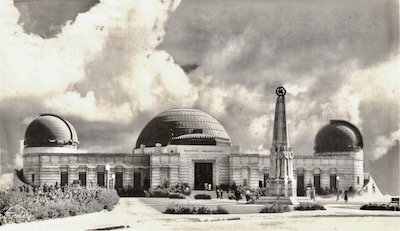 After Mr. Griffith died on 6 July 1919 his Will assigned the bulk of his estate as a donation to The City of Los Angeles. This selfless act ultimately created The Greek Theatre that would be dedicated in 1930, and the astronomy complex that would bear his name; to this day these remain owned by the public through the City of Los Angeles.
After Mr. Griffith died on 6 July 1919 his Will assigned the bulk of his estate as a donation to The City of Los Angeles. This selfless act ultimately created The Greek Theatre that would be dedicated in 1930, and the astronomy complex that would bear his name; to this day these remain owned by the public through the City of Los Angeles.
Left: Griffith Observatory of the City of Los Angeles, from postcard postmark dated July 1940.
Left to right are East Dome of the Zeiss telescope, Planetarium Dome, and West Dome housing the coelostat solar telescope (36,282 bytes).
Click on image to see enlarged view (108,970 bytes).
After consulting with astronomers, including Walter Sydney Adams (20 December 1876 - 11 May 1956) and George Ellery Hale (29 June 1868 - 21 February 1938), Mr. Griffith drafted detailed specifications for the complex. Mr. Griffith's Will specified, among other bequests, that a new telescope should be “at least 12-inches in diameter...complete in all its details” and was to be installed “high and above the Hall of Science.”
Griffith J. Griffith died in 1919 leaving the City of Los Angeles to consult with experts about how best to realize the founder’s vision.
The original ideas for the planned observatory pointed towards a refracting telescope. Dr. Dinsmore Alter, the first Director of Griffith Observatory, described years later in a 1955 edition of The Griffith Observer “Technically a 12-inch reflecting telescope would have fulfilled the conditions [of the bequest], the trustees planned for a 12-inch refractor, which is much the more expensive but which, in general, is better for public use”. The Furthermore, the Carl Zeiss Jena Meyers mount, then advertised as an “offset fork stress compensating system”, made it easier to accommodate a diverse range of visitors to the eyepiece of the telescope. The Carl Zeiss Jena refractor was in the forefront because theirs were widely regarded as being supreme, practical, and well integrated systems.
The preliminary designs were sketched by Russell W. Porter (12 December 1871 - 22 February 1949) who was an American renaissance man, an artist, engineer, architect, cartographer, amateur astronomer, and explorer. The Greco-Roman facility designed by the highly regarded architects John C. Austin (13 February 1870 - 3 September 1963) and Frederic Morse Ashley (24 December 1870 - 1 February 1960) features three domes:
- Copper east dome housing the large refracting telescope for celestial evening observing,
- Copper west dome housing the Russell Porter-designed triple-beam coelostat (solar telescope) for observing the Sun or Moon,
- Copper-clad concrete exterior central dome which at 76-feet (23 meter) diameter this is the largest, over the auditorium for presentations*.
* although the first operational Carl Zeiss Jena planetarium instruments were some years away when Mr. Griffith passed, the general concept was not new.
Given the acclaim being earned by the Zeiss planetariums then going in service, the decision by his Trust was made to buy a Zeiss planetarium; Griffith’s would be the third Carl Zeiss Jena planetarium in the United States, after those at the Adler Planetarium in Chicago, and The Fels Planetariums in Philadelphia.
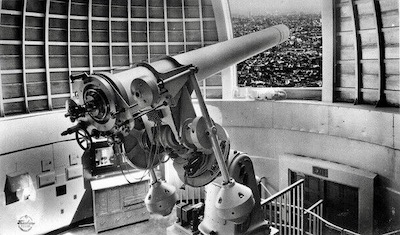 The Griffith Trust placed the order for a new Carl Zeiss Jena 12-inch (300 mm) f/16.8 telescope, with E objective doublet achromatic lens, supported by a Meyer equatorial tracking mount was placed in 1933. Construction of the Griffith Observatory commenced 20 June 1933 for what would become Los Angeles Historic-Cultural Monument No. 168, Griffith Observatory.
The Griffith Trust placed the order for a new Carl Zeiss Jena 12-inch (300 mm) f/16.8 telescope, with E objective doublet achromatic lens, supported by a Meyer equatorial tracking mount was placed in 1933. Construction of the Griffith Observatory commenced 20 June 1933 for what would become Los Angeles Historic-Cultural Monument No. 168, Griffith Observatory.
At a cost of $14,900 the Carl Zeiss Jena telescope was the first major instrument ordered for the new complex. The installation of the new refracting telescope commenced in September 1934. The technical team on site from Carl Zeiss Jena was headed by Paul Lange, a supervisory technician at the astronomical instruments (telescopes and planetarium instruments) shop from Jena, Germany. The Zeiss team worked with Maxwell K. Baughman, a technician of the Griffith Planetarium staff, and were aided by Los Angeles tradespeople including riggers and electricians. The installation, mount pole alignment, and fine tuning of the telescope were completed in January 1935.
Right: Carl Zeiss Jena 12-inch (300 mm) f/16.8 telescope as installed at Griffith Observatory, from postcard of 1935 (52,399 bytes).
Click on image to see enlarged view (157,102 bytes).
The observatory and accompanying exhibits were opened to the public on 14 May 1935. Approaching the Observatory one passes the The Astronomers Monument dedicated to six famous astronomers, on the front lawn. On entering the facility the visitor can study the Foucault pendulum, an exhibit demonstrating the rotation of the Earth. There were other science related displays, including a Cosmochron exhibit.
The installation of the new Carl Zeiss Jena Mark II Planetarium Projector was completed soon after, and this would remain in service from 1935 to 1964. The Mark II was replaced by a West German Zeiss Mark IV Planetarium Projector, this was in service from, 1964 to 2002 when it was retired and preserved as an exhibit in the underground galleries. The Mark IV was replaced with a, now reunified, new Carl Zeiss Mark IX Universarium Planetarium Projector.
Griffith Observatory has become among the longest enduring, and most attended scientific exhibits in the Americas. The Carl Zeiss Jena refracting telescope and planetarium instruments would be flag bearers for the Carl Zeiss Jena company for decades to come. This was all made possible because of Mr. Griffith’s vision, his endowment and the terms set forth in his will, and the efforts of the designers and craftsmen who would build the observatory. To this day the facility prospers, and does not charge any fee for admission by the public.
Mr. Griffith is buried at the Hollywood Forever cemetery in Hollywood, Los Angeles County. His grave in Section 7 (Griffith Lawn) is marked with a tall Obelisk from which one used to be able to see the Griffith Observatory some 2.2 miles distant to the north east.
The Fascinating Tale Of A Carl Zeiss Jena 9-inch: in 1954 a second large refracting telescope was purchased by the Griffith Observatory. This was the Carl Zeiss Jena 9-inch (240 mm) aperture f14.8 refractor owned by Mr. Shelley M. Stoody (20 March 1899 - 26 June 1961) a California businessman. It had originally been produced configured for terrestrial panoramic use, sold with a field tripod. To facilitate transport the optical tube was made so that it could be disassembled easily into three major components. The Alt-Az mount head supporting the OTA featured a retractable pillar. The set as built new, complete with tripod and with a complement of accessories this telescope, was designated the Carl Zeiss Jena product code name Asalak.
The more fascinating aspect of this tale is the ingenuity of the prior owner of this Carl Zeiss Jena 240 mm telescope. In 1926 Mr. Stoody built a new home overlooking Worsham Canyon in Whittier, California*. The home of a Spanish Colonial Revival style incorporates a cylindrical two story tower, with its upper foot or two being a short cylindrical wall section capped with a gently sloping pointed roof that appears made of Spanish tile but is in fact painted steel. This upper section rides on a circular track with bearings, and is motorized. This roof incorporates a hatch that could open to allow the telescope within to observe celestial objects 360° around. The arrangement and local seeing conditions could hinder observing towards some areas of sky, but it was a good compromise to avoid the conventional dome appearance.
-
* The home was sold in 1939 to Frank A. and Hannah Milhous Nixon who resided here with their three sons Richard, Donald and Edward. Richard M. Nixon would later serve as vice president under President Dwight Eisenhower from 1953 to 1961, then as the 37th President of USA from 1969 to 1974. Since then the house is sometimes referred to as the Stoody-Nixon home. The Whittier Historic Landmark -41 remains at 6799 Worsham Drive, Whittier, California.
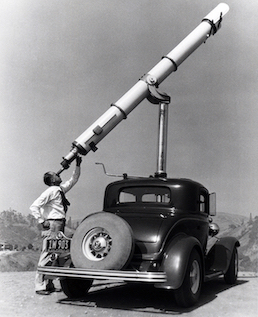 Mr. Stoody was Vice-President and plant Manager at the Stoody Welding Company factory. In 1933 he adapted a 1932 Ford Roadster, a 2-door sedan owned by friend Ed Turner, to carry his Carl Zeiss Jena 240 mm refracting telescope. The ultimate goal was not just the transporting of the telescope, but arranging this so that one man could do it all: safely transport the telescope to more favorable observing locations, put the telescope into service, and later secure it for return to home. This required some skilled engineering and craftsmanship, both in ready supply at Stoody Welding Company, to ensure the telescope was installed into the automobile, and could be operated smoothly and with enough rigidity to make it a practical portable observatory, and a mobile teaching tool. It appears the original Carl Zeiss Jena manually operated adjustable length pillar with its geared mechanism was secured to the automobile frame with the column extended through an opening cut in the roof of the car, and with its Alt-azumth head attached this cradled the 9-inch telescope optical tube assembly.
Mr. Stoody was Vice-President and plant Manager at the Stoody Welding Company factory. In 1933 he adapted a 1932 Ford Roadster, a 2-door sedan owned by friend Ed Turner, to carry his Carl Zeiss Jena 240 mm refracting telescope. The ultimate goal was not just the transporting of the telescope, but arranging this so that one man could do it all: safely transport the telescope to more favorable observing locations, put the telescope into service, and later secure it for return to home. This required some skilled engineering and craftsmanship, both in ready supply at Stoody Welding Company, to ensure the telescope was installed into the automobile, and could be operated smoothly and with enough rigidity to make it a practical portable observatory, and a mobile teaching tool. It appears the original Carl Zeiss Jena manually operated adjustable length pillar with its geared mechanism was secured to the automobile frame with the column extended through an opening cut in the roof of the car, and with its Alt-azumth head attached this cradled the 9-inch telescope optical tube assembly.
Right: Carl Zeiss Jena 9-inch (240 mm) achromatic refracting telescope installed on the 1932 Ford sedan, with mounting pillar extended. The base image shows Mr. Ed Turner posing at the eyepiece, while the pillar gear crank handle is just to his right. Note the telescope has the provided image-erecting Porro Prism attached. Photo among several taken for an August 1933 article in the Los Angeles Times (104,749 bytes).
Mouse over image to see alternative perspective, with Mr. Turner standing to the side with a planisphere (15,678 bytes).
To put the telescope in service two midship frame-mounted stabilizers extended down to steady the car frame and take most of the loads off from the suspension and tires. To configure this for the driving the telescope pillar was retracted to lower the telescope, the objective and lens shade were covered with a protective bag, the telescope was moved in azimuth in-line with the longitudinal axis of the vehicle, then the optical tube was secured to a hinged brace mounted at the rear of the car, the stabilizers and pillar were retracted. It was said the cost of this project amounted to about $7,000 USD, the cost of the car alone, likely with the 65 horsepower V-8 engine, would have been about $500 USD new. With the telescope’s long length, the focuser just over hanged the rear bumper of the car; this was Mr. Stoody’s idea of a portable telescope.
In 1955 Griffith Observatory installed this optical tube assembly in parallel atop their 12-inch telescope. Both telescope optical tubes have operated in this configuration since then, allowing added capabilities for: astrophotography, or for visual sessions this can allow two observers to simultaneously observe, or the telescopes could be configured to show different perspectives (in terms of field of view, by filtering, etc.) of the same centered object of study.

“This is what real telescopes do, in their presence and at the eyepiece they awe and inspire!” per the Field-Marshal General For Life and Beneficent Dictator of Company Seven.
Above: both Carl Zeiss Jena 12-inch (300 mm) and piggybacked 9-inch (240 mm) refracting telescopes, at Griffith Observatory in February 1988.
These beautiful and historic telescopes were adulterated in 2006, likely by millennial Californians, who OK'd the piggybacking of (hope they did not drill holes!)
CELESTRON catadioptric telescopes, immodestly branded too, a US company since acquired by Synta Technology Corp. of Taiwan and China (110,735 bytes).
Oops, does the author and those at Company Seven sound like Carl Zeiss snobs? Sure we are, um 'er...could be.😇
Photo ©1988 by M. Cohen, used by permission.
Back to Carl Zeiss Jena Planetariums: during World War II, Carl Zeiss Jena produced very few planetarium instruments. Challenges after the war commenced included not only the gradually diminishing priorities assigned to non-military manufacturing, but also the complexities of safely transporting the new instrument with a team of expert technicians from Germany to the destination. Consequently, the only large planetarium completed was a Modell II installed in 1944 at Goteborg, Sweden.
After the war, Carl Zeiss Jena manufacturing was gutted by the Americans who evacuated people and some resources, then by the Soviets too. So there was very limited production in Jena and other Zeiss factories in Germany for some time, and little of these that were being sold to western nations. So in 1949 the benefactor of the new Morehead Planetarium and Science Center, on the campus of the University of North Carolina at Chapel Hill, went shopping to where he had served as a US Ambassador, and negotiated purchase of the Goteborg Modell II instrument. This, the sixth in the USA, went into service in their 20.7-meter dome on 10 May 1949. In 1959 this was upgraded to a Model III. Interestingly, every astronaut in the NASA Mercury, Gemini, Apollo, Skylab, and Apollo-Soyuz Test Project programs attended celestial navigation training at this planetarium. This Modell III operated until March 1969 when, owing to increasing needs for repairs and scarcity of parts, it was replaced by a a Carl Zeiss Modell VI. The Modell VI was replaced in April 2011 by a new digital system. Not being able to find a new home for the large and heavy Modell IV, it was disassembled on 24 August and disposed.
Today, the Planetarium Jena remains the oldest operating large Zeiss planetarium facility. The original Model II projector operated here from 1926 to January 1969. Three successors have since driven the presentations here, culminating in the Model VIII “Universarium”, produced by a unified Carl Zeiss Jena GmbH, that entered service on 19 November 1996.
The original Modell I planetarium projector operated at the Deutsche Museum until World War II, when along with many other precious artifacts, the projector was disassembled and removed for safer storage. The bombings of 1944 into 1945 damaged about 80 per cent of the museum structure, and one fifth of the exhibits but the Modell I was not there and so it survived intact. After the war, while the Deutsches Museum was being rebuilt with some areas opening as soon as 1948, the original Modell I planetarium projector was restored to the dome on 7 May 1951.
The concept of these was still so inspiring that even after World War II seven of the Carl Zeiss small projectors, designed for domes of 6-meter diameter and already installed at 13 locations, were taken in 1945 and 1946 as post-war reparations.
Even after World War II both Carl Zeiss companies, east and west, would establish planetarium production at their headquarters, and their domes would figure prominently in the skyline of their factories. Even though after the second World War these never retained their status as a profit center for Carl Zeiss, it was a matter of social responsibility and corporate pride that inspired managements to continue production. This may have had something to do also with the leadership and influence of Dr. Bauersfeld, who had been deeply involved with the development of astronomical telescopes, their mounts, and instruments. Since 1927 Bauersfeld had also taught Astronomical Physics and Engineering Mechanics as an Associate Professor, and from 1938 to 1946 was ordentlicher Professor (Professor ordinarius) at the University of Jena.
After the Carl Zeiss West Germany Model IV were announced in 1957, the Deutsches Museum planetarium was among the first upgraded. The planet cage of the original planetarium instrument was placed in storage at the museum, while the original star projector was later loaned to the Max Planck Institute to support research about birds navigation by the stars. A reunified Carl Zeiss Jena produced a new Skymaster ZKP 4 LED star projector with a digital 4k dome projection system, this entered service in the planetarium after the renovation of 2013 to 2015 when the 15-metre projection dome was also renovated. The museum continues to display a history of these including the original Carl Zeiss Jena Modell I, the world's first planetarium projector. In July 2022 the Deutsche Museum planetarium had to temporarily close due to renovation of this part of the building, the planetarium programs are suspended until about 2028.
For further reading about the history of the early Carl Zeiss Jena planetariums, we recommend a more contemporary 1935 account “The Story of the Zeiss Planetarium” by C.A. Chant, this is hosted at https://adsabs.harvard.edu/full/1935JRASC..29..143C.
Germany Helping The People Who Would Later Eat Their Lunch: Nikon of Japan was formed when three leading optical manufacturers in Japan merged to form Nippon Kōgaku Kōgyō Kabushikigaisha (日本光学工業株式会社, or “Japan Optical Industries Corporation”). The company became known in many areas including the production of optical and measuring equipment, binoculars, small telescopes and even larger and more complicated astronomical telescopes. Moving into the 1920's Nikon worked to produce more sophisticated camera lenses but the company, lacking engineering know-how, ran into roadblocks. So by 1921 Nippon Kogaku persuaded eight German optical engineers to come to work for the company. These engineers including Heinrich Acht, Hermann Dillmann and Max Lange, were instrumental in helping to get Nippon Kogaku onto the right track.
A series of lenses whose designs were modeled on the Zeiss Tessor were designated “Anytar” lenses. Seven of the German engineers returned home in 1926 while Acht remained until 1928, this was happening as in-turn Kakuya Sunayama, the General Manager of the Lens Design Department, visited Germany to learn more about optics. Mr. Sunayama acquired a Carl Zeiss 50cm F4.8 Triplet (three element) lens. The Zeiss lens was disassembled, studied, and essentially copied so that by 1929 Nippon Kogaku had completed their first prototype camera lens and designated this the Tessor-type Anytar 50cm F4.5. This lens was followed by the Anytar 12cm F4.5 at the end of 1929, as well as the 7.5 cm and 18 cm focal length lenses. By 1930 the Triplet, the Tessor and the Dagor type lenses were in production. Improving upon the original designs by 1931 the Anytar 12cm F4.5 was said to have become competitive with the Zeiss Tessor. With the prospects for developing a system of photographic lenses it was decided to market them under a unifying name, thus the NIKKOR brand was born in 1932.
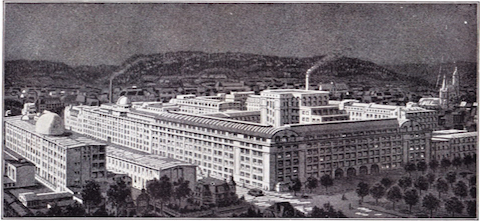
Above: the Carl Zeiss Jena works in 1928, now with 4500 employees.
This is an uncommon perspective, viewing the factory from the south-east. The Planetarium dome remains on the rooftop
towards the left, the Observatory dome is just to its right. The Garnisonskirche (now Friedenskirche) is distant at far right.
By the building corner at foreground center is now the intersection of Ernst-Abbe Straße and Shillerstraße (174,659 bytes).
Click on image to see enlarged high resolution view (559,505 bytes).
The 1930’s And More Optical Innovation For Cameras And Binoculars: in 1849 Moritz Carl Hensoldt (b. 1821 - d. 1903) and his brother-in-law Carl Kellner (known best for his eyepiece design) began a business for the fabrication of telescopes. By 1850 Hensoldt formed his own company “M. Hensoldt & Soehne AG” for the manufacture of optical instruments. By 1928 the Hensoldt company, with its factory in Wetzlar, had the Carl Zeiss company as a shareholder. Zeiss thereby acquired a partnership with a manufacturer best known for their roof prism binoculars introduced in 1897, and in 1905 the “Dialyt” series of Abbe-König in line prism binoculars and riflescopes. Hence the similarity between the appearance of traditional Hensoldt roof prism binoculars made since about 1905 and several Carl Zeiss roof prism products up to today. Improvements continued, including the 1933 shift from binocular housing construction of brass and zinc to lighter weight metals including aluminum and magnesium.
As mentioned previously, camera production became an important sector for Zeiss, with their dozens of brands and factories involved in production for that market. Zeiss had become involved in camera lens design and fabrication giving the world such famous names as “Tessar”, “Biotar” and “Sonnar” with the latter having been developed by Dr. Ludwig Bertele - another famous name in optics design. The increased emphasis in this growing market lead to a landmark negotiation in the history of Zeiss with the founding of Zeiss Ikon in 1926.
Zeiss Ikon AG resulted from the planned merger of four well regarded names in the photo industry, and by the establishment of two new subsidiaries. The business plan was to unify, under Zeiss, the production and marketing of cameras, lenses, and other photographic equipment by:
- Optische Anstalt C.P. Goerz AG of Berlin, originally founded in 1886
- Heinrich Ernemann AG, of Dresden, originally founded in 1889
- Contessa-Nettel AG of Stuttgart, whose origins dated to 1902
- Ica AG of Dresden, that was formed in 1909 by the merger of:
- Fabr. phot. App. AG vorm. R Hüttig & Sohn in Dresden, originally founded in 1862
- Dr. Rudolf Krügener, Photochemisches Laboratorium und Fabrik photographischer Apparate Frankfurt-Bockenheim (Kamerawerk Dr. Krügener) in Frankfurt am Main, founded in 1885
- Emil Wünsche AG in Reick of Dresden, originally founded in 1889
- Camerawerk Palmos AG (acquired by Zeiss) in Jena, originally founded in 1900
- Fabr. phot. App. AG vorm. R Hüttig & Sohn in Dresden, originally founded in 1862
- AG Hahn für Optik und Mechanik, would be established in Kassel, 1927
- Goerz Photochemische Werke GmbH, would be established in Berlin, 1928
The combining of these companies was made possible by a notable additional investment from the Zeiss foundation. Zeiss Ikon facilities now included the Ica factory in Dresden, two Goerz factories in Berlin (which also made searchlights, medical instruments), and the Contessa Werke in Stuttgart.
Zeiss Ikon AG would remain based in Dresden, there in 1932 they began to produce box cameras under the tenure of Dr. Ing. Heinz Küppenbender. Carl Zeiss entered the 35 mm format camera market, that had been pioneered by rival Ernst Leitz Optische Werke, of Wetzlar. The first 35 mm entry was the “Contax” range finder camera, this was also built in Dresden. These cameras in prewar and in postwar configurations too earned Zeiss worldwide respect and admiration, their success led to the development of the Contarex and the Contax RTS camera series, some of which were fabricated by Yashica-Kyocera of Japan years later under license to Zeiss specifications. Lenses made by Carl Zeiss were made for sale with cameras manufactured by other firms such as Rollei and Exacta at Dresden. Zeiss lenses made in Germany and by Yashica continue as the choice for several camera manufacturing firms including Hasselblad of Sweden - even though in the mid 1970 Hasselblad seriously contemplated offering Nikon lenses. And Zeiss lenses to this day also remain available for use with many commercial products including copiers, photogrammetric cameras, comparators, etc.
More Innovations In Astronomy, And The First Planetarium In America: the 1930’s were an exciting time of change and discovery in the world, and exhilarating time of productivity for Carl Zeiss Jena Astronomical Instruments section. By 1930 the first Planetarium had opened in North America; the “Adler” Zeiss Planetarium in Chicago. This was to introduce several generations of youngsters and adults to a rare treat - a tour of the heavens. To this day Zeiss Planetarium instruments continue to inspire awe at facilities around the world including that planetarium projector at the Smithsonian Air and Space Museum “Einstein Planetarium” in Washington, D.C.
Zeiss optics were so well regarded and known around the world that this 1930 advertisement featured the Radiogram thanking Carl Zeiss, Inc. of New York. The Radiogram was sent from Richard E. Byrd, Jr. from the Byrd Antarctic Expedition (his first expedition of 1928 to 1930) to the New York Times, and with a return address of “Little America Antarctica”
Right: Carl Zeiss binoculars advertisement of 1930, with text of the advertisement to the center of the page:
Click on image to see enlarged view of the advertisement.
Zeiss Binoculars, Cameras and Microscopes
giving splendid results under trying
conditions. They are a pleasure to use,
and their high quality is much appreciated.”
By 1933 Zeiss had manufactured several proven refractors of the “E”, “A” and “AS” achromatic doublet designs, and apochromat triplets of the “U.V.” and “B” (König) designs. These telescopes were offered in apertures of up to 65cm (25.6 inch) aperture f16 requiring a 14.5 meter diameter dome, a 60cm (23.62 inch) “Doppelrefraktor” (double refractor) f16 was available employing two objectives mounted in parallel within one tube - potentially the largest “binocular” ever made, a 36cm “Dreifacher” employing three telescopes in parallel with two U.V. triplets of 36cm with a 30cm “E” objective guidescope for astrographic uses, and numerous smaller refractors of 40cm, 30cm, 25cm down to 6cm achromatic models for use by amateurs and schools. Large pedestal or tripod mounted binoculars of from 60mm up to 15cm with 20x, 40 and 80x magnification oculars mounted in a turret were in production. Mirror telescopes of Newtonian, Cassegrain and Schmidt designs included models up to 1.25 meter aperture in single, or double or even triple configurations for astrographic applications. Zenith telescopes, spectrographic instruments and attachments, micrometers, photometers, comparators, coelostats of at least up to 65 cm diameter, and sundials of up to at least 90cm diameter rounded out the product line. And of course the production of telescopes was accompanied by the fabrication of mounts and drives to move them, and the domes to house them.
By the mid 1930’s Zeiss offered a very wide selection of camera lenses and filters for use with print, and movie cameras, including some particularly unusual models such as the “Quartz-Anastigmat” of 120mm or 250mm focal length described by Zeiss as a “rapid special lens for criminological and scientific photography particularly with ultraviolet light”.
More New Technology, Including Antireflection Coatings: prior to 1935 most production refractive lenses were bare glass, ground and polished smooth and with no coatings so the glass surface was exposed to light and the environment*. Most lens surfaces, certainly the front and rear elements, were exposed to air and so these are referred to as an air-spaced element. As doublet lenses developed, some were joined with some liquid in between them and as the liquid dried the lenses seemed cemented together; hence the term cemented elements or a group. So, a lens that has four elements with three cemented together and one separate is said to have four elements in two groups.
-
* Prior to this here were some attempts, intentional or not, that reduced surface reflections. We can go back to 1817 when Joseph Ritter von Fraunhofer (b. 6 March 1787, d. 7 June 1826) a physicist, optical lens designer and manufacturer, experimented with the treating some polished glass surfaces with sulphuric or nitric acids. More than a century later the Bausch & Lomb company experiments led them to treat some lenses with an acid etched anti-reflection process they described as “Leached” and that was particularly practical for glass elements in photography lenses and some binoculars that needed benefitted from ghosting combined with durability.
A notable amount of the light approaching is reflected off each lens surface - front AND back surfaces too. This light loss can be four to six percent, per surface. Consider what do you see as you walk by a window pane? Your reflection! This happens when there is enough light reflected off that glass surface so that you can discern the image. The same thing was happening in telescopes, eyepieces, and camera lenses because instruments with multiple elements of uncoated glass share a tendency of light to not only to reflect off the first lens surface but to also reflect light back and forth between uncoated air-spaced elements in the system. This not only decreases overall light throughput that reduces brightness and contrast, but it often results in 'ghost' or secondary images showing up on film or to the eye. An astronomer might be perceive a star among others that was not really there.
So it was another noteworthy milestone when on 1 November 1935 a team at Carl Zeiss Jena led by Dr. Alexander Smakula (b. 9 Sep. 1900, d. 17 May 1983) applied for their Patent for the application of their first anti-reflective (AR) coatings. The Deutsches Reichspatentampt (German Empire Patent Office) Patent 765767 was issued effective 1 November 1935, the date of application, and published on 23 December 1939. Trade-named “T Transparenz”, these coatings when applied to air-spaced lenses surfaces improved light transmission dramatically over uncoated lenses in camera lenses, binoculars, and telescopes. The coatings also reduced the likelihood of ghost images, reflections back and forth between air-spaced lenses, being as pronounced. Consider the effect of the coatings when applied to lenses and prisms of a typical binocular for example, the light transmission would be improved from about half to over eighty per cent. The development found other applications for the advances of optics in many other fields.
The AR coatings remained a closely guarded technology, a military secret, applied only to the most critical optical elements until about 1940. After then they were applied to the lens elements of more and more devices (binoculars, rangefinders, etc.). By the mid 1940's the consumer might have had their first introduction to this technology with their prescription eyeglasses; so if you see a movie character wearing glasses that lack reflections then you know this timeline should be after 1939.
Also of note, Dr. Smakula was involved in the development of synthesized crystals, grown from solutions in a laboratory environment.By the end of the 1930's he had developed the first KRS five mixed crystal (thallium iodide-thallium bromide) that remains in use in infrared technology applications.
The early AR coatings were not very durable, they could literally be wiped off cleaning a glass with poor technique. However, Dr. A. Francis Turner of the Scientific Bureau at the Bausch & Lomb Co. in Rochester, New York developed a more durable Magnesium-Fluoride treatment that are optimized for transmitting in the yellow-green, this region of the visual spectrum is the peak of sensitivity for the human eye. These coatings are only four-millionths of an inch thick but when applied on all air to glass surfaces, light transmission through a binocular was perceptibly increased, in the case of a 7x 50 this might mean increases from 57.8% to 75% and with a reduction of ghosting and flare. First applied for commercial optics by B&L in 1939, by 1941 they were approved for service use and were finding their way into military optics. By 1943 the lenses and prisms of most U.S. military optics were being made with these AR coatings. As telescopes and binoculars were returned to service centers for repairs or maintenance, upgrades such as changing older uncoated lenses to the newer antireflection coated optics could have been retrofitted to some Mod versions. After the war these same coatings were marketed by B&L for the civilian market under their trade name “BALCOTE®”. Soon after the war all major optical companies, including the re-established Carl Zeiss companies, were applying AR coatings to their optics while looking for even better solutions.
Zeiss, Just Before The World Went Mad:
It was the excellent quality of engineering and design, combining with meticulous craftsmanship in manufacturing products by many German firms including: Mercedes, Braun, Zeppelin, Carl Zeiss, Hensoldt, and E. Leitz (presently marketed as “Leica”) to name a few that over the course of the early half of the century served to cement the international perception of the preeminent quality of German optics, mechanical design and manufacture as a whole.
The Nationalsozialistische Deutsche Arbeiterpartei (National Socialist German Workers' Party, or Nazi) regime capitalized on political opportunities afforded after World War I including the perceived unfairness of the Treaty of Versailles, the unstable post-war governments, period of hyperinflation, then the Great Depression. Adolph Hitler came to head the Nazis where he promised quick solutions to complex challenges, even if his policies could have never been successful in the long term. Despite their failed Beer Hall putsch of 1923, and consequently a prison sentence for their leader, by September of 1930 the Nazi party earned 18% of the popular vote. This brought them to the attention of Kurt von Schleicher and some other higher ups in Germany, they thought they could use Hitler to help them sway government policies towards the right so they promoted the unstable nationalist party. Hitler came to power in January 1933, usurped many of those who helped his rise to power, then promptly set about to confiscate and grant wealth, depending on who you were and who you knew. It was a fiefdom, with Adolf Hitler at the helm, and countless underlings being played against each other while each was striving to stand out and impress, even when it meant becoming ruthless. A Nazi member loyal to the Party could, regardless of education or competence, be rewarded with employment, even with promotion bearing a long title and he could wear a fancy uniform too. From the perspective of much of the German public, Adolf Hitler was about “make Germany great again,”* and many bought into his MGGA movement.
- *in many speeches Hitler promised to essentially make Germany great again, though by our sources he actually could be quoted using this exact phrase in a speech of February 1940, translated to English as “Nationalism and Socialism had to be redefined and they had to be blended into one string new idea to carry new strength which would make Germany great again.” Even to this day many politicians in countries whose populations sense stress, or came to feel inferior or unfairly persecuted, have employed similar messaging.
Instead, the Nazis ensured Germany would be defeated, occupied and then partitioned as never before. Because of the atrocities of Naziism, generations of its people would be left to deal with a stain on their soul for decades to come.
Carl Zeiss Jena had become a Social-Democratic bulwark since the 1800s, especially under the enlightened leadership of Dr. Abbe and his peers. Yet from about 1933 and through World War II the management of the Carl Zeiss Jena industrial complex generally did not oppose, or even supported, the Nazi regime as did most major German industries. So, owing to the influence and actions of the Nazis there would be countless examples of loyal Germans being dashed aside, persecuted and even killed even before Germany’a armies invaded any other country. The matter in 1933 of Carl Zeiss Jena’s Scientific Director, Dr. Rudolf Straubel and his family (mentioned above), prove that by this time the majority of the management at Carl Zeiss Jena had no idea how to or if to oppose the Nazi policies. Although there are examples of personal risk taken in favor of high moral principles too, these were not usually a matter of company policy.
By 1937 Carl Zeiss Jena had developed the most coveted, and best integrated systems of microscopes. Their catalogs listed about twenty high quality monocular, binocular and stereomicroscope configurations. They also marketed a wide selection of optional microscope attachments and illuminators including at least thirty-three objectives of from 2X to 120X including six Fluorite models, and about twenty eyepieces of Huygens, Orthoscopic, and Compensating designs of from 3X to 30X. Of course their other products lines, including photographic equipment, astronomical telescopes, planetarium instruments, measuring instruments, and more were doing very well too. The 1937 literature indicated Zeiss was established worldwide with marketing branches in: Berlin, Vienna, Cologne, Hamburg, Brussels, London, New York, Los Angeles (under New York), Buenos Aires, Rio de Janeiro, Sao Paulo, and Tokyo with other firms acting as sales agents in Montreal, Calcutta, Bombay, Madras, Singapore, Melbourne and Sydney, Bangkok, Cairo and Haifa, Johannesburg, Stockholm, Amsterdam, Paris, Milan, Madrid, Shanghai.
However, by 1937 the corporate priorities in Germany were obviously changing under they direction of the new government. In Dresden, where camera production had been dominant, civilian products and development were gradually discouraged in favor of those products such as bombsights, which met the more immediate goals of the government. Going into World War II the Carl Zeiss Jena factory employed about 10,000 people.
Works and Sports Festival of the Zeiss and Schott Foundation Companies: only days before Germany launched the invasion of Poland that would ignite another World War, festivities commenced to commemorate the 50th anniversary of the establishment of the Carl-Zeiss-Stiftung (Carl Zeiss Foundation) in 1889. Sunrise on Saturday 26 August 1939 found Jena to be a Swastika banners-dedazzled city with prominent displays of Nazi symbols and of ancient Germanic culture, its population and guests were primed for the festivities.
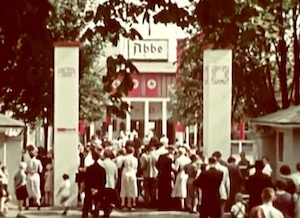 A ceremony at the Jena Stadium culminated in the formal renaming of the stadium to “Ernst Abbe Sports Field.” Abbe had set forth high standards for The Foundation, including the provision (translated below):
A ceremony at the Jena Stadium culminated in the formal renaming of the stadium to “Ernst Abbe Sports Field.” Abbe had set forth high standards for The Foundation, including the provision (translated below):
observe at all times strict neutrality towards political and religious parties.”
So this decision, in this society, was antithetical to what Abbe and the Carl-Zeiss-Stiftung had stood for. Furthermore, it was particularly hypocritical for these Carl Zeiss Foundation Board members whom had changed provisions set forth by Abbe to better suit the sensibilities of the day.
Right: crowds entering the renaming ceremony at the Abbe Stadium Jena, on 26 August 1939. This entrance is bracketed by two pillars, the one at left bearing the logo of Carl Zeiss Jena, and at right the logo of Jenaer Glaswerk Schott & Gen (37,366 bytes).
The event was sponsored by the Nationalsozialistische Gemeinschaft Kraft durch Freude (National-Socialist Community Strength through Joy) leisure organization of the German national labor organization, and the Nationalsozialistischer Reichsbund für Leibesübungen (National-Socialist Sports League of the German Reich) that controlled all sports and education physical fitness programs.
The highlights included celebratory parades with several marching bands, and entertainment for all ages throughout the city including a puppet show for the younger ones. There were sporting events at the Jena stadium that had also been decorated with prominent Nazi symbols and banners, and here there were public speakers reverberating the Nazi propaganda. Groups highlighted in attendance included the League of German Girls of the Hitler Youth, members of the National Socialist Reich League for Physical Exercise, both participating in the sports festival.
Dr. Erich Schott attended representing Glastechnische Laboratorium Schott & Genossen (Schott & Associates Glass Technology Laboratory), as did top management from Carl Zeiss Jena. The Zeiss factory newspaper Zeiss-Werkszeitung published their photograph of the stadium dignitaries box featuring three members of the Carl Zeiss Foundation Board of Management: Paul Henrichs, August Kotthaus, and Prof. Walther Bauersfeld. Seated with them were Dr. Walther Schieber in his black Schutzstaffel (SS) Brigadeführer uniform, then the economic advisor to the Gau (Nazi Party regional district) Thüringen. Between Bauersfeld and Schieber was Paul Müller in his NSDAP political leader uniform; a teacher by trade who was the Nazi Kreisleiter (District Leader) for Kreis Jena-Stadtroda, Reichsgau Thüringen. Beyond Bauersfeld was Prof. Dr. Abraham Esau, Staatsrat (State Councilor) Thüringen and Deputy of the Carl Zeiss Foundation. It was good politic to be seen with, as much as being sycophantic to, the Nazi bureaucrats as invariably they in turn conducted themselves similarly with their higher-ups.
Erich Schott gave a speech and made gestures that invigorated some in the crowd against Poland. Other speakers included Schieber, and Müller. All their speeches invariably closed with some Nazi catch phrases, and with promises of loyalty to their Fürher.
The festival concluded with a ceremonial military performance of music and drills, followed at sunset by a fireworks display. It was like many Nazi events, choreographed with professional production values intended to present an almost brain-washing experience for the participants, calculated to arouse nationalistic fervor so they might feel a part of something superior, even greater than themselves.
Zeiss During World War II:
As early as in 1937 the actions by the government of Japan in China had prompted President Roosevelt to direct his Secretary of the Treasury Henry Morgenthau to evaluate options for economic sanctions, and clear them with the Department of Justice. Tensions with Japan eased and these plans were tabled. The subsequent actions by Nazi Germany in 1938, the Anschluss and later the annexation of the Sudetenland, did not provoke U.S. economic sanctions. However, after Germany invaded Denmark and Norway on 8 April 1940 the United States responded with Presidential Executive Order 8389. The Presidential act was based of the Trading with the Enemy Act of 1917 as amended by Congress in 1933. Executive Order 8389 initially applied solely to Danish and Norwegian assets held in the United States, it attempted to isolate control of these assets, financial or business or otherwise, from Nazi Germany. This legislation also established an “Alien Property Custodian” who took control of Patents, Copyrights, Trademarks, and other assets. The Department of State had argued against implementing the order, wanting the U.S. to appear as much as possible neutral, and for as long as was practical. As Germany advanced through Europe in 1940 and 1941, the assets of those counties that became occupied were similarly frozen. On 14 June 1941 the President issued Executive Order 8785 that extended controls over: Germany (including Danzig, Austria, and Poland), Italy, the Soviet Union (only through 22 June 1941 when Germany invaded it), neutral nations, small principalities, and several countries that had not not previously been included.
While the U.S. Government confiscated patents and other assets of Nazi Germany, the American company Carl Zeiss Inc. continued doing business in New York, even after December 1941, but sold all remaining imported merchandise. Afterward, the U.S. based company provided services as possible, including routine work of maintaining and repairing microscopes for example, and eventually became more and more involved with the manufacture of products in the United States. Interestingly enough, throughout World War II one could find newly produced Carl Zeiss licensed designs of optical equipment. For example there were military issue binoculars made in the United States based on Zeiss designs, and that appear identical to those of Zeiss Jena, but that were made by United States companies.
The President’s Executive Order addressed trademarks too, so the doublet lens logo of Carl Zeiss Inc. was modified so that it bore only the ZEISS name in the upper partition, and most often with a product model (7x50 for example) in the lower partition of the logo. However, by 1944 these products being made in the USA tended to no longer bear any mention of Zeiss, or the logo, in their labeling. Throughout this time Carl Zeiss Inc. remained under the management of Dr. Karl Bauer, the corporation’s first president who was a citizen of Germany.
In the years just before and for a year or two after World War II began (arguably) in September 1939 there had been an air of invincibility in Germany. In keeping with traditional practice most Carl Zeiss products and those of other manufacturers in Germany had proudly borne the maker’s trademark and city of origin of the product. However, by late 1941 it became clear to the Nazi administration that the Allies would be able to identify factories and then bomb these targets in Germany. So in February 1942 the German Armaments Ministry assigned three letter code marks to each of those companies engaged in fabricating military hardware. The codes identified the manufacturer and their facility location. So for example Carl Zeiss Jena products employed code marks including “blc”, and later in the war “rln”, while Leitz products were identified by “beh”, and so on.
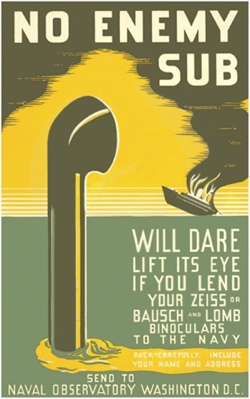 An Endorsement Of Zeiss By The U.S. Government: as had been the case when the United States entered World War I, in 1942 the military did not possess enough binoculars to meet the impending needs of their rapidly growing forces. The manufacturer’s that would in time meet that demand were just starting to gear up for war, their escalating production would not meet the demand for a year or more. So in the interim the government issued appeals for consumers to loan their better binoculars for the war effort. In a replay of the Eyes for the Navy program of 1918, in the U.S. Navy asked civilians to send in their binoculars for evaluation of suitability for service, these were sent to The U.S. Naval Observatory, in Washington, D.C. It is an interesting commentary about how well regarded Carl Zeiss Jena optics were in the years leading up to World War II when the U.S. Government published advertisements asking the public to loan their personal binoculars for the war effort the ads specifically mention Zeiss and Bausch & Lomb.
An Endorsement Of Zeiss By The U.S. Government: as had been the case when the United States entered World War I, in 1942 the military did not possess enough binoculars to meet the impending needs of their rapidly growing forces. The manufacturer’s that would in time meet that demand were just starting to gear up for war, their escalating production would not meet the demand for a year or more. So in the interim the government issued appeals for consumers to loan their better binoculars for the war effort. In a replay of the Eyes for the Navy program of 1918, in the U.S. Navy asked civilians to send in their binoculars for evaluation of suitability for service, these were sent to The U.S. Naval Observatory, in Washington, D.C. It is an interesting commentary about how well regarded Carl Zeiss Jena optics were in the years leading up to World War II when the U.S. Government published advertisements asking the public to loan their personal binoculars for the war effort the ads specifically mention Zeiss and Bausch & Lomb.
Right: one of the U.S. Navy advertisements soliciting civilian binoculars, this was printed in 1942. The text of that ad is below (44,401 bytes).
Click on image to see enlarged view.
No Enemy Sub Will Dare Lift Its Eye If You Lend Your Zeiss
Or Bausch and Lomb Binoculars To The Navy
Pack Carefully, Include Your Name And Address
Send To Naval Observatory Washington D.C.
The newly arrived civilian binocular would be inspected and if found suitable for naval use it would have a Serial No. and owners name too engraved for identification purposes. The number would be a four or five digit number followed by a dash and the year. So it is possible to find binoculars that were originally made and trademarked for the consumer market bearing military identification markings. It is somewhat ironic that Zeiss optics were pressed into service against the very U-Boats that Zeiss supplied with binoculars and periscopes.
Since regulations of the day prohibited Federal agencies, including the military, from the accepting of gifts or free loans the owner of the loaned binocular had to be compensated. So the owner received a letter from the Navy Bureau of Ships confirming the loan and providing them with the assigned serial number, the letter also enclosed a Public Voucher form to be completed and signed by the citizen. Upon return of that voucher the Navy would issue a check in the amount of one dollar, the same amount they paid in 1918, that “releases the Navy from any obligation should the binoculars be lost. All possible care will be taken, however, to insure their return at the end of the war.” After the war the owners whose binoculars could not be returned were contacted again by the Navy and offered compensation.
Back In Europe: there were forced foreign laborers (Fremdarbeiter) who were brought to work at Carl Zeiss Jena and other German manufacturing facilities. And it is certain that not all Germans were sympathetic to the Nazi regime, in fact there are known examples of intervention by the Zeiss Personnel Department to obtain the release from prison of some foreign laborers. Some Germans might warn a newcomer to “watch what you say” around certain others who might be Nazi supporters. One foreign laborer at Jena recalls visiting a couple whose son was at the Russian front and while there he dialed their radio to listen to the news from London, he was later warned such conduct in wartime Nazi Germany could lead to the death penalty.
Zeiss optics figured prominently in the success of many weapons systems. For examples there were the pressure resistant U-Boat U.D.F. targeting bearing transmitter binoculars, ultra wide angle large aperture binoculars, the stereoscopic range finders and sights used to direct fearsome weapons such as the outstanding 88mm anti-tank guns. One of the most published early photographs of the war shows Adolf Hitler outside of Warsaw, Poland in September of 1939 observing through a pair of artillery director periscoping binoculars (commonly used by a battery director to evaluate and correct artillery ranging) as the city is leveled by German artillery and air forces. Company Seven maintains a 52mm Scherenfernrohr, literally translates to shears or scissors telescope though sometimes referred to by Zeiss as Relieffernrohre or Relief Telescope, with rotating eyepiece turret of 10/20 X on exhibit in our museum collection.
Intricate examples of complex lens making were found bearing Zeiss code marks indicating production after November 1944, even though the need for such sophistication and refinement on one product in a nation beset by lack of raw materials and manpower could be questioned. In Company Seven’s collection for example we have a finely crafted hand held Zeiss 7x 50 mm binocular with very sophisticated optics marked “rln”, two custom made sets of filters, finely sewn leather case with straps and eyepiece rain guard engraved “Benutzer” (user) that was made at a time while many other Zeiss hand held military binoculars made were being shipped with painted prism housings instead of the pebble grain exteriors, and with no accessories. The Benutzer rain guard covers the eyepieces and offers protection against dirt or rain and water spray at sea; the personalization of the cover may have applied to a particular user or position (watch station for example) and is not necessarily indicative of having been made for some otherwise notable person.
The Downfall And Breakup Of Germany, And Of Carl Zeiss Jena:
Allied Bombing Campaign: in September 1939 the German Wehrmacht (military) commenced the strategy of indiscriminate bombing of civilian population centers* with those in Poland first experiencing this from the air by the Luftwaffe (Air Force), and from ground Heer (Army) artillery. On the western front the Luftwaffe attacks initially targeted facilities of tactical or strategic importance. In the early periods during the war allied air attacks too targeted facilities of tactical or strategic importance, some of these by Royal Air Force (RAF) Bomber Command actually struck targets in Germany as early as in March 1940, though with largely symbolic results.
* We argue terror bombing was pioneered by the Luftwaffe “Legion Condor” commencing in 1937, this during the Spanish Civil War that brought the Nationalists under Francisco Franco to power.
After the fall of France in June 1940 the United Kingdom was left largely alone to stand against Nazi Germany. The RAF Fighter Command was increasingly put on the defense; during the Battle of Britain they relied on “the few” to stand against the Luftwaffe. This and the U-Boat war too were strangling the United Kingdom when Germany changed their priorities in what became known as “The Blitz” that commenced on 7 September of 1940, directing bombings by the Luftwaffe against industrial areas of London (Unternehmen Loge) and of other industrial cities too. The following months saw these raids expand their reach to purposefully target civilian populations centers with the thought of destroying morale and impacting wartime production. However, the Luftwaffe had not (and would never) develop suitable long range bomber aircraft and escorts in the numbers necessary to effectively bomb distant large target areas. Given the distances Luftwaffe escort fighter aircraft had to fly and the home ground advantage of those in the RAF, the Luftwaffe paid dearly for comparatively little results. By 1942 the British RAF too launched air raids that purposefully targeted civilians of German cities.
Bombings Affecting Zeiss Facilities: after Nazi Germany declared war on the United States the major German cities were bombed by medium and heavy bombers of the Allies, increasingly at will, with some raids specifically targeting Zeiss facilities. The city of Stuttgart for example was targeted in a series of fifty-three allied air raids that commenced 25 August 1940 and continued through the course of the war; the worst raids in 1944 obliterated the central district while the Contessa factory in the Henslack district suffered only minor damage.
Jena had remained an important University city, a center of science, and because of the Carl Zeiss works and Schott AG it was an important industrial site involved in production for the Nazi Armaments Ministry. The Konzentrationslager Buchenwald (Buchenwald concentration camp) established one of their sub-camps in the northern suburbs of Jena, this housed (figuratively speaking) some 1,000 prisoners assigned to work for the Löbstedter Reichsbahnausbesserungswerk (Reichs road repair shop, or RAW), and later in 1944 these prisoners were also made available for repair of Deutsche Reichsbahn (German railroad). In addition to defense in the air by Luftwaffe fighter aircraft, Jena would over time build shelters and become defended by antiaircraft (flak) batteries, barrage balloons, and smoke generating equipment.
On the evening of 16 August 1940 four bombs were dropped by the Royal Air Force on the Gelände des Saalbahnhofs (railway station) of Jena; while the intent may have been to disable the facility the actual damage was more symbolic of what might be to come rather than significant.
As early as in April 1942 the city of Jena appeared on a list prepared by the British Bomber Command for the British War Cabinet of possible targets to be targeted for incendiary bombing, and by November that year the list had grown to include some fifty-eight cities. About one third of a typical R.A.F. bomb loading were magnesium or phosphorus incendiary bombs, the remainder being GP (General Purpose) bombs. However, the devastation caused by the purposeful incendiary bombings of Lübeck in 1942, Hamburg in 1943, and Dresden in 1945 would not be visited upon Jena.
On 27 May 1943 the R.A.F. visited again with fourteen low-flying de Havilland DH.98 Mosquito attack aircraft that dropped twenty-four 500 lb. bombs, about half of these incorporated delayed action fusing. The city sustained 12 dead and 56 wounded, while the damage was significant owing to the resultant fires. The raid no doubt impacted the psyche of the citizenry to some degree, and damaged the facilities at Zeiss. The R.A.F. lost three aircraft. The Royal Air Force did not bomb Jena again until three of their aircraft dropped twelve bombs on the city center and southern areas on the evening of 10 March 1945, and again on the evening of 15 March, both instances producing only minimal damage.
Jena was never designated by the U.S. Air Force as a Primary Target. However, on 8 February 1945 Jena was approved as an alternative Industrial Secondary Target, not so much for it’s overall value to the war effort but likely because other targets were either already effectively bombed or overrun by allied forces. So Jena was bombed by the U.S. Eighth Air Force several times late in the war, each time with increasing severity.
Mouse over to see an overlayed photo taken during an air raid in March 1945 depicting some of the bombing pattern centered just to the west of the Saale River and extending up into the railway yards (269,996 bytes). Photo by U.S. Eighth Air Force.
Click on the image to see enlarged view of Jena overlayed with the photo taken during an air raid in March 1945 (478,560 bytes).
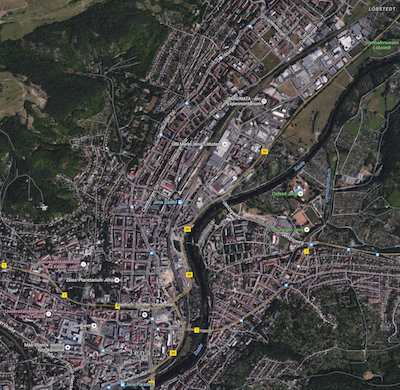
Right: Jena, Germany today. The Carl Zeiss Jena factory site and Abbe memorial are at the lower left, with the Jentower to it‘s east and Max Planck-Institute to it‘s south (380,026 bytes). Almost halfway between the Jentower and the Friedrich-Schiller-Universität Jena is the Stadtkirche Sankt Michael (Church of St. Michael) that was unfortunately heavily damaged over several raids. Image courtesy of Google.
- The first U.S. bombing raid at Jena occurred on Friday 9 February 1945, when the United States Eighth Air Force (Mission 824) dispatched 1,296 bombers and 871 fighters in six separate forces. These were primarily targeting oil facilities in Germany, while also winning a war of attrition against the Luftwaffe who suffered a total 87 aircraft destroyed or damaged against 8 United States bombers and 5 fighters lost.
Nearly two thirds of the 311 U.S. bombers are reassigned to hit secondary targets, targets of opportunity for these 198 aircraft were the munitions industry in Weimar. Of these 198 B-17G “Flying Fortresses” aircraft, 11 bombed Jena shortly after noon damaging the city center and the northern quarter, including the Stadtkirche Sankt Michael (Church of St. Michael) and the Universitätshauptgebäude (University Library), with about 27 tons of bombs. In Jena this caused 98 deaths, 53 seriously injured, and another 204 slightly injured, while some 34 remained unaccounted for.
- The second U.S. bomb raid at Jena occurred on Friday 23 February 1945, when the United States Eighth Air Force (Mission 843) dispatched 1,274 bombers in three groups, and 705 fighters. These were primarily targeting marshalling yards in Germany, while again combatting the Luftwaffe who suffered a total 31 aircraft destroyed or damaged against 1 United States B-24 “Liberator” bomber and 6 P-51 fighter aircraft lost. Of the 1,274 bombers, 368 were assigned to hit marshalling yards in Weimar, with 25 of the B-24’s targeting the yards in Jena. Nearly 60 tons of bombs started falling at 11:41 AM striking in the north east of the city, up to Löbstedt.
- On Saturday, 17 March 1945 the United States Eighth Air Force Mission 892) again visited Jena. Mission 892 dispatched 1,328 bombers and 820 P-51 fighter aircraft in three groups to strike oil, industrial, and rail transportation targets in Germany. Owing to cloud coverage over some primary targets several B-17G aircraft of the second group were diverted to bomb secondary targets, these included the 71 B-17G that targeted the Zeiss works arriving over Jena at 1 pm. The city antiaircraft defenses and the Luftwaffe had been weakened so that the B-17s dropped 210.7 tons of General Purpose (GP) explosive and fragmentation bombs, and 9 tons of incendiary bombs. Of these some dozen or fewer bombs struck the Zeiss and the Schott factories, the remainder striking the railway yard and other facilities.
Of this group of 449 B-17G, 1 was lost and 2 damaged beyond repair while 15 were damaged but repairable. The U.S.A.A.F. bombers lost 9 airmen Killed In Action (KIA), 1 P-51 pilot is KIA.
- On Monday, 19 March 1945 the United States Eighth Air Force (Mission 896) again visited Jena in the strike that caused the most loss of life, severely damaging the historic downtown, and again including the Church of St. Michael.
The Eighth Air Force records indicate this operation was originally planned to destroy airfields and industrial targets in Germany. The Eighth Air Force forces consisted of 1,273 bombers in three groups using visual and H2X radar, escorted by and 675 fighter aircraft. The Luftwaffe, though already severely depleted of fuel and experienced pilots, responded to this raid with more than one hundred fighters including a formation of 36 recently deployed Messerschmitt Me 262 “Schwalbe” (Swallow); highly advanced, this was the world's first operational jet-powered fighter aircraft.
This Monday the cloud cover prevented 496 aircraft from accurately striking primary targets, so commanders of these groups directed their aircraft to bomb secondary planned objectives. These included the optical works at Jena which were bombed by 197 B-17G aircraft of the 3rd Air Division, commencing at about 1:15 PM and concluding at 1:32 PM after some 563 tons of bombs were dropped. The bomb load included 800 incendiary devices that were dropped over the city center. The Zeiss factory was struck by about a half dozen bombs that had some effect. This one air raid killed at least 134 people (in 2015 revised after studies by the City Historian to 236), leaving some 123 injured, and with an estimated 12,000 people left homeless. Almost every old building in the city center was damaged. Overall there were 1,347 buildings damaged, of these 224 were total losses, while 261 suffered severe damage, 199 with moderate damage, and 663 with lighter damage; Jena had become the most devastated city in the State of Thüringia.
This bombing raid was witnessed by Lucas Van Hilst, he recounted in a letter sent to us at Company Seven:
- “I was standing outside a zig-zag 'Schutzgraben' (protective ditch) looking up to 'my friends', the first wave of whom just passed by so to speak. Then suddenly a German soldier on leave grabbed me by the arm. “Mach’ schnell, 'runter!!”. The suction of an explosion threw me down the stairs. He may well have saved my life. In the center section several persons were killed or wounded. The last bombardment was the worst. The sight of carts loaded with dead bodies was shocking - as it would anywhere. That air attack did substantial damage to some Zeiss and also to Schott buildings (where one of my Dutch friends was killed). The rather small “Alte Stadt” (Old Town) was totaled. Visiting in 1994 it still was a sad sight.“
The losses of aircraft and crew in this region were reported as:
- Luftwaffe: 3 aircraft were destroyed, 1 likely damaged beyond repair, and 5 missing.
- U.S. Air Force losses by aircraft and flak included: 4 B-17G bombers lost (2 in the vicinity of Jena), 4 were damaged beyond repair, and 121 damaged (46 in the vicinity of Jena); 9 airmen were Killed In Action (KIA), 5 Wounded In Action (WIA), and 49 Missing In Action (MIA).
- On 9 April 1945 Jena was again attacked by the U.S.A.A.F. This time it was the Primary Target for 86 B-26 “Marauder” medium-range bombers of the 9th Bomber Division of the Ninth US Air Force. Between 16:14 to 16:53 they dropped 151 tons of bombs on Jena. The train station, the existing rolling stock, and approximately 105 surrounding buildings were largely destroyed. There were 108 deaths. In addition, another 6 aircraft loaded with 11 tons of cluster bombs attacked the city antiaircraft positions.
Luftwaffe losses this day over Germany amounted to a total of 41 aircraft destroyed, 3 likely damaged beyond repair and 19 missing, the Luftwaffe losses included 3 Me 262 aircraft. The U.S.A.A.F. total losses amounted to 6 bombers and 10 fighters are lost.
Jena in March 1945 was a transit center with people coming in and out, and with fluctuating numbers of refugees and forced laborers too. So it is likely the exact number of casualties on the ground during these air raids will ever be known.
A memorial was established at the Rathausgasse of Jena, and here every 19th of March the dead of that bombing raid are remembered with a wreath. To this day this is a difficult commemoration because many citizens see that event, and the postwar partition of Germany too, as part of what resulted from the actions of the Nazi party. In Jena too there had been Nazi era perpetrators, who as one publication explained “were guilty of the exclusion, persecution and murder of many people”. Another memorial the “Stele zur Judenverfolgung und KZ-Zwangsarbeit” (Stele on the Persecution of Jews and Concentration Camp Forced Labor) in Jena was established at the Löbstedter Straße 56, this commemorates prewar Jewish residents who were interned at the behest of the Jena Mayor near the site. This also marks the site of the satellite camp KZ Buchenwald eichsbahnausbesserungswerk (RAW), a Reichsbahn rail system repair shop sub-camp in Jena.
There is evidence that the disruptions of raw materials and transport were having some chain reaction effect at Zeiss facilities, and those who depended on products coming from Jena. In March 1945 the completion and delivery to the military of several new “Jagdtiger” (Hunting Tiger) tanks were being held up by the late delivery of the special shock resistant, precision sight components from Carl Zeiss Jena. The heaviest operational tank of the war, these tanks are armed with a high velocity long range 128mm gun and with armor so thick and well engineered that they could resist almost anything that ground forces or their opposing armor could shoot at them. Some allied ground troops can thank the air forces for sparing them from more encounters with these opponents.
Towards the end of the war in Europe one of the last decisions made in the selection of targets for the allied air forces was whether to bomb Schweinfurt, known for its ball bearing production and also for an October 1943 bombing campaign that resulted in tragic losses for the U.S. Army Air Forces and the German Luftwaffe, or to bomb Jena with its Carl Zeiss and Jena works. Schweinfurt was selected even though by then more than 35% of its production from the five factories there had been dispersed to other facilities.
Advance to Jena, Capture, Then Handover: on 2 April 1945 elements of the 90th Infantry forces of the U.S. Third Army under Lieutenant General George S. Patton, Jr. (promoted to General on 14 April 1945) came upon the Kaiseroda salt mine near Merkers, a few miles inside the border of Thüringia. The mine was cleared on 4 April by a patrol of Company I, of the 3rd Battalion, 358th Infantry Regiment. This mine was found to house currency including: 98 million French francs, 2.7 billion Reichsmarks) and gold and coin including the entire gold reserves in 550 bags each of 55 to 81 lbs. totaling nearly 250 tons from the Reichsbank in Berlin (including 711 bags each filled with $25,000 in U.S. $20 gold coins). And as silent testament to victims of the Nazi’s there were stacks of valuables taken from those at the death camps: jewelry - wedding rings, watch cases, gold-filled glasses, teeth with gold and silver fillings, etc. For safekeeping from Germany there were some 400 tons of art, dozens of complex microscopes and other optical instruments made by Zeiss and others, along with plunder from conquered nations. The entire U.S. Army 712th tank Battalion and the 357th Infantry Regiment were diverted to guard the mine in preparation for removal of the items to the Reichsbank building in Frankfurt, Germany.
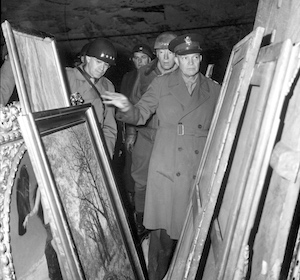 In possibly the only humorous aside to this tragedy, on the morning of 12 April General Dwight D. Eisenhower, Supreme Commander of the Allied Expeditionary Force in Europe, General Omar Bradley, Lieutenant General George S. Patton, Jr. and Major General Manton Eddy took the elevator ride 1,600 feet down the shaft. Upon reaching the bottom of the shaft the elevator doors opened to reveal one lowly Army Private on guard duty, he stumbled while rising to salute and through the tomblike stillness that stunned soldier was heard to mutter “Jesus Christ!”
In possibly the only humorous aside to this tragedy, on the morning of 12 April General Dwight D. Eisenhower, Supreme Commander of the Allied Expeditionary Force in Europe, General Omar Bradley, Lieutenant General George S. Patton, Jr. and Major General Manton Eddy took the elevator ride 1,600 feet down the shaft. Upon reaching the bottom of the shaft the elevator doors opened to reveal one lowly Army Private on guard duty, he stumbled while rising to salute and through the tomblike stillness that stunned soldier was heard to mutter “Jesus Christ!”
Right: U.S. Army General Dwight D. Eisenhower, Supreme Commander of the Allied Expeditionary Force in Europe, accompanied by Gen. Omar Bradley, Lt. Gen. George S. Patton, Jr., and Major Gen. Manton Eddy, touring the Kaiseroda mine near Merkes on Thursday 12 April 1945 (45,860 bytes).
Click on image to see enlarged view (347,328).
Among the most disconcerting encounters for the allied soldiers were the concentration death and labor camps. On 4 April 1945 U.S. Third Army forces captured Ohrdruf, a sub camp of the Buchenwald complex. On 11 April U.S. forces captured KZ Buchenwald, located only about 18 miles west-north-west of Jena. Here prisoners were assigned as slave labor to manufacture and assemble items including military equipment.
As a U.S. soldiers approached one of these camps prisoners were observed throwing binoculars over the fence to the passing GI’s. One of these cased binoculars, in amazingly good and complete condition, was gifted to Company Seven's owner by family, the widow of a U.S. Army Major. This “liberated” Carl Zeiss rln 7x 50 binocular remains exhibited at our museum amongst other World War II military issue Carl Zeiss binoculars. When gifted some four decades after the war we could not be certain this binocular was made or assembled at the prison camp, or whether it had simply been new stock at the camp, but the U.S. officer was there and that is how the widow recollected his explanation of how he acquired the binocular.
Owing to the magnitude of the humanitarian catastrophe reinforcements were called, and on the next day the U.S. Army 80th Infantry Division arrived at Buchenwald. Allied soldiers were stunned by what they observed, they became angered at the Nazi SS associated with these camps and those who enabled them. Later on 12 April, after visiting Kaiseroda, these top Generals visited Ohrdruf. After touring the camp General Eisenhower wrote in part:
“I have never at any other time experienced an equal sense of shock.”
The U.S. Army code for the city Jena was J7082. J7082 was assigned to the 317th and 319th Infantry Regiments, 80th Infantry Division. After Weimar surrendered the U.S. Army sent a German Ordnungspolizei Oberst (Colonel of Police) from Weimar to Jena conveying a surrender ultimatum however, Jena declined (author’s opinion here - those Nazis in charge at Jena were not just nuts, but deluded f'ing nuts!) The nearly 6,200 battle hardened soldiers and officers of these U.S. Army combat teams, supported by artillery, tanks, and U.S. Army Air Force too would ensure that by 3 pm on 13 April any resistance in Jena would either have surrendered or been destroyed.
The US Army 319th Infantry Regiment was under the command of Colonel Normando A. Costello (19 June 1905 - 22 November 1985), an experienced field officer who among many honors earned the Silver Star in combat. He would retire in 1964 as a U.S. Army Major General. As parts of U.S. Army battle summaries convey (dates adjusted one day forward, this actually commences 12 April after Weimar surrendered):
The 319th (Infantry Regiment) 2nd Battalion was relieved by the 2nd Battalion of the 317th (Infantry Regiment) at 1700 hours, and moved to GRETSCHWABHAUSEN (J6366) (Großschwabhausen, about 4 miles west of Jena) north of and abreast of the 319th 1st Battalion which had advanced without opposition by motor to GOTTERN (J6261) (Göttern) where it had dismounted and made preparation for the attack on JENA (J7082). The 3rd Battalion on the south had advanced without opposition to NIEDERSYNDERSTEDT (J6060) (about 7 miles west of southern Jena) where it prepared to cross the Saale River with CCR (Combat Command Reserve forces) of the 4th Armored Division, over a bridge to be erected by the CCA (Close Combat Attack forces) during the day at MAUA (J7159).
The 1st Battalion in the meantime waited for the 2nd Battalion to come abreast on its left flank, sent the I and R platoons to check the woods screening it from JENA. The I and R platoons fired a volley of MG (machine-gun) fire into the woods and 40 PWs (prisoners of war) came out. A squad of Inf then went with the I and R platoons and checked DOBREISCHEN (J6364) (Döbritschen) which was unoccupied. The squad of infantry was left to hold it as this was to be the LD (line of departure) for the planned night attack of the 1st Battalion on JENA.
Colonel Costello briefed the 1st and 2nd Battalion COs on the plan which was for the 1st Battalion to strike straight into Jena from the east, while the 2nd Battalion from GRETSCHWABHAUSEN (J6366) swept the woods southwest of JENA to the Saale River. The 1st Battalion with B Company leading, and A and C companies echeloned to the right rear, attacked at midnight, but the attacking elements ran into a defended roadblock at (J677667) after it had left DOBREISCHEN and Captain R Scott, CO of Company B, was killed so the attack was called off for the evening (and a defensive perimeter established). The attack (on Jena) was postponed until the dawn of 13 April.
The 319th 1st and 2nd (Battalions) attacked at first light (07:30), and after fighting small arms - Panzerfaust, bazooka and sniper fire, the 1st got to the town at 130930 April (9:30 am on 13 April). The 2nd (Battalion) had swept to the S through the woods and was checking the small towns that lie around Jena, and was entering the city from the south to make contact with the 1st Battalion, before crossing the Saale River.
When the attack commenced soldiers of the 319th 1st and 2nd Battalions encountered what was described as “strong resistance in the steep wood approaches to Jena“ but by 11:30 the 1st Battalion had cleared all resistance to the west of Jena and entered the city.
The 319th 1st Battalion fought through Jena during the day in house to house combat. The 80th Infantry Division left one battalion of the 317th infantry to maintain law and order in ERFUT which fell on 121900 April (7 pm, 12 April), and moved up two battalions of the 317th Infantry, to aid in the reduction of Jena (J7082). The 1st and 3rd Battalions, 317th Infantry, struck it from the north, while the 2nd Battalion 319th Infantry, relieved in WEIMAR, skirted the town from the N and blocked the eastern approaches to JENA which was reduced at 131500 Apr. (3 pm, 13 April).
The 3rd Battalion 319th Infantry, in reserve at NIEDERSYNDERSTEDT, was alerted to move forward after Division had called (131630 Apr) and ordered elements of the 319th to take over a bridge from the armor over the Autobahn in the vicinity of GOSHWITZ (J7160). Colonel Costello went forward and made arrangements with the C/S 4th Armored Division to move his motorized infantry units forward (3rd Battalion) on the S part of the Autobahn while CCR, which was following CCA on the southern portion of the 4th Armored Division right flank, used the northern double lane. The 3rd Battalion moved forward on the southern portion leaving one squad at GOSCHWITZ (Göschwitz, south end of Jena) and one Co (company) of Infantry at the Autobahn CR (J8961). The remainder of the Battalion moved into the vicinity of (K0265) north of GERA (26 miles east of Jena) and relieved elements of the 4th Armored Division along the Autobahn, and over the Autobahn bridge (K032654) over the WEISE ELSTER River north of GERA. The Regiment then planned to seize GERA while the 4th Armored Division continued its drive to the east.
The 1st Battalion had in the meantime cleared JENA and was sent in trucks along the Autobahn to TOPPELN (K0063) (Töppeln, about 20 miles east of Jena) where it arrived at 132300 Apr (11 pm, 13 April) and was instructed that its mission would be to clear out the woods lying to the W of GERA.
Another combat report, this one from the 317th that attacked Jena with the 319th, mentions on 13 April “relieved elements of 4th Armored Division in GERA...maintained law and order in JENA...scattered resistance encountered in clearing Jena east of the SAALE River; captured Approx. 250 PW’s.” On the 14 April the 317th Regiment recorded in parts “relieved elements of the 319th in JENA...mopped-up areas in vicinity of GERA, JENA and EISENBERG; captured Approx. 900 PW’s, including a Brig General, with his staff of four Officers”
While parts of the city of Jena were obliterated by air bombardment and some by combat operations, the Carl Zeiss factory had sustained what the U.S. Army accounts described as “surprisingly little effective bomb damage”. By then the original large planetarium test dome was gone, even though nearby on another rooftop the telescope observatory dome remained intact. Civilians and the US Army engineers proceeded to remove debris to clear access routes, and begin clearing debris. The photo below shows some of the progress, when compared to photos taken just a month before.
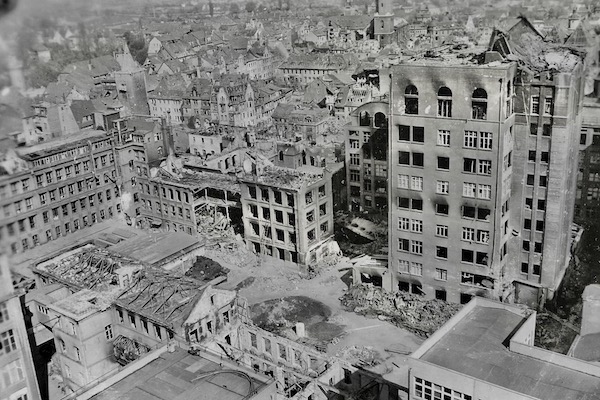
Above: central east area of Zeisswerke Jena, after the U.S. Army Air Force bombings 17 and 19 March 1945.
View looking northeast from area of the telescope shop, May 1945. Bau 15 (Building 15) at right, Germany's tallest building when completed
in 1916, had several floors damaged by bombs and subsequent fires. However, Bau 15 remained structurally sound enough to be rebuilt.
Several other structures in this area of the factory, and in the city of Jena, were also damaged or destroyed.
At top of the photo, right of center, is the lower spire of Stadtkirche Sankt Michael (St. Michael Church), heavily damaged by bombs (123,994 bytes).
Click on image to see enlarged view (401,265 bytes).
“Operation Paperclip”, and then Partition: the Yalta agreement fashioned between the allies political leadership had predetermined that Germany would be partitioned into four zones, each under control of a major ally: England, France, Russia, and the U.S.A. All of the Carl Zeiss facilities except the Contessa works in Stuttgart (then occupied by the French, but designated for U.S. control) were in what would become the Russian zone of occupation. And so the U.S. military forces at Jena proceeded to evacuate manufacturing assets and documents over the course of several days.
At least some foreign laborers went with the U.S. Third Army to act in capacities such as “member-translator” of outfits such as the “Civic Affairs Team TA-4” traveling as far east as Vimperk (Winterburg), Czechia. With the rapid advances into areas being newly occupied the letter of the law or procedures were not always adhered to; just imagine running into a person in U.S. Army uniform carrying a carbine and bearing a Dutch passport!
However, with the end of the Third Reich in sight the advancing allied forces would discover interesting products of German research and development efforts in many areas including optics. Among these was the “liberation” of two of the probable three or more “Doppelfernrohr” (double telescope) 20 + 40x 200 mm binoculars completed by Carl Zeiss Jena in 1944 or possibly 1945. Each refractive system incorporates 45 degree inclined wide-angle eyepieces providing 2.25 and 4.5 degrees actual field of view. Each binocular weighs about 460 lbs (209 kg), and with stand may have weighed about 1200 lbs! One instrument remains in the United Kingdom, the other (serial number 3) is property of the Smithsonian Institution Naval Historical Museum. After sitting in a warehouse for some fifty years, the U.S. example underwent a comprehensive restoration by the late Mr. Kevin Kuhne in Sandy Hook, Connecticut. Since there was no appreciable interest to display them the U.S.A., the restored example was loaned by the U.S. people to the custody of the Wehrtechnischen Studiensammlung (Defense technical study collection) military museum in Koblenz, Germany where they are now on proper display.

The Americans “Operation Paperclip” was a classified program, where they compiled a list of German people who were determined to have value to the allies, and who would be subject to evacuation to the west as the area was transferred to Soviet occupation. Among the most vital staff of Carl Zeiss Jena to be evacuated were: Professor Dr. Ing. Walther Bauersfeld (b. 1879, d. 1959) Scientific Head with the company since 1908.
Right: Prof. Dr. Ing. Walter Wilhelm Johannes Bauersfeld, later when at Carl Zeiss West Germany (60,470 bytes).
Also selected for relocation to the west were Dr. Ing. Heinz Kuppenbender, Professor Dr. Joos, Paul Henrichs, who with about 130 engineers and technicians were evacuated to western Germany occupied by allied forces to what would become the Federal Republic of Germany. These also included 41 employees from Schott, and some 200 from the University of Jena. American officials advised the evacuees (reportedly in an early version of “make them an offer they can not refuse”) that they would be moved to the American Zone of occupation. There are accounts that some went voluntarily, while others were given no choice. U.S. Army trucks were assigned to move the families who were afforded only enough time to pack a suitcase. The 65 year old Frau Bauersfeld was allowed to take (as a last minute concession) one armchair for the long ride in the back of the truck. Months later, with the help of a neighbor and some luck one of Prof. Bauersfelds daughters moved the family Steinway piano from Jena on a railway car to Heidenheim. Carl Zeiss Administrator Joos later went on to work in the United States.
With the U.S. forces scheduled to withdraw in compliance with the Yalta agreements, a final meeting to coordinate the handover to Soviet Union forces was held on 30 June at Wiesbaden between U.S. Army Lieutenant General Wade H. Haislip and Marshal of the Soviet Union General Vasily I. Chuikov. General Chuikov was a combat-hardened leader who had personally developed tactics to minimize the strengths of the German Wehrmacht at the defense of Stalingrad, he later accepted the unconditional surrender of German forces from General Helmuth Weidling in Berlin on 2 May 1945. Shortly afterwards the remaining U.S. military forces commenced departing Thüringia and headed west. On 1 July the Soviet advance military forces arrived in Jena, there was some overlap with U.S. Army forces, until by midnight 4 July when the Soviet troops occupied the remainder of what became East Germany (German Democratic Republic) including Jena. A new Mayor was appointed for Jena, as the Soviet authorities set up a antifaschistische Komite (anti-fascist committee) to root out Nazi sympathizers and insure those in authority implemented the Soviet agenda.
The Russian forces and their representative demanded and obtained the best of what could be provided in terms of facilities, accommodations, and any remaining stocks of supplies. As was mentioned by the soon to be appointed new Mayor of Jena in his diary entry of 9 July:
while the Russians, at any rate, have so far only issued "orders".”
The Soviets ordered the inventorying of all personal, business and civic assets in their occupied zones. Banks were closed, deposit boxes forced opened and all were confiscated including family personal mementos. In their version of Operation Paperclip, persons deemed valuable to Soviet enterprises were identified for relocation, some in Germany used the term for kidnapped, to the Soviet Union.
Resurrection - The Post World War II Zeiss Companies East And West:
German military and civilian optics of the period including photographic equipment and sporting optics, remain among the most sought after “war trophies” taken home by occupying forces. To this day many people believe their grandfather’s undocumented binoculars were the personal Zeiss field glasses of the famous Wehrmacht Field Marshal Erwin Rommel. We cannot count how many German Kriegsmarine tugboat or auxiliary binoculars are out there today being marketed as those employed by sailors of the highly respected U-Boat forces.
The abrupt end of the war left manufacturers in Germany, as in the United States and elsewhere, sitting on hodgepodge stocks of military hardware, spare parts, and stocks of new parts awaiting assembly. But within as little a few weeks after the fighting concluded, some Carl Zeiss Jena facilities were back at work. The Contessa works at Stuttgart resumed production of Ikonta and Nettar film cameras.
At Dresden, the Contax rangefinder camera manufacturing dies, parts, and equipment along with some staff were transported to Kiev. In part the Russians, and some other allies too, wanted to emasculate Germany and gather whatever reparations they could against a Nazi Germany that had decimated Russia’s population (even if less so than Stalin). Furthermore, the Russian well-founded fear of possible further conflict with the western nations rendered relocating any production capability into a more defensible Soviet province a logical strategic step.
Elements of Carl Zeiss gradually returned to manufacturing and while at least initially their items were made for the civilian market, these tended to be items they had manufactured prior to the war that could be afforded by occupying soldiers for example. In time Zeiss would return to manufacturing for export and for military markets too. The initial post war production inventory coming out of the various Carl Zeiss Jena facilities commenced as early as late 1945, these included photographic cameras, lenses, and binoculars.
In the case of binoculars for example, those produced soon after the war were basically military models cobbled together from stock of parts left over from the war. The individual focus binocular models, including 8x 30, 7x 50, 10x 50, etc., were nearly identical to those made before May 1945 that would have borne the simple armaments code mark “rln”. The post war models were in fact identical other than their left side prism housing now bore the pre war Carl Zeiss Jena logo, and the consumer oriented models lacked any integrated measuring reticle. For the first year or two of production many of the binoculars assembled used existing wartime stocks of painted prism housings and objective tube barrels, instead of being covered with the pebble grain leather covering as had been typical of production models from before the war and through the later years of the war.
By the Summer of 1946 the decisions were finalized by the Soviet administrators of the occupied zone of Germany mandating what companies, or portions thereof, would be disassembled and confiscated. By 11 October 1946 the dismantling of manufacturing equipment at Carl Zeiss Jena and Glas-fabrik Schott too had commenced, as was mentioned by one who observed it “down to the elevators and window fittings”. By about one year later the Soviets had completed packing and evacuating much of the remaining technical and management staff, and about 92% of the Carl Zeiss Jena manufacturing facilities to the east and well into Russia. This became the basis for the development of several Russian and Ukrainian optical companies that prosper to this day.
Other German manufacturing assets too were confiscated under the reparations provisions and these resulted in the gutting of many other German factories, mostly in the Russian occupied zone.
Two Zeiss Companies: while Carl Zeiss Jena was reorganizing under Soviet control, and before West Germany was formally established as a republic, the “Zeiss Stiftung von Jena” (Zeiss foundation) was established at Heidenheim, with the “Opton-Optische Werstatte Oberkochen GmbH” (abbreviation of Gesellschaft mit beschränkter Haftung, akin to a limited liability corporation in the United States) factory located at Oberkochen on the banks of the Kocher River, near the city of Stuttgart in the State of Baden-Württemberg. The Schott Glass Works subsidiary was located at Mainz, the capital of the State of Rhineland-Palatinate. The most important provisions of the organization were:
- The Carl-Zeiss-Stiftung is the sole owner of Carl Zeiss and Schott Glaswerke
- Financial resources must be obtained independently by Zeiss Stiftungs own efforts
- No external influences e. g. by private persons, and no capital from external sources or the government
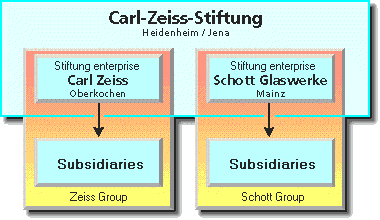
By 1947 the enterprise at Oberkochen was doing business as “Zeiss-Opton-Optische Werstatte Oberkochen GmbH”. Soon, the Hensoldt facilities at Wetzlar resumed production, while microscope production resumed at the Winkel factory at Göttingen, and eyeglass production in Aalen. On 3 March 1948 the transfer of Zeiss Ikon headquarters from Dresden to Stuttgart was formalized. In 1951 the Zeiss Ikon factory facility at Stuttgart would be about doubled in size to accommodate the headquarters and production operations.
Shortly after the war Carl Zeiss, Inc. in the United States resumed the import of products from both Zeiss Jena and Zeiss Oberkochen. And by 1960 the U.S. based Zeiss company was again fully owned by Carl Zeiss GmbH of West Germany. Dr. Bauersfeld continued to work there until he passed away in 1959 at age 80!
While Jena had already resumed the manufacture of some products it was on 1 July 1948 that the East Germans, now independent of Carl Zeiss Oberkochen, formally reorganized the original factory in Jena as a state-owned corporation to be known as “V.E.B Carl Zeiss Jena” (Volks Eigene Betrieb translating to People's Own Company) under Dr. Hugo Schrade. The reorganized Carl Zeiss Jena, under the close direction of the East German government, gradually resumed production of microscopes, measuring instruments, astronomical telescopes, photographic lenses, military and sporting optics.
By 1949 in Dresden cameras such as the Contax II single lens reflex with a new 42mm threaded mount, and camera lenses such as the “Sonnar” were in production with all internal and external air to glass surfaces being “T” anti-reflection coated. The occasional similarity of appearance, of design, and the interchange ability of Zeiss Jena and Zeiss Oberkochen components such as components for microscopes, and cameras was more than by accident. For example, some binoculars marketed by Carl Zeiss Oberkochen (bearing the trademark “Optron”) were actually made under contract by Carl Zeiss Jena.
As diplomatic relations between East and West bloc nations were closing, both Carl Zeiss companies sought out new sources of components, even some subcontracted products. During the post war period up to about 1952 there were hopes for a German reunification and so the Zeiss counterparts actually worked to help each other recover to some degree. The hopes for reunification were dashed as the East German political leadership assumed firm control of all commercial enterprises; from then until reunification the Communist Party and its system of promotion by political achievement (which appointed top management) would determine the course of company policy.
The Deutschen Demokratischen Republik (DDR, or East Germany) set about to restore manufacturing capacity with the hopes of sustaining their own nation, supporting the Soviet Union and allied Soviet Bloc nations. Part of their program was aimed at becoming a force in the commercial sectors, at least initially for what were gradually being termed the Eastern Bloc nations in Europe with hopes of also finding customers in the Western Bloc and beyond. They had some head start in that prior to World War II German industrial production qualities and innovation were penultimate, highly regarded and marketable. Now under the Communist economic structure, industries of the DDR might be able to resume manufacturing, but sell at lower costs based on the deflated exchange rates of their German currency that was from 1948 to 1964 the Deutsche Mark.
Going into the 20th century German manufacturing had earned reputations for innovative engineering, and consistently high qualities of manufacture and finish. Part of this was attributable to standards established by The Deutschen Instituts für Normung (German Institute for Standardization, or DIN), established as the Normenausschuß der deutschen Industrie (Standards Committee of German Industry, or NDI) on 22 December 1917. The descendant of this today is the Deutschen Instituts für Normung (German Institute for Standardization, or DIN), it continues to set standards developed under the direction of working committees of the organization, these are termed a DIN standard.
The process of manufacturing complex products in Germany tended to produce relatively modest quantities per lot, with interruptions at several stages for quality control inspections and testing. The craftsmen had extensive training and experience, a good formal education or had served an apprenticeship to learn their trade*. These were among the reasons why German-made industrial and mechanical goods tended to be comparatively superb, and cost more than those made in most other countries. The craftsmen and factory employees of what were now two Germanys were brought up this way, and they intended to restore production to their pre war high standards.
* in the 1990s Martin met with a (reunified) Zeiss executive. Martin mentioned how part of the appeal to persons buying a Carl Zeiss optical product was the impression that there were top German Ph.D's in their white laboratory coats meticulously crafting each item. The Zeiss executive replied, with a smile, "no not that, he is certainly competent but is probably a Turk", referencing the recent influx of refugees and immigrants to Germany.
Qualität Gütezeichen (Quality Seal of products produced in the DDR):
The Deutschen Demokratischen Republik (German Democratic Republic, or DDR) sought ways to reassure the world markets that their products were as advanced, innovative, and manufactured to the exacting precision standards as they had been prior to the war. Part of the programs set forth were the continuation, under management by Soviet and DDR communist parties, of government organizations to establish and enforce standards. The DDR established organizations to set standards for building codes, and for many other areas including industrial and consumer products that would 'fly the flag' of the DDR, not only at home but overseas as well.
The standards for industrial and consumer products of the DDR were administered by the Deutschen Amt für Meßwesen und Warenprüfung (German Office for Metrology and Product Testing). Products that complied with the Technische Normen, Gütevorschriften und Lieferbedingungen (Technical Standards, Quality Specifications and Delivery Conditions, or TGL) quality standard TGL 3933, were awarded a specific quality mark. This program issued certificates that would entitle the manufacturer of the approved product to affix a specific Qualität Gütezeichen mark to the approved product. There we several grades of quality that could be designated, each represented by their own quality seal.
There are some misunderstandings out there about how the process worked, how that resulted in a product bearing a Quality Seal; there are even several misinterpretations of the meanings of these marks. The author was brought up with some of these misconceptions until well after he came to Company Seven. We dispel some here:
- The items bearing these marks were not individually selected and certified, but each were among a group of the same product made to meet the standards set in their certificate. These were not individually selected goods from a production line or lot.
- There were several grades of certification, each with its own mark.
- We have observed modest variations of the logos, likely owing to subtle font styles availability or machine setup differences from one shop to another. Examples of the three Quality Mark Q shown in the table below show minor differences. For example, the tilde character (~) to form the stylized letter Q could appear connected to, or detached, at the bottom from the “O”. The ~ might be centered, or offset slightly to the right. The font style of the number 1 could vary slightly.
- The top rated quality has been explained to us as one of various designations of prime or excellent including : Hervorragende Qualität, Erstklassige Qualität, Prima Qualität.
- The certification committee process weighed factors including: the innovativeness of the design, engineering and functionality of the item, the consistency of the process of manufacture and assembly, with examinations and testing of samples by experts in the specialized committee of the German Office for Metrology and Product Testing. Their determination would determine whether or not the item would earn a quality seal, and at what level it would be awarded, and for how long.
- If a product was approved, and issued a mark, then this was valid only for the period of time (months or years) indicated on the certificate. If the manufacturer wanted to continue production beyond the issued term, then they had to apply for the new certificate.
- There were instances where a very good to excellent item was custom designed for one project, or produced in very small numbers for a short term. The factory might spare themselves the added effort and expense to submit an application with sample for certification. So, not having a Quality Mark did not necessarily mean the product was not a high achievement.
We at Company Seven have observed signs these programs were being applied during the manufacture of some products produced at industrial or artisan levels in the DDR by 1949. By the early 1950s it appears Carl Zeiss Jena and its affiliates were participating with the Qualität Gütezeichen mark being applied to many of the items produced by Carl Zeiss Jena and its affiliates. These products submitted for a Quality Seal included cameras, camera lenses, binoculars, telescopes, microscopes, and more.
Example illustrations of the marks, with brief descriptions of their meaning, are in the table below.
 S Special Class, Quality Mark S Very good quality products. Applied into the early 1960s. This preceded Quality Mark Q. |
Excellent Quality, Quality Mark Q Top rated products above world market average, used since the early 1960s. |
 Grade 1, Mark 1 Good quality products corresponding to the world market average. |
 Grade 2, Mark 2 Sufficient quality products suited for the intended use but not meeting the world market average. |
 Not Classified, Quality Mark (blank) Products not classified in a quality but might earn either quality class 1 or 2. |
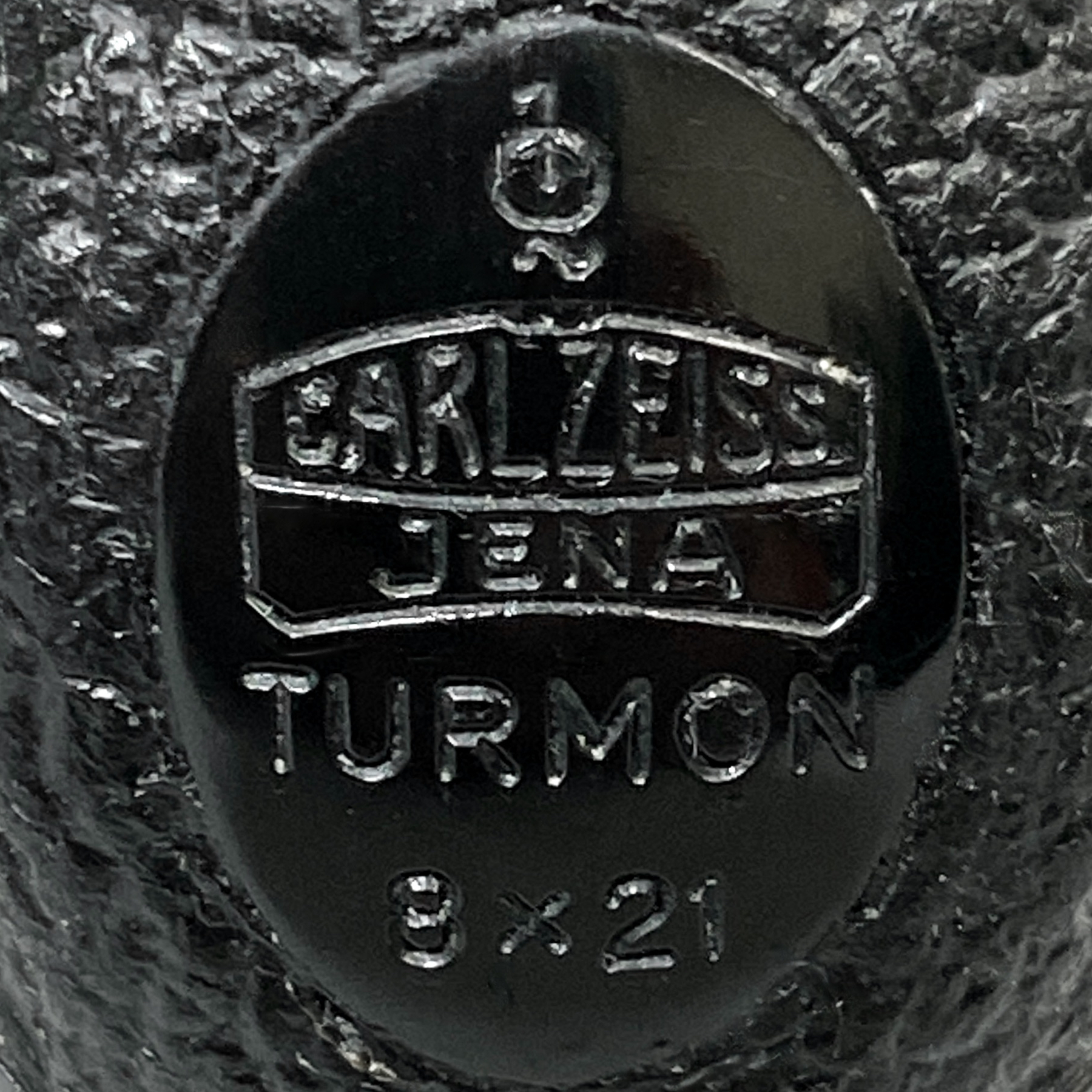 Excellent Quality Mark on a Turmon Q mark applied to a Carl Zeiss Jena Turmon monocular exhibited at Company Seven. |
 Carl Zeiss Jena logo and Q logo plate, as applied to several products meeting their highest standard in the 1960 to 1980s era. Exhibited on a microscope at Company Seven. |
This German program was in some ways mimicked in Japan, meant to assure consumers would be more trusting of products bearing a label certifying consistency and quality. In the Japan of the late 1940s and early to mid 1950s, the comment “Made in Japan” was often considered derogatory, implying cheap build and poor quality. They worked to improve the qualities and perceptions of their goods. By the late 1950s and into the 1960s independent optical organizations set standards such that when a manufacturer could certify compliance, they would be allowed to affix a stick-on approval label to the merchandise. For example, makers of binoculars who complied with the standards of “Japan Binoculars Export Promotion Association” (JBEPA) could affix a PASSED sticker of approval by Japanese Binocular Inspection Institute. Another for telescopes by “Japan Telescopes Inspection Institute” (JTII), and so on. This continued well into the 1980s, especially on the more moderately priced optics. Note, in terms of aspects including engineering, performance, finish and durability these Japanese programs and their products were not then intended to compete against top of the line premium goods coming from countries including East Germany or West Germany.
By 1954 the Zeiss Jena works had reestablished their ability to produce world-class planetarium projectors, the first completed unit being delivered in 1954 to the Volgograd Planetarium in Russia.
One interesting experiment at diversification by Jena occurred in the mid 1950’s; Carl Zeiss Jena produced four variants of a model two-cycle diesel engine (“Aktivist”) for hobbyist applications in model cars, planes, and boats! In 1956 Carl Zeiss Jena VEB introduced the “Jena Review”, their own publication to highlight their accomplishments in a manner similar to the “Zeiss Information” published by the West.
In another footnote, by 1956 some Carl Zeiss Jena production, mostly photographic products including the Werra cameras, was moved from the Jena works to about eight miles east in nearby Eisfeld, still in the State of Thüringia. There have been some references pointing to Eisfeld handling assembly of sporting optics, including binoculars, but records at Company Seven can only point to this having transitioned from Jena to Eisfeld commencing in 1968, with full production reached by about 1971. Records show the production ramped up from 1971 with almost 71, 198 binoculars completed, and reaching 130,480 units by 1975.
In West Germany camera and camera lens production were underway at the “Contessa” camera factory in Stuttgart. In May 1950 at the Photokina camera show, Zeiss introduced their new “Contax IIa” 35mm rangefinder camera bearing the “Zeiss Ikon Stuttgart” mark.
By 1953 it could be argued that microsurgery was rendered possible with Zeiss Oberkochen surgical microscopes. In 1953 Oberkochen introduced a publication “Zeiss Information” to highlight the latest innovations at Zeiss.
In 1954 the Oberkochen facility produced its first binocular: an innovative very compact 8x30mm Porro Prism model made possible in part by their development of the air spaced objective. In 1958 Zeiss Oberkochen introduced an improved wide angle eyepiece designed by Horst Kohler and Helmut Knutti; designated by the binocular model designation suffix “B” (for Brillentrager spectacle wearer) this allowed persons wearing prescription spectacles or sunglasses to see the field of view with none or little vignetting. Also in 1956 they developed a new flexible gasket system for their central focus binoculars which substantially improved the sealing of the interior optics against dust, dew, light rain.
By 1954, Carl Zeiss Oberkochen had acquired a majority stock holding in Hensoldt, so by 1964 Zeiss relocated all binocular production to its Hensoldt subsidiary works in Wetzlar. In 1968 Hensoldt became a fully owned member of the Carl Zeiss Oberkochen group. To this day, binoculars and riflescopes made there bear either the Zeiss or Hensoldt trademarks - the Hensoldt trademarked labeling being reserved primarily for products destined to industry, or the military and law enforcement markets.
Among new Carl Zeiss Jena VEB facilities at Eisfeld were those opened in 1961 for the manufacture of synthetic optical crystals. These materials were vital for the fabrication of optical components within microscopy, astronomy, photography, medical and laser technologies. One of the important products to come from this investment was the growth of high quality Calcium Fluoride crystals. These were synthesized, eventually by both Zeiss companies, employing the Stockbarger process that takes weeks to show results.
* the offerings diversity and capacity too gradually increased so that by 1991 Jena offered at least nineteen (19) different materials grown from melts and solutions, having made something on the order of two hundred fifty (250) tons of materials in its recent thirty years of production.
Around the world many industrial fabricators too were jumping onto the synthetics bandwagon, especially those making optics for work into extended regions of the spectrum including the ultra-violet. It was becoming easier to fabricate lenses with these synthetics. In a parallel tack, glass makers worked to develop newer Fluorocrown (or fluorine crown) glass types that more closely rivaled the optical properties of Calcium Fluoride, and that would be easier to fabricate into lenses.
Beginning in 1962 space missions are flown with Zeiss optics; Jena providing for Russia, and Oberkochen the West. And now the unified Carl Zeiss continues to do so to this very day.
By 1963 Carl Zeiss Jena was also manufacturing numeric measuring systems for the precise measurement of angles and length.
Binocular innovation by Carl Zeiss at Oberkochen and Wetzlar continued with the introduction of an even more compact in line Schmidt (or Pechan) prism design for binoculars in 1964 bearing the trademarked “Dialyt” designation. While Zeiss had a tradition of offering “theater glasses” (low magnification, compact binoculars for use at concerts, etc.) dating back to before World War I, it was in the early 1960’s that Zeiss introduced high quality pocket size “compact binoculars”, that could fit easily in to a shirt pocket; the first being an 8x20mm model introduced in 1969.

Above: Postage Stamp issued by DDR celebrating Carl Zeiss Jena accomplishments from 1846 to 1971.
More About Real Telescopes, The Tale of Yet Another by Carl Zeiss Jena: as we have mentioned previously, few telescopes in person inspire such awe as being in the presence of a good large refractor, even more so if observing what wonders they can reveal at the eyepiece. Here is another example of an inspirational refractor.
Company Seven often counsels societies and educational organizations about astronomy equipment and facilities. When it comes to observatories, there are pros and cons of observatory arrangements and so for some we might recommend a dome while others might be better served with a roll-off-roof shed or add-on structure instead. Regardless of the logic or of the costs, many organizations insist on our installing a dome, with some of these on quite an elaborate building. The Trustees of schools in particular understand how the appearance of a dome on campus or at a park facility speaks volumes: “we have a real observatory, so support our program, or “...so choose to attend our college”. Communities usually takes more pride in a structure capped with a dome than a structure that resembles a large shed, and this is human nature. When a community comes together in an effort to demonstrate their science mindedness, most who can afford them select a refracting telescope and house it in a dome.

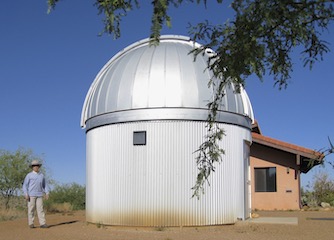
Above: at left is a roll-off-roof observatory of The Analemma Society of Great Falls, Virginia housing pedestals for telescopes, and other rooms (49,327 bytes).
At right is a 5-meter Ash Mfg. steel dome observatory, with a concrete and tile-roofed control building behind it. Then in Arizona, this is owned by the owner of Company Seven who relocated it later to Maryland (30,217 bytes).
The administrators of the private Lutheran Augustana College of Rock Island, Illinois had long expressed a desire to establish an astronomy program complemented by an observatory. Their first President of the college had expressed interest in establishing an astronomical observatory, even approaching the administration of Ecuador for permission to build the facility at the remote Galapagos Islands; that request was denied. However, years later an astronomy course was established at the college in 1884, but building an observatory would have to wait for Mr. Carl Gamble.
Mr. Carl Herbert Gamble (1879 - 25 January 1958) from Moline, Illinois, was a business man employed by the John Deere Company. When visiting Tucson, Arizona he looked up to the night sky from the roof of his hotel. With only a modest turn of the century binocular, he and a friend observed a greenish patch in the Orion constellation; even though he had never heard of it before, the Great Nebula (M42) made such an impression that he was set onto an entirely new hobby. After his return home he studied astronomy, observing by naked eye and with a modest telescope that had been loaned to him. As is not uncommon with astronomers, these nights out led to a case of Aperture Fever prompting him to neeeeed a larger, better telescope.
His next telescope would be a Carl Zeiss Jena 130 mm achromatic refractor, one with an alt-azimuth mount and stand with geared rising central column. Mr. Gamble acquired this telescope second-hand in 1929, at a cost of $275 or adjusted solely for inflation the equivalent to about $5,150 in 2025. When new this model of telescope was available from Carl Zeiss Jena with the customer choice of either the Carl Zeiss Jena E doublet achromat, AS doublet achromat, or the B triplet apochromat objective lens; this particular telescope incorporates Objective Serial No. 11343E, with focuser No. 9244. The set also includes a 30 mm Finderscope Serial No. 7138, Abbe Erecting Prism Serial No. 7049, Zenith Prism Serial No. 10308, and a Turret (rotating) ocular accessory Serial No. 7208. The complement of Carl Zeiss Jena eyepieces as of 1981, still in their fitted wood accessory case, were: 50 mm thread-on (39×), with 0.965" diameter 25 mm (78×), 12.5 mm (156×), 7 mm (279×), 5 mm (390×), and 4 mm (489×). Three filters were included.
Mr. Gamble invited friends and the public for observing sessions with his telescope. His presentations and observing sessions with the Carl Zeiss Jena 130 mm telescope, attracted and sustained so much interest that in 1936 the Popular Astronomy Club was established with about one hundred members. Mr. Gamble was its first President.
 In 1938 bought from Mr. Hamilton Maze a German Equatorial mount made by the former Alvan Clark & Sons Co. of Cambridgeport, Massachusetts. Mr. Gamble moved his Carl Zeiss Jena refractor optical tube assembly from the original manually operated Alt-Az mount onto the motorized German Equatorial mount, the telescope optical tube assembly retaining its original trunnion mounting bracket. Having the capability to automatically and precisely track celestial objects, and to find even more objects with the mount Setting Circles, dramatically improved the usefulness of the telescope. However, the German mount also brought more weight to carry out, and added complexity and time for set up.
In 1938 bought from Mr. Hamilton Maze a German Equatorial mount made by the former Alvan Clark & Sons Co. of Cambridgeport, Massachusetts. Mr. Gamble moved his Carl Zeiss Jena refractor optical tube assembly from the original manually operated Alt-Az mount onto the motorized German Equatorial mount, the telescope optical tube assembly retaining its original trunnion mounting bracket. Having the capability to automatically and precisely track celestial objects, and to find even more objects with the mount Setting Circles, dramatically improved the usefulness of the telescope. However, the German mount also brought more weight to carry out, and added complexity and time for set up.
To facilitate using the telescope, in 1941 Mr. Gamble built a personal observatory. The lower level rectangular block structure could accommodate a group meeting. While above it was a wood deck, with about a four-toot tall two section cylindrical riser supporting the approximately 15 foot diameter grain silo hemispherical dome. The dome was modified to rotate, and with an opening for the telescope to view from the horizon to zenith. He named this Sky Ridge Observatory.
Right: Carl Zeiss Jena 130 mm refractor telescope with Alvan Clark German Equatorial Mount installed in a Ash Mfg. dome at Augustana College.
This photo was taken by our mentor Nicholas Grossman during his visit in 1981, original at Company Seven's archives (32,396 bytes).
 Sky Ridge Observatory was still operational and serving as headquarters of Popular Astronomy Club when in January 1958 Dr. (Hon.C.) Carl H. Gamble died. Dr. Gamble's will bequeathed his telescope, observatory and library of astronomy publications to Augustana College. Sky Ridge Observatory continued operating there until a highway project required it be removed in 1966, this necessitated relocating the popular observatory. The astronomy club had persuaded the college Board of Trustees to establish a new planterium and had been working towards this when the need for the new observatory site came up. A site at Augustana College was selected, and funds to build both a planetarium with a 30 foot dome, and the observatory complex were raised from private donors, and with the John Deere Company being a most prominent donor. Ground was broken 19 June 1967, and on 2 May 1969 The John Deere Planetarium and Carl Gamble Observatory were dedicated. The project cost about $577,000 an amount that solely adjusted for inflation would amount to about $5,609,000 in 2025.
Sky Ridge Observatory was still operational and serving as headquarters of Popular Astronomy Club when in January 1958 Dr. (Hon.C.) Carl H. Gamble died. Dr. Gamble's will bequeathed his telescope, observatory and library of astronomy publications to Augustana College. Sky Ridge Observatory continued operating there until a highway project required it be removed in 1966, this necessitated relocating the popular observatory. The astronomy club had persuaded the college Board of Trustees to establish a new planterium and had been working towards this when the need for the new observatory site came up. A site at Augustana College was selected, and funds to build both a planetarium with a 30 foot dome, and the observatory complex were raised from private donors, and with the John Deere Company being a most prominent donor. Ground was broken 19 June 1967, and on 2 May 1969 The John Deere Planetarium and Carl Gamble Observatory were dedicated. The project cost about $577,000 an amount that solely adjusted for inflation would amount to about $5,609,000 in 2025.
Left: the Carl Zeiss Jena 130 mm refractor was among the motivators for the community to invest in constructing this impressive Carl Gamble Observatory of Augustana College.
This photo was taken by Nicholas Grossman during his visit in 1981, original at Company Seven's archives (32,396 bytes).
The original 130mm Zeiss refractor telescope Dr. Gamble willed to Augustana College was installed at the Carl Gamble Observatory. Twelve years later when we visited the telescope did not appear cosmetically in as good a condition was we might have hoped, but optically and mechanically it was performing well. Some years after then the refractor and its mount were retired, and stored. The refractor was replaced by a new Celestron C-14 Schmidt-Cassegrain, a catadioptric telescope supported by a computer controlled 'go to' German Equatorial mount. The planetarium remains the hub of the Popular Astronomy Club, while the Celestron telescope and others elsewhere the college can access remotely support the astronomy educational programs.
Dr. Gamble was buried at Riverside Cemetery in Moline, where his headstone is inscribed:
Multicoatings and Phase Correction Coatings: going back to the early years of World War II researchers at Bausch & Lomb were working to develop improved antireflection coatings. Soon after the war all major optical companies were applying the single layer magnesium fluoride coatings to their consumer optics, but even higher transmission and a capacity to optimize coatings for specific applications was sought. By the early 1950's multiple layer coatings for optics were developed that improved light throughput, resistance to ghosting, and overall contrast. By controlling the type of and thickness of element layers being deposited onto the glass surface then the coating laboratory could optimize the band pass of light to suit preferences: if birders prefer truer colors then a coating formula biased for that a more uniform transmission across the visible spectrum could be applied, if a photographic film camera lens was to be marketed for those who prefer black and white film to enhance contrast then a yellow-biased coating could be devised.
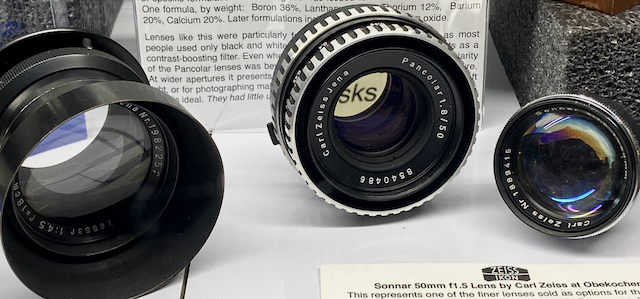
Multiple layer antireflection coatings (multi coatings) were developed early in the 1960’s that improved light throughput, resistance to ghosting, and overall contrast; Most were not as durable as Magnesium-Fluoride single coatings; Company Seven exhibits an early prototype Zeiss West German camera lens incorporating distinctive early multi coatings that could, with accidental abrasion or even with poor cleaning techniques, be removed. The first commercially successful multi coatings that were more durable consisted of three layers, introduced in 1965 these were termed Broadband and continue to be applied even today for some optics.
Right: Carl Zeiss photographic camera lenses exhibited at Company Seven include 1. an uncoated Carl Zeiss Jena Tessar 180mm f/4.5 of 1937, 2. Carl Zeiss Jena Pancolor 50mm f/1.48 of ~1967, known as 'Zebra Lens' owing to the metal trim, a raw glass made with Thorium radioactive metal provides the yellowish tinted lens, this is MgFl coated, and 3. incompleted Carl Zeiss (West German) Sonnar 50 mm f 1.5 lens with early multicoatings of ~1956, note this is not yet labeled with the red T (247,599 bytes).
Click on image to see enlarged view (1,766,530).
Some special purpose optics continued to be produced with lenses uncoated - with no antireflection coatings, these include the ultraviolet transmitting Carl Zeiss UV-SONNAR 105 f4.3 lenses made for Hasselblad cameras; hence they bear no T designation.
In 1972 Carl Zeiss of West Germany announced at Photokina in Cologne their improved multilayer antireflective coatings technology for lenses, filters, binoculars and other consumer optical products; these optics bear the T* designation, and resulted in a transmission of more than ninety (90) percent of the visible light entering a binocular for example.
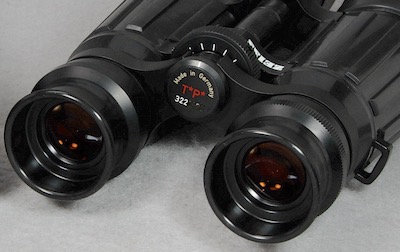
In 1988 Carl Zeiss West Germany introduced Phase Correction Coatings on all their production roof prism model binoculars. As light passes through glass, depending on type and arrangement it is possible that not all the wavelengths are transmitted uniformly; this results in a phase shifting of their position to either before, at, or beyond the focal plane. Phase Correction Coatings facilitate a more uniform throughput of light across a wide portion of the visual spectrum, thereby resulting in further improvements of resolution and contrast by systems incorporating roof prisms. The Carl Zeiss optics that feature this will bear the red T*P designation. Later this was changed for marketing purposes only, to T*P*; this later designation meant nothing about any change of performance.
Left: Carl Zeiss Germany 8x 56 B/GA Dialyt with the later T*P* roof prism binocular exhibited at Company Seven. Notice the “Made In Germany” labeling reveals this was produced by Carl Zeiss after the reunification of Germany in 1990 (34,262 bytes).
Click on image to see enlarged view showing the complete binocular view (176,153).
Incidentally, phase shift does not impact astronomical telescopes as we do not tend to employ components with roof prisms.
By the 21st century almost every new top-line optical product incorporated some version of these features, as applicable, so in 2015 Carl Zeiss phased out the use of the T* and T*P* labeling. Some of their products that had the coatings never bore the designation at all, such as their 20x 60S Stabilized Binocular, but as their newer series of sporting optics came were announced the coatings designations were deleted from product naming and labeling.
Marketing Philosophies, and Litigation:
In the early 1970’s tensions between the two firms between the two firms peaked, as they seemed to between East and West nations, with each of both Zeiss companies claiming the exclusive rights to the patents, trademarks and traditions of “Carl Zeiss”. This culminated in a series of legal battles around the globe, among these was one resolved in the U.S. Supreme Court granting rights to the name “Zeiss” solely to the West German Zeiss firm. As a result of court decisions and marketing agreements for products sold in the United States, the trademark “ZEISS” or “CARL ZEISS” appeared only on products manufactured by Carl Zeiss based in Oberkochen, West Germany.

Above: the bold logo of Zeiss West Germany products, employed from about 1972 until 1991.
Carl Zeiss Jena continued to rely on a far less sophisticated network of independent agents. Zeiss Jena maintained an office in New York City, with distribution of microscopes (and incidentally - planetarium instruments) through Seiler Instruments, a private company in St. Louis, Missouri. In North America their binoculars and microscopes were marketed as aus Jena products through Europtik Ltd., a company in Dunmore, Pennsylvania. Their surveying instruments including Theodolites were marketed through yet another firm in Florida. In terms of ownership these firms were completely independent of Carl Zeiss Jena, and of one another.
The director of Carl Zeiss West Germany was quoted in a “Wall Street Journal” newspaper interview as stating that western style marketing “simply doesn’t exist” in the east, “everything that is produced is dictated by the plan”. Yet by 1989 Carl Zeiss Jena was the largest of East Germany’s 120 state owned corporations (Kombinate). However, Zeiss employees in the east worked an average of six (6) more hours per week at less than half the salary of a western worker. The eastern technology was falling behind the west, now being relatively primitive and too inefficient to compete in a modern economy. While the western facilities were more automated, energy efficient, and more ecologically sound in terms of worker conditions and production of waste materials.
The value of the western currencies continued to figure prominently in what success the eastern products enjoyed in the west. In a few areas the west’s relatively higher labor costs and regulatory demands were also a handicap in competition against the east, although after the reunification Germany would begin exporting some manufacturing jobs (automobile manufacturing, etc.) to third world economies (such as the U.S.A.).
Carl Zeiss of West Germany continued to develop precise electro-optical equipment for distance and height measurements that found applications in sports events; their Recording Electronic Tachemeter measuring systems and their variants were used at international sports since 1970 events including the Olympic Games held in Munich in 1972 and those in Montreal in 1976.
In 1976 the West German Chancellor Schmidt presented the Carl Zeiss Oberkochen Mark IV Planetarium projector to the National Air and Space Museum “Einstein Planetarium” in Washington, D.C.. Among the invited guests were Ruth Van Hilst b. Bauersfeld daughter of the former head developer of Zeiss planetarium instruments. The Zeiss instrument remained one of the highlights at the most visited attraction in the United States.
Carl Zeiss West Germany continued to set the world standards for microscopy in many areas. In 1973 Zeiss West Germany announced the first high precision UMM 500 3D coordinate measuring machine. In 1976 Zeiss announced the first microscopes specifically designed for the examination of living cells, these were the IM 35 and ICM 405. In 1982 Carl Zeiss West Germany announced the world’s first LSM Laser Scan Microscope - the quantum leap in microscopy. And then in 1984 a new era in electron microscopy was introduced, the EM 902 with energy filter.
All the while Carl Zeiss Jena too continued to make innovative products including electro-optical equipment for distance and height measurements in sports events including the Olympic Games of Moscow in 1980, at Los Angeles in 1984, and at Seoul in 1988. Also developed was the “Cosmorama” computer controlled planetarium projector in 1984, and later the “Fundus” camera and their workstations for ophthalmology. The value of the western currencies continued to figure prominently in what success the eastern products enjoyed in the west.
All the while Carl Zeiss Jena continued to make innovative products including electro-optical equipment for distance and height measurements in sports events including the Olympic Games of Moscow in 1980, Los Angeles in 1984, and Seoul in 1988. Also developed was the “Cosmorama” computer controlled planetarium projector in 1984, and later the “Fundus” camera and their workstations for ophthalmology.
In 1979 a project commenced that would lead up to a 1985 landmark innovation in telescope lens technology. This his would bear a Carl Zeiss Jena trademark and be known as the “APQ”.
APQ Apo Telescopes:
In 1979 Dr. Jürgen Pudenz was optical designer at Carl Zeiss Jena, East Germany. He was assigned to the astronomical instruments division where he worked with Alfred Karnapp, both were amateur astronomers too. It was at the beginning of 1979 when they, Dr. Pudenz explained “received information from their colleagues in crystal growing that calcium fluoride disks of optically good quality were now available for large lenses diameter are available.” This prompted them to commence studies and development on what would eventually culminate in the APQ telescopes.
There were challenges beyond lens making to tackle. As mentioned previously, because the coefficient of expansion of Calcium Fluorite differs from that of conventional optical glass types, the large CF element needed for telescope lenses heretofore tended be air spaced arrangements. There were some prototypes made along the development path, and at least some were doublet AP f/10 air-spaced lenses of at least up to 130mm; these were flint-leading with the Calcium Fluorite being the inner element but their physical length and weight prompted the team to push further. The lens cell had to not only precisely hold the three lenses, but help the lenses compensate for temperature changes.
The final APQ design is a triplet arrangement with the Calcium Fluorite sandwiched between to other lenses. This required a new synthetic material to essentially oil the three lenses together, and this media was developed for Carl Zeiss Jena the University of Jena. The media had to accommodate temperature changes, and have long life. Another benefit was less light loss as coated or not, 'cemented' lenses lose nothing to reflections. The edges of the lens are sealed so this should not leak though Company Seven has seen this happen infrequently, this can be remedied. The same media was later adopted by others, most notably Astro-Physics Co. with which Zeiss Jena was developing a relationship with AP even providing custom Carl Zeiss Jena branded version of their 600E German Equatorial Mount.
The combined efforts at Jena in Calcium Fluorite manufacturing, research into lens design, research to develop the media, then refining large element fabrication techniques, resulted in the Carl Zeiss Jena APQ telescopes being developed by and credited to Dr. Jürgen Pudenz and Alfred Karnapp; the APQ was published in 1985 with the labeling derived from AP for Apochromat, and Q is a German acronym for liquid.
The APQ series telescopes that Carl Zeiss Jena offered for sale initially were:
- APQ 100/1000mm f/10
- APQ 130/1000mm f/7.8
- APQ 150/1200mm f/8
- APQ 105/640mm f/6.1
A few prototype APQ objectives were made in other apertures and focal lengths, possibly intended for use in compact astronomical telescopes being assembled at Jena, or in the large binoculars then being manufactured at a Carl Zeiss Jena VEB Eisfeld factory.
The APQ astronomical telescopes had some characteristics that made them less competitive to most who have experience with other telescope lines, not least of which were factors of cost and their weight. Their focus mechanism and accessory interchange system are cumbersome, and traditional wood crates were heavy. In the United States, Seiler Instruments represented Zeiss Jena Planetarium instruments, and they also marketed the APQ but did not gain much traction with sales.
However, the APQ simply ran out of time as these were coming onto the market just as the communist nations were transitioning to democracy. These transitions harshly impacted Carl Zeiss Jena resulting in gutting reductions of staff and production capacity. Their astronomical products production would suffer accordingly. It was not long after the fall of the Berlin Wall and reunification before representatives of Carl Zeiss West Germany, then based in Oberkochen, visited the traditional home of Zeiss to mull over what they might logically acquire or not of what was left in Jena. At its peak, Zeiss of East Germany employed about 200,000 employees; many of them would not be needed by the West German Zeiss company as they had developed their own manufacturing facilities. The Eisfeld binocular factory for example would be among those facilities not retained after the merger of the two Zeiss companies, so there went any potential need for APQ 80/500mm lenses. As the West was not manufacturing amateur oriented telescopes, some of the former Carl Zeiss Jena VEB astronomy department staff were retained when the two Carl Zeiss companies merged.
It was not until 1992 that we at Company Seven saw any signs of some stability there, of some efforts to salvage and produce enough to keep the former Jena astronomy section viable - and we were hopeful.
The Carl Zeiss Jena APQ telescopes were always comparatively expensive because of the real costs as well as the overhead expenses of being produced by such a large concern. In fairness though, these were a bargain when they originated in East Germany at a time of a nonconventional economy. But after the merger of the two Zeiss companies, and the need to compete in a western economy where 'sink or swim' is the rule, the costs of former East German made products dramatically increased. If the APQ were now to bear the trademark of a unified Carl Zeiss, a first-rate western concern, then they would be priced accordingly.
Martin at Company Seven analogized Zeiss's competitiveness in the amateur telescope market as:
these might cost one million dollars ($1,000,000.) each, but they would be fine bicycles.”
There was a window of time to gain feedback and refine the Zeiss Jena telescopes line. There were talks with others who were considering taking on distribution of Carl Zeiss Jena amateur oriented astronomical telescopes. Company Seven was in the loop, and we heard some fantastical prognostications originating from some optimists trying to get in with Zeiss with claims along the lines of “we can sell thousands of Zeiss telescopes because all those American doctors and researchers who learned on Zeiss microscopes will come flocking regardless of the telescope prices or competitiveness”. Company Seven was very well positioned to understand Apo demand and actual total sales in the USA, so we advised Zeiss Jena that some of those proposed marketing claims were simply nonsense. In February 1993 we met with the Manager of Carl Zeiss Jena's astronomical products production, and we provided some constructive feedback and considered the viability of the line in the US market.
The APQ telescopes were innovative in 1985 and were superbly crafted optically but owing to the effects of reunification, and changing priorities by Zeiss management their production would be discontinued in about 1997. A total of some 500 APQ lenses were produced including: 80 of the APQ 100/640mm, between 200 to 250 APQ 100/1000mm, 140 of the APQ 130/1000mm, and between 40 to 80 APQ 150/1200mm. There were some prototypes made in the APQ 80/500mm, rumored to be destined for the ASPECTEM binoculars, and 105/840mm too. The APQ 206/1665mm f/8 telescope that had been advertised were never produced before the astronomical telescope manufacturing group in Jena were decimated.
Right: Carl Zeiss Jena “ASPECTEM” 20 to 50x Vario (zoom) 80mm, assembled at the former Carl Zeiss Jena, V.E.B. factory. This was one of their very last large binoculars produced. Company Seven was a retailer of Carl Zeiss Jena when this arrived new about 1991, complete with lightweight fitted Case and a lightweight alloy Field Tripod with geared center column. This set was retired to permanent exhibit Company Seven's showroom collection, it is the third generation of Carl Zeiss Jena 80mm binoculars that we have (101,900 bytes).Click on image to see enlarged view (356,332 bytes).
Going back to 1901 Carl Zeiss Jena had developed and produced their first photogrammetric instruments. The line, including stereo comparators, had been improved and produced until the end of World War II. Their production was resumed in 1949, basically continuing to produce what had been made up to and during the war. By the 1960s more resources were devoted to improving and updating these products, most notably to take advantage of modern electronics. These were again updated and expanded in the 1980s through at least 1988 with particular attention to improved aerial photography culminating in their LMK 1000 Aerial Camera of 1986, and other instruments adding multi-spectral capabilities and improved navigation.
In 1984 Carl Zeiss Jena introduced photogrammetric cameras and associated instruments into production. In 1986 the Carl Zeiss Jena company had resumed production of photographic cameras.
In 1988 Zeiss Oberkochen announced the “P-Coatings” (invented by Adolf Weyauch); a “phase correcting coating” applied to a surface of roof prisms. This corrected the phase shifts as light passes through the system resulting in a sharper and clearer image. This and other innovations continued culminating with the introduction in 1990 of the “Design Selection” series of compact binoculars.
On 1 June 1990 the “ROSAT” X-ray satellite was launched from Cape Canaveral, Florida. At the time it featured the world’s smoothest mirrors ever made, and was the largest X-ray telescope ever produced (83.4cm aperture). It conducted the first X-ray survey of all the skies.
Carl Zeiss West Germany grew to become the world’s largest optics research and development firm with marketing organizations in at least 28 Western countries. It features state of the art microscopes, several of the world’s largest or most complicated telescopes, specialized scientific instruments, measuring instruments, military optics (including submarine periscopes), spectacle frames and lenses, rifle scopes, photographic lenses, cameras (“Contax” made under license by Yashica/Kyocera) and binoculars.
Later in 1990 Carl Zeiss of Oberkochen, West Germany, announced their new 20x 60 S - the world’s first hand-held, mechanically stabilized binocular; this too was invented by Adolf Weyauch. A more compact 20x 60 S monocular version followed. This is a Zeiss-developed and patented device based on cardanic prism suspension mechanism that works with precision magnets, so the user’s motions result in movements of the magnets thus generating an Eddy current that reacts to the magnetic field that created it thus dampening vibrations. This stabilizing mechanism requires no external power or battery. The mechanism is optical and mechanical, and is not dependent on electronics that would be prone to becoming obsolete - so decades after being introduced the 20x 60 S remains in demand, in production, and remains well supported should service or repair be necessary.
Left: the “business end” of a Carl Zeiss 20x 60S stabilized binocular, shown resting on it’s provided carry case at Company Seven.
This binocular remains unrivaled even well into the 21st century (40,060 bytes).
Click on image to see enlarged view (172,945 bytes).
The view is so steady that the observer has an impression they are holding a much lower magnification (about 4x) binocular, even while observing at 20x. A distant man who is barely recognizable can with the 20x 60 S be clearly seen to be drinking a “Krombacher” beer! Furthermore, it works whether one is observing a galaxy overhead or looking down into a canyon. With it’s two Zeiss 60 mm objective lenses the Andromeda Galaxy and Great Nebula in Orion are clearly defined, while the Moon is stunning. This is a superb choice for low light or long distance inspection, surveillance, astronomy, air traffic control, law enforcement and interdiction, or coast watching.
The 20x 60 S earned for Zeiss a “R&D Magazine” award for developing one of the one-hundred most important technical innovations of 1992. The stabilizing mechanism as built into the 20x 60 S, and a complete 20x 60 S binocular too, are exhibited at Company Seven.
Germany And Some Of Zeiss Reunified:
The German reunification of 1990 was symbolically realized with the literal collapse of the Berlin Wall, and the practical fall of Communism. But while the West German economy was robust, the East German economy was so stagnant that the transition has been turbulent and fraught with uncertainty for displaced workers. At the time of the reunification Carl Zeiss Oberkochen had a logical desire to acquire only the best technical and most historic assets of the East German Zeiss firm. Zeiss Oberkochen then had approximately 31,700 employees who were generating $2.18 billion in sales. Management at Oberkochen did not wish to acquire all the Carl Zeiss Jena liabilities (as most West German firms were hesitant to do) such as the staff and pension expenses for a grossly overstaffed (totaling about 70,000) and under productive (sales of about $390 million) work force. Furthermore, Oberkochen wished to avoid manufacturing and personnel redundancies, and so an initial merger plan was not accepted by management at the Carl Zeiss Jena firm.
Since shortly after World War II Zeiss Oberkochen products bore the trademark “ZEISS West Germany”. Within weeks after the reunification of 1990 new Zeiss letterhead and products bore the trademark “ZEISS Germany”.
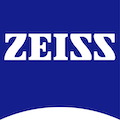
Above: logo of a unified Zeiss company for products made after 1991.
Initially the author of this article was happy at the thought of a reunited Germany, but my contacts with those in the East revealed a sense of foreboding. Soon after the first representatives from the former West Germany started to visit Jena it became clear they were there only to pick and choose what assets they might wish to acquire. A number of the employees then at Jena expressed their concern and some showed outright resentment. This may have had something to do with a feeling that the East had lost a war of sorts, or of one culture against another. Or more likely the fear of the apparently affluent westerners coming to determine the futures of their eastern neighbors.
Our own hopeful optimism turned to a sense of gloom and foreboding strikingly conveyed by the answer from one Zeiss Jena employee to the question:
to which came this reply from that Jena employee who was given to understatement:
“Oh yes, we see their Mercedes in the parking lot”.
When economic realities finally settled in at a now near bankrupt Carl Zeiss Jena (and other eastern manufacturers across a united Germany), negotiations were concluded by June of 1991 with Oberkochen to acquire only certain selected assets including the original facilities Jena. However, only a little more than 10% of Jena’s peak 70,000 person labor force of 1989 (down to about 27,000 in May 1991) would be incorporated into Zeiss Oberkochen. And even then contrary to optimistic plans, the remaining labor force would be reduced even further over the next few years.
For an example in July of 1991 the German privatization authorities concluded the purchase of the V.E.B. Carl Zeiss Jena binocular and riflescope manufacturing works at Eisfeld by Docter-Optic GmbH of Wetzlar, effective 1 August 1991 the factory resumed operations with 550 employees as Docter-Optic-Eisfeld GmbH. The Eisfeld facility was not acquired by Carl Zeiss Oberkochen as the manufacturing techniques there were considered primitive and inefficient by modern West German standards. Zeiss Oberkochen already operated sporting optics manufacturing at a more efficient plant in Wetzlar. It could be argued that Zeiss Oberkochen lost an opportunity to retain some of the best Porro prism designs made such as the Zeiss Jena “Nobilem”. The passing of Eisfeld ended a Zeiss tradition of almost 100 years of making 80mm large binoculars, the last being the “Aspectem” of a relatively new design of which maybe 100 to 200 units were made. One new Carl Zeiss Jena “Aspectem” 25x to 50x Zoom 80mm binocular with tripod and case was retired for exhibit at Company Seven’s museum, though possibly the best 80mm ever offered by Zeiss there was still potential remaining for improvements. Zeiss Oberkochen passed on other innovations produced by notable Jena employees including Dr. August Sonnefeld.
Part of the Eisfeld facilities continued with the development and growth of synthetic crystals to support its own products. One of the most important products for the advanced amateur and institutional astronomy markets to come of this was the growth of high quality Calcium Fluoride (CaF2) crystals from Stockbarger melts which made possible the “APQ” Apochromatic objectives that Jena offered for sale in 105mm, 130mm and 150mm apertures though some other prototypes were built.
Since the reunification, the groups involved with research and development, and the growth of synthetic crystals and fluorides, and marketing have been incorporated in Eisenberg plant (established near Jena in 1961) as part of the “Optics Division”. Although a large marketing force for other Zeiss groups including consumer optics remains at Aalen. The groups from Oberkochen and Jena involved in the design and manufacture of precise height and distance measuring devices such as those employed at Olympic Games continue under the name “Zeiss Optics”.
Those remaining in the group at the Jena works who were involved in production of astronomical telescopes was retained there in Jena, while the planetarium production team at Oberkochen was moved to and incorporated with existing Jena facilities. The production of large observatory telescopes continued at Jena with the first joint Zeiss telescope project being a contact signed in November of 1991 to produce a 1 meter telescope (the 13th instrument of the design made at Jena since the first one made in 1971) with control system and a 12.5 meter dome for the European Space Agency. The Carl Zeiss Jena GmbH Division of Astronomical Instruments worked with the Carl Zeiss, Oberkochen APS Division.
Although the production of relatively small achromatic and apochromatic refractor telescopes of up to 15cm, and catadioptric systems of up to 18cm, all with a variety of accessories at Jena would continue formally until 1995 when it was realized that Zeiss could not compete in the world market. The Zeiss “APQ” refractor telescopes optics were among the finest in the world but the inability to Zeiss to adapt these products promptly to compete among the realities of a free marketplace assured their demise, and the last of these were completed about 1997.
In mid April of 1992 at the “Opto 92” European optoelectrics symposium in Paris, the optical metrology departments of Carl Zeiss, Oberkochen and Carl Zeiss Jena displayed their products as a unified Zeiss for the first time. Also in 1992 the publication “Zeiss Information” and the “Jena Review” were combined to produce the publication: “Zeiss Information with Jena Review” bearing the copyright logo and “Carl Zeiss, Oberkochen, and Carl Zeiss Jena, GmbH, Jena”. Also in 1992 the “Reta-Sport A” measuring instruments was announced brining in a new generation of distance measuring instruments geared especially to sporting events such as those held at the Olympic Games.
In the meantime, research and development continued to show results. In 1994 Zeiss announced navigated microsurgery with MKM which permits more accurate and gentler brain surgery with an “electronic pilot”. In 1994 Zeiss also announced the “Night Owl” series binoculars in 7x45B, 8x56B, and 10x56B. These represented a new level of technological achievement. Featuring wider angle views than predecessors, a new “super achromatic” objective lens, “Phase Corrected” Abbe-König prisms, light transmission of at least 91%, and nitrogen filled composite housings reinforced with fiberglass to assure high endurance. In September 1994 Zeiss announced the first “Contax” 35mm rangefinder camera with interchangeable lenses made since 1959; the “G1” features include auto focus with any of four optional lenses, TTL metering, automatic film advance of up to 2 frames per ssecond, and a luxurious titanium body.
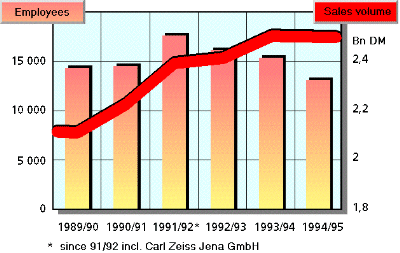
Zeiss Sales Volume and Employees Worldwide Trend from 1989/90 to 1994/95
For 1995, the tradition of innovation continued with the introduction by Zeiss of the “Axiophot 2”, the world’s first computer controlled photomicroscope.
On 18 October 1989 the NASA space probe “Galileo” was launched aboard the Space Shuttle Atlantis. Galileo reached Jupiter on 7 December 1995, and then dispatched a probe into Jupiter’s atmosphere. The “Helium Abundance Detector” interferometer on the probe was manufactred by Carl Zeiss at Oberkochen. During the 75 minute descent this problem instrument also contributed to the success of the effort. Delivered by Zeiss in 1984, this was the first instrument in space made by Zeiss at Oberkochen, and was then the farthest that a Zeiss component had traveled from Earth.
 In May 1995 the high-tech companies Leica in St. Gallen (Switzerland), and Carl Zeiss in Oberkochen (Germany) signed a letter of intent to pool their electron microscopy resources in an independent joint venture. The focus of the new company is the onward development, manufacture, sales and service of scanning and transmission electron microscopes.
In May 1995 the high-tech companies Leica in St. Gallen (Switzerland), and Carl Zeiss in Oberkochen (Germany) signed a letter of intent to pool their electron microscopy resources in an independent joint venture. The focus of the new company is the onward development, manufacture, sales and service of scanning and transmission electron microscopes.
The shareholders’ agreement for the founding of the new joint venture “LEO Electron Microscopy Ltd.” (LEO) was formally signed on September 12, 1995, ahead of the originally envisaged schedule. LEO officially commenced trading on October 2, 1995 following the approval of the German antitrust authorities (Bundeskartellamt, Berlin). The contract incorporating the new company was signed at the German Society of Electron Microscopy annual meeting in Leipzig by the CEOs of the parties, Dr. Peter Grassmann (Carl Zeiss) and Dr. Markus Rauh (Leica). A parallel announcement of the founding of the new company was made at the EMAG conference held at the University of Birmingham.
Leica and Carl Zeiss each hold a 50% share in LEO, with operating subsidiaries in the UK, Germany, France and the USA. Dr. Peter Grassmann, CEO Carl Zeiss was nominated Chairman of the Board of the new company; Raghuvir Kalbag, a UK national, Chief Executive Officer. R. Kalbag comes to the company from the international headquarters of Leica in St. Gallen where he is a Member of the Corporate Management, and brings with him experience in the field of electron microscopy going back to 1976. They were supported by a management team drawn primarily from Carl Zeiss and Leica. Worldwide representation is provided through the existing Leica and Carl Zeiss sales channels and a network of independent dealers.
The existing facilities in Cambridge and Oberkochen for R&D, production, marketing and service of electron microscopes would be carried over into the new company. This decision maintains the long history of expertise and knowledge in transmission and scanning electron microscopes in the two sites where these technologies were pioneered. It was envisaged that LEO will employ about 350 people world-wide, including those in the distribution and service networks, with a turnover of over 50 million pounds sterling.
Carl Zeiss dissolved their amateur telescope division located at Jena in the Fall of 1995.
By 1996 Carl Zeiss indicated an organization of five groups: Microscopy, Medical Systems, Consumer Optics, Industrial Metrology, and Opto-electronic Systems.
In 1996 Zeiss announced new lens systems for semiconductor production to permit future fabrication of 256 megabyte DRAM memory chips, and the “SILEX” experiment with Zeiss telescopes for the testing of optical telecommunication in space.
A number of events and products commemorate the 150th anniversary of the Carl-Zeiss-Stiftung (Carl Zeiss, Oberkochen and Schott Glasswerke, Mainz). Several of these events were noted at our “Current Zeiss News” Internet Site page. Also, Carl Zeiss announced a limited edition binocular specially produced to commemorate the 150th anniversary. The binocular chosen is possibly the most successful, and popular of the Zeiss Dialyt series. Only 1,000 Zeiss 10 x 40 B ClassiC Gold binoculars will be made. Finished in the finest grade of Nappa Leather in brown, with the serialized current ZEISS logo in 18 carat gold, the eyepiece and objective rings in 18 carat gold plate, in a deluxe brown leather case with snap closure, and a personalized wood presentation box bearing the owners name for $3,395.00.
With the high living and salary standards of the West German economy, and the pressures on that economy to subsidize and modernize the former East Germany, and need to meet the competition from abroad (most notably from Japan, and the United States), there has never been so many challenges to the once dominant Carl Zeiss firm. In fact 1996 finally showed a profit for the unified Zeiss thereby indicating a good measure of recovery from the impact of unification.
In April of 1997 the Astro-Physics Company, Baader Planetarium, and Company Seven announced the availability of a limited quantity of new production Carl Zeiss “Abbe Orthoscopic” oculars for astronomical telescopes. This marked the first production of such accessories since when Carl Zeiss dissolved their amateur telescope division in the Fall of 1995.
There is little doubt that Zeiss will continue their traditions of excellence and innovation. Today the Carl Zeiss trademark remains a symbol of traditional values and innovation in optics technology.
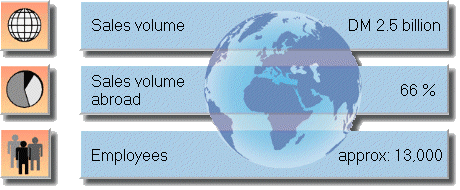
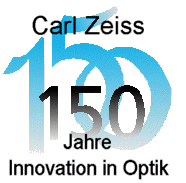

Above: Anniversary Logo, and Zeiss logo employed since about year 2000.
Summary Of Zeiss Trademarks: below is a collection of logos from articles and literature in the collection of Company Seven. These are the major logos and trade names that identified the companies, or some subsidiaries. This is not including all trade names (Contax, Contessa, etc.) or variants of the main trademark (Carl Zeiss London, etc.) that Zeiss companies employed. Those we include are, from top to bottom:
- our earliest example of the trade name “C Zeiss Jena” stamped on Zeiss products
- trade name “Carl Zeiss, Jena D.R.P.” as employed late in the 1800’s
- classic trademark featuring the Carl Zeiss Jena names in a doublet lens, this registered in 1904
- Zeiss Ikon trademark of 1926
- Zeiss AEG trademark of 1941
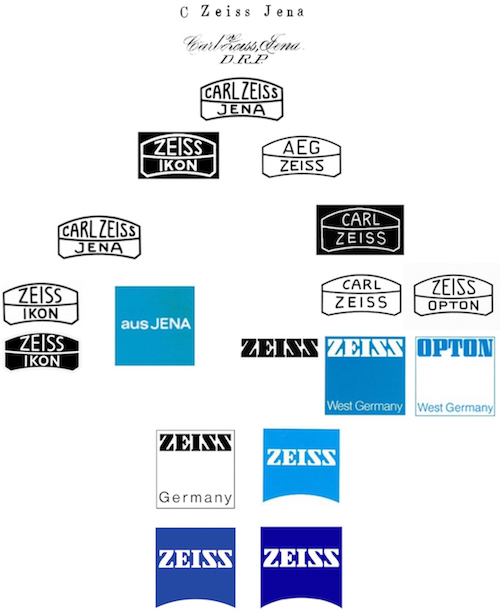
The author of this article (Martin Cohen of Company Seven) can not accept credit for much more than compiling the information in this paper, as credit for the content actually better placed with a variety of sources of knowledge and enthusiasm. Among these are the contributors to the Zeiss Historica Society journal (most notably by Larry Gubas, Nicholas Grossman, Wolfgang Pfeiffer, William Stone, Joachim Arnz, Charles Barringer, Thomas Schreiner, Maurice Zubatkin, Hans-Jurgen-Kuc, and many other fine authors) and other publications geared to enthusiasts and historians, U.S. military records, and ultimately to the current and former employees of the Carl Zeiss organizations including Dr. Wolfgang Wimmer the Director of Carl Zeiss Archives, Lucas VanHilst, and their families.
Corrections or additions are invited. The writer also wishes to clarify that this by no means a comprehensive discussion, and that many individuals deserving credit for innovation and administrative accomplishments at Zeiss are worthy of mention.
Contents Copyright ©1994-2025 Company Seven, and contributors - All Rights Reserved


